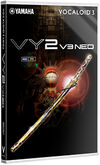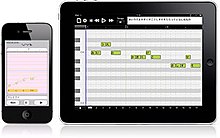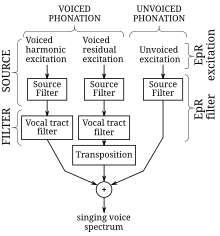#Программа #Vocaloid изначально создавалась для синтеза пения и использует предварительно #записанные слоги (как правило пара звуков согласный-гласный) для формирования #поющего #голоса. #Звуки проходят сложную #обработку — изменяются по #высоте #тона, чтобы образовать #мелодию, искажаются или обрабатываются #фильтрами, чтобы придать пению чувственность, хрипоту или использовать другие #эффекты.
В общем если вы хотите чтобы в вашем треке кто-то пел, то этот плагин отлично справится с данной задачей! При работе с программой пользователь вводит мелодию нового произведения, указывает для каждой ноты соответствующую фонему текста песни, после чего Vocaloid, используя выбранную библиотеку исполнителя, синтезирует пение. Предусмотрена возможность изменения тембра, скорости, частот, наложения различных эффектов.
Программа состоит из двух частей:
—Vocaloid Editor — редактор для работы с текстом и мелодией, собственно интерфейс программы в котором можно создать мелодию и использовать те или иные эффекты. Эта тема настолько обширна, что требует отдельной статьи. Подробнее о Vocaloid Editor (статья готовится)
—Голосовые банки — это набор звуковых сэмплов того или иного актера озвучки, на основании которого и происходит сам синтез пения. В зависимости от актера голос может быть мужским, женским, и мужским и женским (Рин и Лен Кагамине), даже детским (Каай Юки).
Актер может записать несколько голосовых банков, различающихся по стилю или языку (Мику Хатсуне например, имеет японский и английский звуковые банки, причем японских банков несколько, в зависимочти от требуемого стиля исполнения).
Стоит добавить, что саму программу разработала фирма Yamaha, а вот выпуском голосовых банков занимаются разные компании, в том числе японская Crypton. Тем не менее все голосовые банки совместимы с Vocaloid Editor
Вокалоиды как персонажи
Первые голосовые банки появились в 2004 году, 3 марта английские мужскиой и женский от фирмы Zero-G, а 5 ноября японский женский от Crypton Future Media, которые получили имена Леон, Лола и Мейко соответственно.
Причем, если на упаковках от Zero-G были просто изображены губы, то на упаковке с банком Мейко была изображена красивая девушка в аниме стиле с коричневыми волосами, которая считалась официальным персонажем, соответствующим данному голосу. С этого момента стало традицией давать каждому голосу имя, изображение, иногда даже биографию… Называть эти персонажи cтали вокалоидами.
На настоящий момент существует более 80 вокалоидов, поющих на японском, английском, корейском, китайском, испанскои и португальском языках…
Однозначно, самый популярный вокалоид — Мику Хатсуне, который всерьез конкурирует с живыми исполнителями (по крайней мере в своей родной Японии).
При всем этом, не стоит забывать, что вокалоиды — прежде всего инструменты в руках талантливых (и не очень) композиторов.
Вокалоиды на русском
К сожалению, на настоящий момент нет данных, что работы в этом направлении ведутся, что обусловлено двумя основными причинами.
-Вокалоиды в России не столь популярны и вряд ли здесь будут финансировать довольно дорогой проект без надежды окупить расходы.
- Русский язык довольно сложен для синтеза, учитывая структуру при котором возможно сочетание до 5 согласных подряд, что крайне осложняет техническую реализацию проекта.
Но все не так безрадостно. Технологии развиваются и дешевеют, возможно и в России появится группа энтузиастов, которая возьмется за реализацию сложного, но очень интересного в техническом плане проекта.
Пример работы виртуального вокала
Сейчас в магазине zero-g проходит летняя распродажа. Акция на все вокалоиды, они идут со скидкой в 40%.
В этой статье мы перечислим ВСЕХ существующих вокалоидов на данный момент, а так же упомянем претендентов, на звание вокалоида, но по тем или иным причинам не получившим его (Требования разработчика движка Vocaloid, корпорации YAMAHA, очень суровы), отметим замороженные вокалоид-проекты, а так же заглянем в мир персональных вокалоидов, сделанных на заказ и никогда не представляемых широкой публике.
Кроме того многие компании указывают для вокалоидов рекомендуемые жанры и параметры для их же лучшей настройки.
Если вы не очень понимаете о чем будет идти речь — загляните в справочную статью О вокалоидах и Vocaloid. Остальные — вперед!
Структура списка вокалоидов.
Все вокалоиды разделены по версиям движка Vocaloid (на настоящий момент существует четыре версии) и расположены в порядке появления.
ВНИМАНИЕ! В статье описаны абсолютно все вокалоиды 1-2 версий.
Вокалоиды на 3-м движке находятся в другой специальной статье Вокалоиды V3.
Вокалоиды на 4-м движке тоже находятся в другой специальной статье, Вокалоиды V4,
Так как недавно вышел 5-ый движок, то вокалоиды уже на этом движке будут находится в еще одной отдельной статье Вокалоиды V5,
чтобы постоянно дополнять ее актуальным материалом.
Вокалоиды V1
LEON (Леон)
Leon — самый первый выпущенный мужской вокалоид, поющий на английском языке. Выпущен 15 января 2004 года и 3 марта 2004 года (для Японии) компанией Zero-G (Англия).
(LEON — Get Lucky)
Неизвестно кто его сейю до сих пор.
На самом деле также неизвестно , почему выбрали это имя , но некоторые полагают , что :
«Леон» — это имя латинского происхождения и используется в ряде стран Европы как изменение названия «Лео» , что означает «Лев».
Официальный маскот Леона — изображение губ на бокс-арте.
Фотограф – неизвестен.
Так же есть очень прижившийся фанатский маскот Леона. Но это не значит, что вы должны видеть его именно таким, у каждого человека своё восприятие.
LOLA (Лола)
Lola — cамый первый выпущенный женский вокалоид, поющий на английском языке. Выпущена 15 января 2004 года и 3 марта 2004 года (Для Японии) компанией Zero-G (Англия).
(LOLA — Fireflies)
Неизвестно кто её сейю до сих пор.
На самом деле также неизвестно , почему выбрали это имя , но некоторые полагают , что :
«Лола» — является испанским и английским именем и может быть использован как для мальчиков и девочек. Женское имя , происхождит от имени «Долорес» и означает » Печаль».
Официальный маскот Лолы — изображение губ на бокс-арте.
Фотограф – неизвестен.
Так же есть очень прижившийся фанатский маскот Лолы. Но это не значит, что вы должны видеть её именно такой, у каждого человека своё восприятие.
MIRIAM (Мириам)
Miriam — второй выпущенный женский вокалоид, поющий на английском языке. Выпущена 1 июля 2004 года и 26 июля 2004 года (Для Японии) компанией Zero-G (Англия).
(Miriam — Stronger Than You)
Сейю — Miriam Stockley
Имя вокалоида – Мириам взято из имени сейю.
На бокс-арте нарисована сама сейю , но так как бокс-арт видно не полностью, то вокалоида чаще всего по разному изображают фанаты.
Иллюстратор бокс арта — Simon Fowler
Как иногда изображают фанаты Мириам фото смотри ниже
MEIKO (Мейко)
Meiko — третий вышедший женский вокалоид и самый первый женский вокалоид, поющий на японском языке. Выпущена 4 ноября 2004 года компанией Yamaha и Crypton (Япония).
(MEIKO — Silent Snow)
Сейю — Meiko Haigo
Отсюда и имя вокалоида – Мейко. Официальной фамилии у Мейко НЕТ.
Есть официальный маскот (картинка сверху). Иллюстратор — Wasshi.
KAITO (Кайто)
Kaito — второй вышедший мужской вокалоид и самый первый мужской вокалоид поющий на японском языке. Выпущен 14 февраля 2006 года и 17 февраля 2006 года (анонсирован 14 февраля ¯_(ツ)_/¯) компанией Yamaha и Crypton (Япония).
(KurousaP feat. KAITO — Cantarella)
Сейю — Naoto Fuuga
Имя “KAITO” было выбрано общественностью. Еще одна из причин, почему имя «KAITO» было выбрано — потому что оно будет легко произносится для не-японского языка и это выглядело уместно с именем «MEIKO».
Официальной фамилии у Кайто НЕТ.
Есть официальный маскот (фото слева). Иллюстратор – Takashi Kawasaki.
Более подробно в статье О вокалоиде Кайто
Вокалоиды V2
SWEET ANN (Свит Анн)
Sweet Ann -первый вокалоид выпущенный на V2 движке и поющий на английском. Выпущена 29 июня 2007 года, 31 сентября 2007 года (для Японии) и 7 сентября 2011 (для Тайваня) компанией PowerFX (Швеция).
(Sweet Ann — Set Fire to the Rain)
Сейю – Некая “Jody” , но кто конкретно, неизвестно до сих пор.
Происхождение имени “ Sweet Ann” неизвестно.
Есть официальный маскот. Возможно это отсылка к фильму про Франкенштейна. Иллюстратор неизвестен.
Кроме того , есть официальный тайваньский бокс арт фото внизу. Иллюстратор – Vofan.
И еще у неё указан её возраст для тайваньского бокс-арта – 23 года, рост – 162 см и вес – 46 кг.
Рекомендуемые жанры — Кантри, Классический Рок, Lyrical Nostalgia.
Рекомендуемые параметры — Темп: 65 – 155 BPM, Ранг (Ноты): C3 — C5
HATSUNE MIKU (Хатсуне Мику)
Hatsune Miku — вокалоид на V2 движке и самый первый вокалоид поющий на V2 движке на японском языке. Выпущена 31 августа 2007 года компанией Crypton (Япония).
Сейю — Saki Fujita
Имя было выбрано не случайно. Оно было выбрано путем объединения Hatsu (初, первый), Ne (音, звук), и Мику (ミク, будущее), таким образом, оно означает «первый звук из будущего.»
Есть официальный маскот. Цифра 01 – означает «Character Voice 01». Иллюстратор – KEI.
Кроме того у неё указан её возраст – 16 лет, рост – 158 см и вес — 42 кг.
Более подробно про неё написано в статье Все о Мику Хатсуне
Рекомендуемые жанры – Поп, Рок, Dance.
Рекомендуемые параметры — Темп: 70 – 150 BPM, Ранг (Ноты): A3 — E5
Kagamine Rin & Len Act 1 (Кагамине Рин и Лен)
Rin и Len Kagamine — вокалоиды на V2 движке, поющие на японском языке. Выпущены 27 декабря 2007 года компанией Crypton (Япония).
Сейю — Asami Shimoda — //youtu.be/RDH-guAH-0w
Многие думают, что эти 2 вокалоида на самом деле близнецы. Но ЭТО НЕ ТАК. Уже во время разработки этих 2 воков в Криптон решили что не будут делать их близнецами.
Изначально разработчики собирались сделать два голоса — девушки и ее зеркальное отражение противоположного пола.
Происхождения имен Рин и Лен следующее — когда Kagamine были записаны в 2007 году, их имена для них все еще не были выбраны. Их имена — Рин и Лен по одной версии были взяты, основываясь на словах «право» и «лево».
Чуть позже сама Асами Шимода подтвердила в интервью, что имена были выбраны на основе имен Кен и Рин из Hokuto no Ken.
Их же фамилия была получена из объединения Kagami (鏡, зеркало) и Ne (音, звук).
Есть официальный маскот.
Цифра 02 – означает «Character Voice 02». Иллюстратор – KEI.
Кроме того для них указан возраст – 14 лет, рост у Лена – 156 см, у Рин – 152 см, и вес у Лена — 47 кг, у Рин – 43 кг.
Рекомендуемые жанры – Электро поп, Поп, Рок, Enka.
Рекомендуемые параметры — Темп: 85 – 175 BPM, Ранг (Ноты): F#3 — C#5
PRIMA (Прима)
Prima — вокалоид на V2 движке, поющий на английском языке и самый первый вокалоид с оперным голосом. Выпущена 14 января 2008 года, 22 февраля 2008 года (для Японии) и 7 сентября 2011 года (для Тайваня) компанией Zero-G (Англия).
Неизвестно кто её сейю до сих пор.
Имя «Prima» происходит от термина «Prima Donna», что означает «первая леди». Это итальянский термин, используемый для обозначения женщин с ведущей ролью в театральной и оперной продукции. Это относится также к сопрано.
Официальное изображение Примы — лицо девушки на бокс-арте (Иллюстратор — bg_knight).
Кроме того , есть официальный тайваньский бокс артфото снизу. Иллюстратор – Loiza.
И еще у неё указан её возраст для тайваньского бокс-арта – 18 лет, рост – 156 см и вес – 42 кг.
Рекомендуемые жанры – Опера, New Age. Рекомендуемые параметры — Темп: 75 – 160 BPM, Ранг (Ноты): Eb3 — E5
Kagamine Rin & Len Act 2 (Кагамине Рин и Лен)
Вскоре вышло обновление вокалоидов Рин и Лен до Act 2 , все так же поющих на японсом языке. Выпущены 18 июля 2008 года компанией Crypton (Япония).
Сейю — Asami Shimoda (какая и была) — //youtu.be/x0L5G3GEqhw
Войсбанки были выпущены в скором времени из-за глобальной доработки.
Crypton извинился за плохое качество исходного продукта и обещали произвести более качественную версию.
Их возраст, рост и вес остались прежними. Так же как и рекомендуемые жанры и параметры.
Бокс-арт остался прежним, но был немного изменен. Иллюстратор – KEI
KAMUI GAKUPO (Камуи Гакупо или Гакпоид)
Kamui Gakupo — вокалоид на V2 движке поющий на японском языке. Выпущен 31 июля 2008 года компанией Internet Co (Япония).
Сейю – GACKT — //youtu.be/-9GBKvfOhvQ
Имя «Gakupo» основан на произнесении имени «Gackt».
Название программного обеспечения «Gackpoid» также берет свое название от Гакт.»POID» на конце имени это сокращение от «как VOCALOID». Следовательно, полное название этого продукта подразумевает «Гакт как VOCALOID».
Тем не менее, написание его имени латиницей может изменяться. Например, на сайте KarenT, его имя также часто можно увидеть написанным как «Kamui Gakuposic».
Есть официальный маскот. Иллюстратор – Kentaro Miura.
Рекомендуемые параметры — Темп: 60 – 150 BPM, Ранг (Ноты): A1 — C4 (Бас)
MEGURINE LUKA (Мегурине Лука)
Megurine Luka — вокалоид на V2 движке впервые поющий и на японском и на английском языках. Выпущена 30 января 2009 года компанией Crypton (Япония).
Её фамилия сочетает Meguri (巡, распространить или вокруг) и Ne (音, звук), в то время как имя Лука вызывает японские » рю » (流, поток) и «ка» (歌, песни) или «ка» (香 , запах), что обозначает: «песни распространяются по всему миру, как запахи (или ароматы).»
По поводу слога “Ryu” — у японцев нет “L” и произносят они “R” очень близкое одновременно и к “L” и к “R”. Поэтому везде верно написано – Luka.
Есть официальный маскот. Иллюстратор – KEI.
У неё указан возраст – 20 лет, рост – 162 см и вес – 45 кг.
Рекомендуемые жанры – Латино, Джаз, Электро поп , Электроника, House, Dance.
Рекомендуемые параметры — Темп: 65 – 145 BPM, Ранг (Ноты): D3 — D5
GUMI MEGPOID (Гуми Мегпоид)
Gumi Megpoid — вокалоид на V2 движке, поющий на японском языке. Выпущена 26 июня 2009 года компанией Internet Co (Япония).
Сейю – Megumi Nakajima — //youtu.be/Y11ksrZZN5Y
Имя Гуми было взято из детского прозвища сейю Мегуми Накадзимы.
Фамилия «Megpoid«, была взята из имени провайдера «Мегуми». Вторая часть созвучна окончанию слова вокалоид, таким образом значение фамилии получается таким — «Мегуми, как Вокалоид.»
Рекомендуемые параметры — Темп: 60 – 175 BPM, Ранг (Ноты): F2 – A4 (Меццо-сопрано)
Есть официальный маскот. Иллюстратор – Masami Yuuki.
SONIKA (Соника)
Sonika — вокалоид на V2 движке поющий на английском языке. Выпущена 14 июля 2009 года, 7 августа 2007 (для Японии) и 7 сентября 2011 года (для Тайваня) компанией Zero-G (Англия).
Неизвестно кто её сейю до сих пор.
Возможно ее имя «Соника» взято из хинди, где это слово означает «золотая красота», или, скорее всего выбран из-за сходства с «sonic» (“звук”).
Внешность по информации из твиттера следующая — цвет волос может менять цвет (например — с зеленого на красный), также она имеет веснушки, которые появляются в летнюю жару.
Татуировка на левом боку -это ее имя написанное катаканой -«ソニカ».
Есть официальный маскот – арт в стиле сверх-реализма. Но в твиттере отмечалось, что её внешность может меняться.
У неё указан её возраст– 17 лет, рост – 167 см и вес – 58 кг.
Кроме того у неё есть еще тайваньский маскотфото внизу, который повторяет официальный арт, но в стиле манга (или аля аниме, как более привычно для многих).
Так же для неё указаны данные именно для тайваньского бокс-арта: возраст – 17 лет, рост – 160 см и вес – 45 кг.
Рекомендуемые жанры – Поп , Электроника, House-dance.
Рекомендуемые параметры — Темп: 75 – 160 BPM, Ранг (Ноты): G3 — D5 (Меццо-сопрано)
SF-A2 MIKI (Мики)
SF-A2 Miki — вокалоид на V2 движке поющий на японском языке. Выпущена 4 декабря 2009 года компанией AH-Software (Япония).
Сейю – Miki Furukawa — //youtu.be/FZZkq5m2nrQ
Имя «Мики» происходит от имени ее провайдера «Мики Фурукава».. Смысл кода — “SF-A2” до сих пор неизвестен.
Есть официальный маскот , вид которого подразумевался как “кибернетический” , а в каждой иллюстрации присутствует характерная звезда. Иллюстратор – Yusuke Kozaki.
Рекомендуемые параметры — Темп: 70 – 170 BPM, Ранг (Ноты): E2 – G4
HIYAMA KIYOTERU (Хияма Кийотеру)
Hiyama Kiyoteru — вокалоид на V2 движке поющий на японском языке. Выпущен 4 декабря 2009 года компанией AH-Software (Япония)
Сейю – Kiyoshi Hiyama — //youtu.be/mgOMvXezvnk
Он и Kaai Yuki были выпущены как «ученик/студент» и «учитель».
Фамилия «Хияма», была взята из имени его сейю («Киёши Хияма»), а имя было взято с игры слов «Ледникового Теру» — «Хияма,» (氷山) означает “Ледяная гора”.
У него указан его возраст – 22 года, рост – 176 см и вес – 59 кг.
Есть официальный маскот. Иллюстратор – Umetani Ataro.
Рекомендуемые параметры — Темп: 60 – 160 BPM, Ранг (Ноты): C2 – G3
KAAI YUKI (Каай Юки)
Kaai Yuki — вокалоид на V2 движке поющий на японском языке. Выпущена 4 декабря 2009 года компанией AH-Software (Япония).
Неизвестно, кто её сейю до сих пор.
Она и Hiyama Kiyoteru были выпущены как «ученик/студент» и «учитель». То есть Юки изображается как 9-летняя ученица/студентка начальной школы.
Её имя — «歌 愛», означает «песня» и «любовь», соответственно. Почему же ей дали такую фамилию – неизвестно.
У неё указан её возраст – 9 лет, рост – “высокий, как 10 больших яблок” и вес – “ тяжелый, как 86 яблок”.
Есть официальный маскот. Иллюстратор – Umetani Ataro.
Рекомендуемые параметры — Темп: 50 – 150 BPM, Ранг (Ноты): F2 – C4
.
BIG-AL (Биг Ал)
Big-Al — вокалоид на V2 движке поющий на английском языке. Выпущен 22 декабря 2009 года, 3 марта 2010 года (для Японии) и 7 сентября 2011 года (для Тайвани) компанией PowerFX (Швеция).
Сначала в качестве голосового актера заявлялся Michael King , затем некий актер Frank S. в последствии упоминался «известный шведский рок-вокалист».
Неизвестно, почему PowerFX выбрали имя «Big Al».
«Al» может быть как мужское и женское имя. Это, как правило, сокращение для других длинных имен.
Изначальный иллюстратор Big AL остается неизвестным, но вспоследствии изображение было пересмотрено и была выбрана иллюстрация художника Ash. В обоих воплощенях он отсылался к монстру – Франкенштейну.
У него указан возраст – 25 лет, рост – 193 см и вес – 86 кг.
Есть официальный маскот. Иллюстратор – Ash
Кроме того у него есть еще тайваньский маскотфото по внизу который сделан с такой же внешностью, но в более анимешном стиле.
Для тайваньского релиза так же указаны другие возраст; 21 год, рост – 185 см и вес – 73 кг.
Рекомендуемые жанры – Электроника, Классический рок, Кантри, Блюз. Рекомендуемые параметры — Темп: 79 – 145 BPM, Ранг (Ноты): G1 – D3
HATSUNE MIKU APPEND (Хатсуне Мику)
В начале 2010 года Crypton объявила о следующем проекте с Мику Хатсуне ко деню Святого Валентина. Имелись ввиду новые войсбанки (всего 6), предназначенные для более тонкой настройки голоса Мику. Они были описаны Crypton как “цветная радуга” из голоса сейю.
Выпущены 30 апреля 2010 года компанией Crypton (Япония).
Сейю осталась прежней — Saki Fujita — //youtu.be/ctlgHyqcgQo
Кроме того Ryo сделал песню «Black Rock Shooter» с одним из бета-войсбанков.
Её возраст, рост и вес остались прежними.
В этот раз маскот немного поменялся. Иллюстратор – Masaki Asai
TONIO (Тонио)
Tonio — вокалоид на V2 движке, поющий на английском языке и второй оперный вокалоид . Выпущен 14 июля 2010 года, 7 сентября 2011 года (для Тайваня) компанией Zero-G (Англия).
Неизвестно, кто его сейю до сих пор.
Так же неизвестно почему Zero-G выбрали название — «Тонио». Ведь это имя является одним из нескольких вариантов имен, которые являются производными от имени «Антониус» (современная версия того «Антонио») которое берется из старого греческого слова «Anthos» с переводом “Цветок”. Также это имя считается альтернативой вариаций с именем «Tony» (которое также получается из того же происхождения).
Есть официальной маскот – парень в смокинге по имени Станислав Якушевский (Jakuschevskij), который изображает молодого оперного певца.
Но на самом деле это все выдумка, так как примером для маскота послужила работа под названием «Портрет молодого человека носящего черно-белый смокинг«. Иллюстратор — Alija.
Кроме того у него есть еще тайваньский маскотфото внизу который является отсылкой к монстру / Oni в азиатских историях оперного театра. Иллюстратор — Akru.
Для тайванского релиза указан возраст – 27 лет, рост – 183 см и вес – 73 кг.
Рекомендуемые жанры – Классика, Опера.
Рекомендуемые параметры — Темп: 60 – 140 BPM, Ранг (Ноты): G2 – D4
LILY (Лили)
Lily — вокалоид на V2 движке, поющий на японском языке. Выпущена 25 августа 2010 года компанией Internet Co (Япония) и Avex Management Co (Япония).
Сейю – Yuri Masuda. — //youtu.be/nH-tZ8tZjdg
Имя “Лили” было получено из имени её сейю Yuri Masuda, так как “Yuri” в переводе с японского означает “лилия”.
Lily представляет собой аниме олицетворение (или же аниме-аватар) самой сейю Yuri Masuda.
Есть официальный маскот. Иллюстратор – KEI.
Рекомендуемые параметры — Темп: 90 – 100 BPM, Ранг (Ноты): G2 – D4
VY1 (Mizki) (Мизки)
VY1 — вокалоид на V2 движке, поющий на японском языке. Выпущена 1 сентября 2010 года компанией Yamaha (Япония).
Неизвестно, кто её сейю до сих пор.
Кодовое название для VY1 расшифровывается как «Vocaloid Yamaha 1».
Прозвище для VY1 — «Mizki» является ссылкой на растение “Кизил”, что на японском “Hanamizuki”. Прозвище прижилось, однако оно не считается официальным. Аналогичная ситуация и у вокалоида VY2 с его прозвищем «Юма».
Официальной маскот VY1 – японская булавка в волосы и японский веер (веер для deluxe версии коробки). Иллюстратор – неизвестен.
Но, кроме этого существует различные фанатские образы.
Рекомендуемые параметры — Темп: 60 – 175 BPM, Ранг (Ноты): F2 – E4
GACHAPOID (Ryuto) (Гачапоид)
Gachapoid — вокалоид на V2 движке, поющий на японском языке. Выпущен 8 октября 2010 года компанией Internet Co (Япония).
Его имя — «Gachapoid», основан на имени персонажа “Gachapin”. Суффикс «Poid» на конце имени это сокращение от «как Vocaloid». Таким образом полное имя можно прочитать — «Gachapin, как Вокалоид».
Заметной ошибой в западном фэндоме является маркировка Рюто как «Gachapoid» или «Рюто Gachapoid». Объяснением для обеих этих ошибок является путаница в обозначении самого вокалоида. То же самое происходит и с Kamui Gakupo и его программным обеспечением Gackpoid.
Есть официальной маскот. В общем он почти полностью повторяет внешность персонажа “Gachapin”. Иллюстратор – неизвестен.
Рекомендуемые параметры — Темп: 90 – 150 BPM, Ранг (Ноты): F2 – A3 (Сопрано у мальчиков)
NEKOMURA IROHA (Некомура Ироха)
Nekomura Iroha — вокалоид на V2 движке, поющий на японском языке. Выпущена 22 октября 2010 года компанией AH-Software (Япония).
Сейю – Kyounosuke Yoshitate (Кстати, известно это стало только 18 июня 2015 года, когда выпустили её обновление до V4) — //youtu.be/72XvCzB4kuc
Nekomura Iroha была создана в сотрудничестве с Sanrio и Hello Kitty в Issho! Project.
Слово «Ироха» является старым японским вариантом обозначения нот «I, Ro, Ha» или, на общепринятый манер — «A(Ля), B (Си), С (До)».
Немного о её характере можно прочитать в этом отрывке, но на самом деле дано рассплывчатое представление о характере — //vocaloid.wikia.com/wiki/How_Nekomura_Iroha_became_a_Platinum_Kitty
Ёе фамилия «Nekomura» означает «Cat Village».
Есть официальный маскот. Иллюстратор – Okama.
На теле находится мордочка Hello Kitty – созданная для компании Sanrio.
Рекомендуемые параметры — Темп: 70 – 170 BPM, Ранг (Ноты): E2 – G4
UTATANE PIKO (Утатане Пико)
Utatane Piko — вокалоид на V2 движке, поющий на японском языке. Выпущен 8 декабря 2010 года компанией Ki/oon Music Inc (Япония).
Сейю – японский утаите (певец) Piko — //youtu.be/nwDrvvMomMw
Фамилия «Utatane» означает «голос певца», в то время как «Пико» является именем его сейю, популярного певца (utaite) на nico nico. Другими словами, его имя означает «голос певца Пико».
Есть официальный маскот. Иллюстратор – YukitA.
Рекомендуемые параметры — Темп: 70 – 150 BPM, Ранг (Ноты): C3 – B4
KAGAMINE RIN / LEN APPEND (Кагамине Рин и Лен)
После Miku Append, Crypton решила сделать Kagamine Rin и Len Append.. Они все так же поют на японском и так же выпущены 27 декабря 2010 года компанией Crypton (Япония).
Сейю — Asami Shimoda (какая и была) — //youtu.be/t7KE-Nrfm34
Бокс-арт поменялся. Теперь у них костюмы стали походить на стиль Miku Append.
Иллюстратор — предположительно KEI.
VY2 (Yuma) (Юма)
VY2 — Последний вышедший вокалоид на V2 движке, поющий на японском языке. Выпущен 25 апреля 2011 года компанией Yamaha (Япония).
Неизвестно, кто его сейю до сих пор.
«VY2» означает «Vocaloid Yamaha 2«. Как и с VY1 и её прозвищем «Mizki», «Yuma» часто используется фанатами в качестве имени, хотя оно и неофициальное.
Официальный маскот VY2 – — японский самурайский меч с множеством деталей от иллюстраторов Nagimiso (なぎみそ) и Kazeno (風乃).
Но, кроме этого существует фанатский известный маскот фото внизу
Рекомендуемые параметры — Темп: 70 – 140 BPM, Ранг (Ноты): A1 – E3
Если вы не нашли нужного вокалоида, поищите в списках воклоидов версий V3, V4 или V5.
Возможно ваш виртуальный исполнитель, например Касане Тето, вообще не вокалоид, а UTAU или основан на движке Cevio
К VOCALOID-«вокалистам», «персонажам» или «маскотам» (неофициальная терминология)[1] в основном относятся иллюстрированные персонажи голосового банка, работающего под управлением VOCALOID™, хотя может быть включено название продукта или другое представление (например, аватар).
Маркетинг вокалиста зависит от компании, и некоторые компании могут предоставить своему вокалисту базовый профиль, предысторию или личность, с которой потребитель может работать. Иллюстрация вокалиста не влияет на программное обеспечение и делается исключительно в декоративных целях.
- Список голосовых банков VOCALOID по движкам см. в статье Статус.
Для того чтобы продукт был классифицирован вокалоидом, необходимо признание корпорации YAMAHA в соответствии с условиями лицензирования и наличие вокала на базе VOCALOID™ в разработке или полностью выпущенного. Сюда входят персонажи из игр с вокалом на базе программного обеспечения VOCALOID™, а также приватизированные вокалы.
Можно отметить, что фанмейд-производные и другие синтезаторные персонажи, такие как UTAU, не классифицируются как «вокалоиды».
Персонажи VOCALOID[]
Речь идет об официальных вокалоидах, а не об UTAU и прочих.
Всего 68. От самого старого до самого нового.
| Имя | Компания | Язык | Год выпуска | Поколение | Краткая биография | Изображение |
|---|---|---|---|---|---|---|
| LEON | Zero-G Limited | Английский | Январь 2003 | VOCALOID | Не имеет собственного аватара. Мужской соул-певец. Партнёр LOLA. |  |
| LOLA | Zero-G Limited | Английский | Январь 2004 | VOCALOID | Не имеет собственного аватара. Женский соул-певец. Партнёр LEON. |  |
| MIRIAM | Zero-G Limited | Английский | Июль 2004 | VOCALOID | Не имеет собственного аватара, но на коробке изображена размытая фотография голосового провайдера. |  |
| MEIKO | YAMAHA Crypton | Японский/Английский | Ноябрь 2004 | VOCALOID | Женский вокалоид, возраст неизвестен (примерно больше 20). Первый вокалоид, опубликованный на Crypton. Партнёр Кайто. |  |
| KAITO | YAMAHA Crypton | Японский/Английский | Февраль 2006 | VOCALOID | Мужской вокалоид, 20 лет. Второй вокалоид, опубликованный на Crypton. Партнёр Мейко. | Файл:Ofclboxart cfm Kaito-illu.png |
| Sweet ANN | PowerFX | Английский | Июнь 2007 | VOCALOID2 | Не имеет официального дизайна, но на коробке изображена женщина 20-х годов ХХ века. |  |
| Хацунэ Мику | Crypton Future Media | Японский/Английский | Август 2007 | VOCALOID2 | Один из самых популярных вокалоидов. 16-летняя японская школьница. Андроид из недалёкого будущего, в котором песни потеряны. | Файл:MIKU V2.png |
| Kagamine Rin | Crypton | Японский | Декабрь 2007 | VOCALOID2 | 14-летняя японская школьница. Вокальный близнец и партнёр Лена. |  |
| Kagamine Len | Crypton | Японский | Декабрь 2007 | VOCALOID2 | 14-летний японский школьник. Вокальный близнец и партнёр Рин. |  |
| Prima | Zero-G Limited | Английский | Январь 2008 | VOCALOID2 | Не имеет аватара, но на коробке изображена девушка, смотрящая в небо. Оперная певица и партнёр Тонио. |  |
| Kamui Gakupo | Internet Co. | Японский | Июль 2008 | VOCALOID2 | Первый вокалоид, выпущенный Internet Co, Ltd. Мужской вокалоид, сочетающий в себе самурайский и кибер-стиль. |  |
| Мэгуринэ Лука | Crypton | Японский/Английский | Январь 2009 | VOCALOID2 | Популярный вокалоид. 20-летняя девушка. Имеет асимметричный дизайн, из-за которого под разными углами она выглядит по разному. На момент выпуска она первый двуязычный вокалоид. |  |
| GUMI | Internet Co. | Японский/Английский | Июнь 2009 | VOCALOID2 | Вокалоид, выпускающийся под именем Megpoid. Девушка подросткового возраста. |  |
| SONiKA | Zero-G Limited | Английский | Июль 2009 | VOCALOID2 | 17-летняя девушка. Её волосы могут менять цвет из зелёного в красный. У неё есть веснушки, которые проявляются во время жары. |  |
| SF-A2 miki | AH-Software | Японский | Декабрь 2009 | VOCALOID2 | Андроид из неорганического материала. Её тело сделано под ребёнка, но выглядит она как молодая девушка подросток. |  |
| Кааи Юки | AH-Software | Японский | Декабрь 2009 | VOCALOID2 | 9-летняя девочка, ученица начальных классов. Учится в школе, где преподаёт Хияма Кийотеру. | Файл:Ofclboxart ahs Kaai Yuki-illu.jpg |
| Hiyama Kiyoteru | AH-Software | Японский | Декабрь 2009 | VOCALOID2 | 22-летний учитель начальных классов и участник группы Ice Mountain. Преподаёт в школе, где учится Кааи Юки. |  |
| BIG AL | PowerFX | Английский | Декабрь 2009 | VOCALOID2 | Аватар базируется на Монстре Франкенштейна. Партнёр Sweet ANN. 25 лет. |  |
| Tonio | Zero-G Limited | Английский | Июль 2010 | VOCALOID2 | 27-летний оперный певец. Не имеет собственного аватара, но фанаты используют изображение из коробки в качестве примера. |  |
| Lily | Internet Co.
Avex |
Японский | Август 2010 | VOCALOID2 | Аниме версия её голосового провайдера Юри Масуда. |  |
| VY1 | Bplats, Inc. | Японский | Сентябрь 2010 | VOCALOID2 | Имеет маскот, но не антропоморфный. Это заколка для волос. |  |
| Ryuto | Internet Co. | Японский | Октябрь 2010 | VOCALOID2 | Базируется на персонаже из японского детского телевизионного шоу[2]. |  |
| Nekomura Iroha | AH-Software Co., Ltd.
Sanrio Co., Ltd. |
Японский | Октябрь 2010 | VOCALOID2 | Базируется на персонаже игры «Hello Kitty to Issho»[3]. |  |
| Utatane Piko | Ki/oon Records | Японский | Декабрь 2010 | VOCALOID2 | Вокалоид подросток. Имеет сходство со своим голосовым провайдером. |  |
| VY2 | Bplats, Inc. | Японский | Апрель 2011 | VOCALOID2 | Вокалоид, как и VY1 это не человек. Это вакидзаси[4][5]. |  |
| Mew | YAMAHA | Японский | Октябрь 2011 | VOCALOID3 | Девушка, у которой есть кот по имени Савами. |  |
| SeeU | SBS Artech | Корейский/Японский | Октябрь 2011 | VOCALOID3 | Милая и живая, загадочно выглядящая 17-летняя девушка. Дизайн школьницы с кошачьими ушками. |  |
| Tone Rion | YAMAHA
Dear Stage |
Японский | Декабрь 2011 | VOCALOID3 | 16-летняя девушка, родившаяся в 2095 году. Выступает в «Dear Stage», которая находится в Акихабаре[6] будущего. |  |
| OLIVER | PowerFX
VocaTone |
Английский | Декабрь 2011 | VOCALOID3 | 12-летний мальчик, дизайн которого базируется на Монстре Франкенштейна, но в отличие от BIG AL носит бинты. | Файл:Oliverdesign.png |
| CUL | Internet Co. | Японский | Декабрь 2011 | VOCALOID3 | Девушка вокалоид. 16-летний маскот VOCALO Revolution. |  |
| Yuzuki Yukari | AH-Software
Vocalomakets |
Японский | Декабрь 2011 | VOCALOID3 | 18-летняя девушка. Дизайн вдохновлен легендой о лунном кролике[7]. |  |
| Bruno | Voctro Labs | Испанский | Декабрь 2011 | VOCALOID3 | Первый мужской испаноязычный вокалоид. Партнёр Клары. |  |
| Clara | Voctro Labs | Испанский | Декабрь 2011 | VOCALOID3 | Первый женский испаноязычный вокалоид. Партнёр Бруно. |  |
| IA | 1st Place | Японский | Январь 2012 | VOCALOID3 | Один из самых популярных вокалоидов нового поколения. Часто представляется загадочной и неземной девушкой, из-за её оригинальных промоакций и отсутствия подробной информации. |  |
| Aoki Lapis | Bplats, Inc.
i-style Project |
Японский | Апрель 2012 | VOCALOID3 | Младшая сестра Мерли. 15 сантиметровая фея света, потерявшая память. |  |
| Luo Tianyi | Bplats, Inc.
Shanghai HENIAN |
Китайский | Июль 2012 | VOCALOID3 | 15-летний ангел. Она снизошла в мир людей c целью принести музыку в него. Она очень чуткая, и пока не ей сложно идти на контакт с людьми. |  |
| galaco | Internet Co.
Stardust Music |
Японский | Август 2012 | VOCALOID3 | Её дизайн и концепт происходят от музыкального блока «galaxias!» и близки к галактикам и космосу. | Файл:Galaco chara.png |
| MAYU | EXIT TUNES | Японский | Декабрь 2012 | VOCALOID3 | 15-летняя готик-лолита. Яндэрэ[8] школьница. Ходит с кроликом и топором. |  |
| AVANNA | Zero-G Limited | Английский | Декабрь 2012 | VOCALOID3 | Вокалоид-друид[9]. Дизайн выполнен в кельтской тематике, создающий образ лесного эльфа. |  |
| WIL | YAMAHA | Японский | Июнь 2013 | VOCALOID3 | Член «ZOLA PROJECT«. На изображении слева. Имеет хриплый голос. |  |
| KYO | YAMAHA | Японский | Июнь 2013 | VOCALOID3 | Член «ZOLA PROJECT«. На изображении по центру. Имеет сильный голос. |  |
| YUU | YAMAHA | Японский | Июль 2013 | VOCALOID3 | Член «ZOLA PROJECT«. На изображении справа. Имеет нежный голос. |  |
| YANHE | Bplats, Inc.
Shanghai HENIAN |
Китайский | Июль 2013 | VOCALOID3 | 17-летний китайский вокалоид. Её описывают красивой снаружи и мягкосердечной внутри, что является выигрышной позицией для вокалоида: в Китае она на втором месте по популярности. |  |
| YOHIOloid | PowerFX
VocaTone |
Японский/Английский | Сентябрь 2013 | VOCALOID3 | Базируется на его голосовом провайдере YOHIO. 17-летний двуголосый вокалоид. Имеет множество питомцев (один из них на изображении). |  |
| MAIKA | Voctro Labs | Испанский | Декабрь 2013 | VOCALOID3 | 19-летняя поп-дива. Имеет альтернативный маскот ONA. |  |
| Merli | Bplats, Inc.
i-style Project |
Японский | Декабрь 2013 | VOCALOID3 | Старшая сестра Аоки Лапис. Цундэрэ[10]. Умная и загадочная девушка, но наивная и эмоциональная. Использует музыку, чтобы вытягивать силы из живых существ. |  |
| Макнэ Нана | Bplats, Inc.
MI7 |
Японский/Английский | Январь 2014 | VOCALOID3 | 15-летняя яркая и весёлая девушка. Склонна опаздывать на работу. Средний ребёнок в семье Макнэ. Работает в «Macne Cafe». |  |
| kokone | Internet Co. | Японский | Февраль 2014 | VOCALOID3 | Известна за свой широкий вокальный диапазон. Имя означает звук сердцебиения[11]. |  |
| anon | YAMAHA | Японский | Март 2014 | VOCALOID3 | На изображении слева. Старшеклассница. Немного легкомысленная девушка, она из тех людей, что не слушает людей. Кажется, что она сосредоточена только во время танцев. Младшая сестра близнец Канон. | Файл:Anon&kanon.png |
| kanon | YAMAHA | Японский | Март 2014 | VOCALOID3 | На изображении справа. Способная и целеустремленная старшеклассница. Старшая сестра близнец Анон. | Файл:Anon&kanon.png |
| v flower | YAMAHA
Gynoid |
Японский | Май 2014 | VOCALOID3 | Девушка, одевающаяся в готическом стиле. Имеет чарующий мужеподобный голос. |  |
| Tohoku Zunko | AH-Software | Японский | Июнь 2014 | VOCALOID3 | 17-летняя девушка. Увлекается стрельбой и выпечкой мочи. Маскот Региона Тохоку. Средний ребёнок в семье Тохоку. |  |
| Rana | We’ve Inc. | Японский | Сентябрь 2014 | VOCALOID3 | 0-летняя девочка[12][13]. Дизайн базируется на радуге. |  |
| Chika | Internet Co. | Японский | Октябрь 2014 | VOCALOID3 | Имеет компактный и универсальный голос, так что она способна петь во многих жанрах. |  |
| CYBER DIVA | YAMAHA US | Английский | Февраль 2015 | VOCALOID4 | Не имеет официального аватара, но на коробке имеется изображение девушки в золотых тонах. Фанаты используют это изображение для своих собственных дизайнов. |  |
| Xin Hua | YAMAHA
Gynoid |
Китайский | Февраль 2015 | VOCALOID3 | 16-летняя школьница из Тайваня, имеющая милую и привлекательную внешность. |  |
| Yuezheng Ling | Shanghai HENIAN | Китайский | Июль 2015 | VOCALOID3 | 16-летняя старшеклассница и дочь главы Yuezheng Company. Целеустремленная, щедрая и энергичная, но бывает грубой. Она не заботится о деталях и имеет сильный дух. Увлекается музыкай, обучением новых вещей и большими, пушистыми куклами. Легко раздражается своим старшим братом Лонгя. |  |
| Sachiko | YAMAHA | Японский | Июль 2015 | VOCALOID4 | Женский вокалоид, дизайн которого разработан YAMAHA в сотрудничестве с её голосовым провайдером Сачико Кобаяши, чтобы создать певицу, представляющую Японию. |  |
| ARSLOID | YAMAHA
Universal Music Japan |
Японский | Сентябрь 2015 | VOCALOID4 | Мужчина с сильным чувством долга. Быстро ввязывается в драки и всегда имеет свежие раны. Яркий и энергичный. Разработал хорошие рефлексы. Однако имеет неуклюжую и одинокую сторону характера. Время от времени расстраивается из-за обычных шуток. |  |
| Ruby | PowerFX
VocaTone |
Английский | Октябрь 2015 | VOCALOID4 | Женский вокалоид с сильным американским акцент. Её дизайн спортивный и пылкий. |  |
| DEX | Zero-G Limited | Английский | Ноябрь 2015 | VOCALOID4 | Мужской вокалоид, дизайн которого представляет смесь волка и персонажа Гончей из «Лис и Охотничий пёс». Партнёр Дайны. |  |
| DAINA | Zero-G Limited | Английский | Ноябрь 2015 | VOCALOID4 | Женский вокалоид, дизайн которой представляет персонажа Лиса из «Лис и Охотничий пёс». Партнёр Декса. |  |
| Otori Kohaku | YAMAHA
Unity Technologies Japan |
Японский | Январь 2016 | VOCALOID4 | Единственная дочь Отори Юуджи, CEO Otori Orchestra. Мечтает побывать в видео игре или экшн фильме. Любимая еда: карри крокеты[14]. |  |
| Fukase | YAMAHA | Японский/Английский | Январь 2016 | VOCALOID4 | Имеет асимметричную одежду и красный левый глаз. Дизайн выбран в результате конкурса и был выпущен с небольшими изменениями. |  |
| Stardust | Shanghai HENIAN
Quadimension |
Китайский | Апрель 2016 | VOCALOID4 | Известна как Xingchen. Изначально была разработана в качестве маскота для Quadimension. 16 летняя девушка, способная летать с помощью своих волос. |  |
| Yuezheng Longya | Shanghai HENIAN | Китайский | — | VOCALOID4 | 23-летний старший брат Линг и наследник Yuezheng Company. Целеустремленный молодой человек с живым умом. Обладает качествами лидера и умеет принимать правильные решения. Не любит проблемные вопросы, только если они не связаны с его сестрой. В таком случае он становится покровительственным, но истеричным. |  |
| UNI | ST MEDiA | Корейский | — | VOCALOID4 | 18-летняя корейская вокалоид певица. Любит клубничное молоко и танцевальную электроник-музыку. Её имя происходит от «Universe», и она представляет собой универсальный вокалоид. |  |
| Macne Petit | MI7 Japan | Японский | — | VOCALOID4 | 10-летняя девочка. Младший ребёнок в семье Макне. Тихая и целеустремленная девочка, держащая всю семью вместе. |  |
Вокалоиды с ограниченным доступом[]
| Имя | Компания | Язык | Краткое описание | Изображение |
|---|---|---|---|---|
| ONA | Voctro Labs | Каталонский | ||
| Anri Rune | Fuji TV | Японский | ||
| Masaoka Azuki | SEGA | Японский | ||
| Kobayashi Matcha | SEGA | Японский | ||
| Ueki-loid | Music Airport | Японский | ||
| Akikoloid-chan | Lawson | Японский | ||
| hide | Yamaha | Японский |
Прочие персонажи[]
Персонажи, чья разработка была отменена или только предполагается, но не подтверждена официально.
| Имя | Компания | Язык | Краткое описание | Изображение |
|---|---|---|---|---|
| Zhanyin Lorra | Shanghai HENIAN
NetEase |
Китайский | ||
| AKAZA | YAMAHA
Unity Technologies Japan |
Японский | ||
| Hibiki Lui | Vocanext | Японский | ||
| Ring Suzune | Vocanext | Японский |
Официально подтверждённые предметы вокалоидов[]
У некоторых маскотов могут наблюдаться предметы-символы, по которым легко можно узнать вокалоида.
Такие предметы часто есть у нендороид-фигурок, и они упоминаются в некоторых песнях вокалоидов.
| Вокалоид | Компания | Предмет | Описание |
|---|---|---|---|
| Хацунэ Мику | Crypton Future Media | Зелёный лук | Ошибочно считать, что лук порей и зелёный лук это одно и тоже. Как бы то ни было, Мику гораздо чаще изображается именно с луком пореем, и некоторые интернет-источники также ссылаются на лук порей. |
| KAITO | Crypton Future Media | Мороженое | Кайто изображается с разным мороженым, как любитель сладкого. |
| MEIKO | Crypton Future Media | Чашка сакэ (Озэки) и бутылка сакэ | Чаще просто заменяется бутылкой. |
| Мэгуринэ Лука | Crypton Future Media | Тунец и Tako Luka[15] | Тако Лука— это уменьшенная версия Луки с волосами-щупальцами. Появление Тако Луки ознаменовало окончание «Войны Предметов«, так как она способна держать много предметов, предназначенных Луке, своими щупальцами. Изначально был неофициальным предметом.
Также Лука держит огромный замороженный тунец в своих руках. |
| Kagamine Rin/Len | Crypton Future Media | Дорожный каток;Апельсин (Рин), банан (Лен) | Предметы Лена: банан и оранжевый дорожный каток.
Предметы Рин: апельсин и жёлтый дорожный каток. |
| GUMI | Internet Co., Ltd. | Морковь | Из-за яркой оранжево-зелёной темы вокалоида, Гуми получила в качестве предмета морковь. |
| Camui Gackpo | Internet Co., Ltd. | Баклажан | Чаще изображается с ногами. |
| Lily | Internet Co., Ltd. | Черно-жёлтый
железнодорожный знак и пчела |
Из-за черно-жёлтой тематики, Лили получила железнодорожный знак в качестве предмета.
На одной из фигурок Лили была изображена в костюме пчелы, что тоже получило своё распространение. |
| Tonio | Zero-G
|
Мартини | Официально подтвержден SONiKой.
Соника пошутила насчёт того, что Тонио не будет пить никакую другую жидкость, не имеющей связи с мартини. |
Неофициальные предметы вокалоидов, которые часто используются/Предметы UTAU-лоидов и фан-вокалоидов[]
UTAU-лоидов и фанатских вокалоидов на самом деле невероятно много, так как это бесплатные версии вокалоидов и выложены они в открытом доступе. Здесь представлены наиболее популярные.
Также стоит отметить, что у фан-вокалоидов нет официально представленных предметов, так что здесь представлены наиболее популярные.
Неофициальные предметы вокалоидов выбраны сообществом англоязычного Вокалоид вики[16].
| Имя | Тип | Предмет | Описание |
|---|---|---|---|
| Tohoku Zunko | Vocaloid | Стрелковый лук и зунда-мочи(Нет общего мнения) | С помощью лука она может превратить любой вид мочи в зунда-мочи. |
| Yowane Haku | fan-loid | Бутылка сакэ | Как и Мейко, Хаку любит выпить. |
| Kasane Teto | UTAU | Багет | Тето явяется большим любителем хлеба. |
| RItsu Namine | UTAU | Китайская капуста | — |
| Yokune Ruko | UTAU | Кофемолка | Руко любит пить кофе также сильно, как и её/его кофеварку. Поэтому её/его любимым предметом является кофемолка, как неотъемлемая часть приготовления кофе. |
| Tei Sukone | UTAU | Огурец и мясницкий тесак | Она яндэрэ и любит огурцы. |
| Sakine Meiko | fan-loid | Неизвестен (Предположительно сакэ) | Сакинэ Мейко — это молодая версия Мейко, так что предположительно предметом персонажа является сакэ. И поэтому же сакэ является спорным предметом для неё. |
| Akita Neru | fan-loid | Сотовый телефон | Так как Неру цундэрэ, она часто игнорирует людей, зарывшись в телефоне. |
| KAIKO | fan-loid | Мороженое или фруктовый лёд | Как и Кайто, Кайко любит мороженое. На фанартах чаще изображается с фруктовым льдом. |
| Kagamine Rinto | fan-loid | Апельсин | Использует предмет Рин. |
| Kagamine Lenka | fan-loid | Неизвестен (предположительно банан или апельсин) | Как противоположность Лена, Ленка, скорее всего, имеет в качестве предмета банан. Поэтому же может иметь в качестве предмета апельсин. |
| LEON | Vocaloid | Тюльпаны | Из-за обложки кавера «Saihate» и фан-арта headcannon. |
| LOLA | Vocaloid | Сковорода | Происхождение этого предмета было потеряно, но фанаты признают сковороду, как предмет маскота. |
| MIRIAM | Vocaloid | Губная помада | Губная помада изображена на веб-сайте голосового провайдера Мириам. |
| Sweet-ANN | Vocaloid | Жареная курочка | Происхождение потеряно. |
| Big Al | Vocaloid | Карманные часы, гоночная машина и пингвин | Все предметы представленны из-за внешнего вида Big Ала. |
| Prima | Vocaloid | Вино, нож и незаконное оружие. | Вино и нож олицетворяют утонченность Примы, являющейся оперной певицей.
Оружие олицетворяет незаконно скачавших вокалоида западных фанатов. |
| SONiKa | Vocaloid | Кольцо(Ring), звонок/колокольчик(Bell), ананас и граната | Кольцо является аллюзией на Соника, так как он собирал кольца. Звонок связан с песней Ring my Bell. Ананас и граната связаны с цветовой тематикой на коробке с Соникой. |
| SF-A2 miki | Vocaloid | Вишня | SF-A2 стала жертвой «Войны предметов». Тем не менее её предметом признают вишни, ссылаясь на внешний вид её волос |
| Kaai Yuki | Vocaloid | Яблоки, пуддинг и магнитофон | Предметы связаны с дизайном маскота. Юки младшеклассница, одетая в красное. |
| Hiyama Kiyoteru | Vocaloid | Кофе и ноутбук | Тоже самое, что и у Kaai Yuki. Кийотеру имеет предметы молодого учителя. |
| Nekomura Iroha | Vocaloid | Предметы Hello Kitty | Было принято использовать предметы, связанные с Hello Kitty в качестве предметов. |
| VY1 | Vocaloid | Веер, заколка и кимоно | Предметы, изображенные на коробке с вокалоидом. Сама VY1 является заколкой. |
| VY2 | Vocaloid | Унаги пай(японский пирог с угрём и чесноком) и вакидзаси | Roro 66 является неофициальным маскотом VY2, и это его предметы. Сам же VY2 является вакидзаси. |
| Utatane Piko | Vocaloid | USB разъём и гитара | Создан в связи с дизайном. |
| Oliver | Vocaloid | Зяблик(птица) и бензопила | Сложная ситуация с анонимными вопросами привела к тому, что у Оливера появилась бензопила. Фанатам очень понравилась эта идея, и они решили взять её на вооружение.
19 ноября 2011:Анонимный спрашивающий отправил сообщение на Ask!Oliver, которое оказалось предложением помолвки, на которое последовал отказ. 20 ноября 2011:Другой анонимный спрашивающий заявил, что он дал Оливеру бензопилу, чтобы отгонять предыдущего пугающего анонима. |
| YOHIOloid | Vocaloid | Куби | Куби это питомец, больше похожий на фамильяра, который изображен на коробке с вокалоидом. |
| Mew | Vocaloid | Кот Сабами | Настоящий кот голосового провайдера, который изображен на коробке с вокалоидом. |
| Aoki Lapis | Vocaloid | Печенья (Нет единого мнения) | Её часто можно увидеть с едой небольших размеров, вроде печенья или крекеров. |
| galaco | Vocaloid | Рупор | — |
| Mayu | Vocaloid | Топор и кролик Мими | Эти предметы она всегда носит с собой |
| SeeU | Vocaloid | Масло из виноградных косточек, хурма и слойки с кремом | Ssi-Yu с корейского означает растительное масло. Остальные предметы были выбраны в результате голосования, как самые популярные. |
| Luo Tianyi | Vocaloid | Тинь Динь (Tian Dian)(天钿) | Тинь Динь — питомец Луо Тьеньи. Также в её раннем профиле было указана, что ей нравится ягоды боярышника. |
| Akikoloid-chan | Restricted vocaloid | Прайс-чекер | — |
| Unity-chan! | Vocaloid | Otori Kohaku | — |
Примечания[]
- ↑ Использование термина «маскот» в этом смысле является нововведением VOCALOID вики.
- ↑ https://en.wikipedia.org/wiki/Gachapin
- ↑ https://ru.wikipedia.org/wiki/Hello_Kitty
- ↑ короткий меч, который идет в комплекте с катаной
- ↑ https://ru.wikipedia.org/wiki/%D0%92%D0%B0%D0%BA%D0%B8%D0%B4%D0%B7%D0%B0%D1%81%D0%B8
- ↑ https://ru.wikipedia.org/wiki/%D0%90%D0%BA%D0%B8%D1%85%D0%B0%D0%B1%D0%B0%D1%80%D0%B0
- ↑ https://ru.wikipedia.org/wiki/%D0%9B%D1%83%D0%BD%D0%BD%D1%8B%D0%B9_%D0%B7%D0%B0%D1%8F%D1%86
- ↑ https://ru.wikipedia.org/wiki/%D0%A2%D0%B5%D1%80%D0%BC%D0%B8%D0%BD%D1%8B_%D0%B8_%D0%BF%D0%BE%D0%BD%D1%8F%D1%82%D0%B8%D1%8F_%D0%B0%D0%BD%D0%B8%D0%BC%D0%B5_%D0%B8_%D0%BC%D0%B0%D0%BD%D0%B3%D0%B8#.D0.AF
- ↑ https://ru.wikipedia.org/wiki/%D0%94%D1%80%D1%83%D0%B8%D0%B4%D1%8B
- ↑ https://ru.wikipedia.org/wiki/%D0%A6%D1%83%D0%BD%D0%B4%D1%8D%D1%80%D1%8D
- ↑ 心 — сердце [кокоро]
響 — звук [нэ]
- ↑ Это не шутка, есть официальное подтверждение.
- ↑ http://www.rana0909.jp/rana/
- ↑ https://ru.wikipedia.org/wiki/%D0%9A%D0%BE%D1%80%D0%BE%D0%BA%D0%BA%D1%8D
- ↑ Осьминог Лука
- ↑ http://vocaloid.answers.wikia.com/wiki/What_are_the_suggested_Vocaloid_character_items_by_the_fandom
Not to be confused with Focaloid.
This article is about the software as a whole. For the first edition, see Vocaloid (software).

Interface of Vocaloid 5 |
|
| Developer(s) | Yamaha Corporation |
|---|---|
| Initial release | January 15, 2004; 19 years ago |
| Stable release |
Vocaloid 6 |
| Operating system | Microsoft Windows macOS iOS (Mobile Vocaloid Editor, Japan only) |
| Available in | Japanese, English, Korean, Spanish, Chinese, Catalan |
| Type | Voice Synthesizer Software |
| License | Proprietary |
| Website | www.vocaloid.com/en/ |
Vocaloid (ボーカロイド, Bōkaroido) is a singing voice synthesizer software product. Its signal processing part was developed through a joint research project led by Kenmochi Hideki at the Pompeu Fabra University in Barcelona, Spain, in 2000 and was not originally intended to be a full commercial project.[1] Backed by the Yamaha Corporation, it developed the software into the commercial product «Vocaloid» that was released in 2004.[2][3]
The software enables users to synthesize «singing» by typing in lyrics and melody and also «speech» by typing in the script of the required words. It uses synthesizing technology with specially recorded vocals of voice actors or singers. To create a song, the user must input the melody and lyrics. A piano roll type interface is used to input the melody and the lyrics can be entered on each note. The software can change the stress of the pronunciations, add effects such as vibrato, or change the dynamics and tone of the voice.
Various voice banks have been released for use with the Vocaloid synthesizer technology.[4] Each is sold as «a singer in a box» designed to act as a replacement for an actual singer.[1] As such, they are released under a moe anthropomorphism. These avatars are also referred to as Vocaloids, and are often marketed as virtual idols; some have gone on to perform at live concerts as an on-stage projection.[5]
The software was originally only available in English starting with the first Vocaloids Leon, Lola and Miriam by Zero-G, and Japanese with Meiko and Kaito made by Yamaha and sold by Crypton Future Media. Vocaloid 3 has added support for Spanish for the Vocaloids Bruno, Clara and Maika; Chinese for Luo Tianyi, Yuezheng Ling, Xin Hua and Yanhe; and Korean for SeeU.
The software is intended for professional musicians as well as casual computer music users.[6] Japanese musical groups such as Livetune of Toy’s Factory and Supercell of Sony Music Entertainment Japan have released their songs featuring Vocaloid as vocals. Japanese record label Exit Tunes of Quake Inc. also have released compilation albums featuring Vocaloids.[7][8] Artists such as Mike Oldfield have also used Vocaloids within their work for back up singer vocals and sound samples.[9][10]
Technology[edit]
Voice model developed before the Vocaloid, Excitation plus Resonances (EpR) model,[11] is a combination of:
- Spectral Modeling Synthesis (SMS)
- Source-Filter model
The model was developed in 2001 as a source-filter model for voice synthesis,[12] but was only implemented on top of the concatenative synthesis model in the final product[citation needed] as a method of avoiding spectral shape discontinuities at the segment boundaries of concatenation.[13]
(based on Fig.1 on Bonada et al. 2001)
Vocaloid’s singing synthesis [ja] technology is generally categorized into the concatenative synthesis[14][15] in the frequency domain, which splices and processes the vocal fragments extracted from human singing voices, in the forms of time-frequency representation. The Vocaloid system can produce the realistic voices by adding vocal expressions like the vibrato on the score information.[16] Initially, Vocaloid’s synthesis technology was called «Frequency-domain Singing Articulation Splicing and Shaping» (周波数ドメイン歌唱アーティキュレーション接続法, Shūhasū-domain Kashō Articulation Setsuzoku-hō) on the release of Vocaloid in 2004,[17] although this name is no longer used since the release of Vocaloid 2 in 2007.[18] «Singing Articulation» is explained as «vocal expressions» such as vibrato and vocal fragments necessary for singing. The Vocaloid and Vocaloid 2 synthesis engines are designed for singing, not reading text aloud,[19] though software such as Vocaloid-flex and Voiceroid have been developed for that. They cannot naturally replicate singing expressions like hoarse voices or shouts.[20]
System architecture[edit]
Vocaloid system diagram
(based on Fig.1 on Kenmochi, Ohshima & , Interspeech 2007)
The main parts of the Vocaloid 2 system are the Score Editor (Vocaloid 2 Editor), the Singer Library, and the Synthesis Engine. The Synthesis Engine receives score information from the Score Editor, selects appropriate samples from the Singer Library, and concatenates them to output synthesized voices.[3] There is basically no difference in the Score Editor and the Synthesis Engine provided by Yamaha among different Vocaloid 2 products. If a Vocaloid 2 product is already installed, the user can enable another Vocaloid 2 product by adding its library. The system supports three languages, Japanese, Korean, and English, although other languages may be optional in the future.[2] It works standalone (playback and export to WAV) and as a ReWire application or a Virtual Studio Technology instrument (VSTi) accessible from a digital audio workstation (DAW).
Score Editor[edit]
Score Editor (example)
The Score Editor is a piano roll style editor to input notes, lyrics, and some expressions. When entering lyrics, the editor automatically converts them into Vocaloid phonetic symbols using the built-in pronunciation dictionary.[3] The user can directly edit the phonetic symbols of unregistered words.[15] The Score Editor offers various parameters to add expressions to singing voices. The user is supposed to optimize these parameters that best fit the synthesized tune when creating voices.[14] This editor supports ReWire and can be synchronized with DAW. Real-time «playback» of songs with predefined lyrics using a MIDI keyboard is also supported.[3]
Singer Library[edit]
Each Vocaloid license develops the Singer Library, or a database of vocal fragments sampled from real people. The database must have all possible combinations of phonemes of the target language, including diphones (a chain of two different phonemes) and sustained vowels, as well as polyphones with more than two phonemes if necessary.[3] For example, the voice corresponding to the word «sing» ([sIN]) can be synthesized by concatenating the sequence of diphones «#-s, s-I, I-N, N-#» (# indicating a voiceless phoneme) with the sustained vowel ī.[19] The Vocaloid system changes the pitch of these fragments so that it fits the melody. In order to get more natural sounds, three or four different pitch ranges are required to be stored into the library.[21][22] Japanese requires 500 diphones per pitch, whereas English requires 2,500.[19] Japanese has fewer diphones because it has fewer phonemes and most syllabic sounds are open syllables ending in a vowel. In Japanese, there are basically three patterns of diphones containing a consonant: voiceless-consonant, vowel-consonant, and consonant-vowel. On the other hand, English has many closed syllables ending in a consonant, and consonant-consonant and consonant-voiceless diphones as well. Thus, more diphones need to be recorded into an English library than into a Japanese one. Due to this linguistic difference, a Japanese library is not suitable for singing in eloquent English.[citation needed]
Synthesis Engine[edit]
Vocaloid Synthesis Engine[23]
The Synthesis Engine receives score information contained in dedicated MIDI messages called Vocaloid MIDI sent by the Score Editor, adjusts pitch and timbre of the selected samples in frequency domain, and splices them to synthesize singing voices.[3] When Vocaloid runs as VSTi accessible from DAW, the bundled VST plug-in bypasses the Score Editor and directly sends these messages to the Synthesis Engine.[15]
- Pitch conversion
- Since the samples are recorded in different pitches, pitch conversion is required when concatenating the samples.[3] The engine calculates a desired pitch from the notes, attack time, and vibrato parameters, and then selects the necessary samples from the library.[15]
- Timing adjustment
- In singing voices, the consonant onset of a syllable is uttered before the vowel onset is uttered. The starting position of a note («Note-On») must be the same as that of the vowel onset, not the start of the syllable. Vocaloid keeps the «synthesized score» in memory to adjust sample timing so that the vowel onset should be strictly on the «Note-On» position.[15] No timing adjustment would result in delay.
- Sample Concatenation
Spectral envelope interpolation between samples
Spectral Peak Processing (SPP) for timbre manipulation (based on Fig.3 on Bonada & Loscos 2003)
- When concatenating the processed samples, discontinuities are reduced by spreading the phase between samples via phase correction and estimating spectral shape using a source-filter model called the Excitation plus Resonances (EpR) model.[3]
- Timbre manipulation
- The engine smooths the timbre around the junction of the samples. The timbre of a sustained vowel is generated by interpolating spectral envelopes of the surrounding samples. For example, when concatenating a sequence of diphones «s-e, e, e-t» of the English word «set», the spectral envelope of a sustained ē at each frame is generated by interpolating ē in the end of «s-e» and ē in the beginning of «e-t».[3]
- Transforms
- After pitch conversion and timbre manipulation, the engine does transforms such as Inverse Fast Fourier transform (IFFT) to output synthesized voices.[3]
Software history[edit]
Screenshot of the software interface for Vocaloid
«Freely Tomorrow» by Mitchie M
A song with vocals provided by the Vocaloid character Hatsune Miku.
Vocaloid[edit]
Yamaha started development of Vocaloid in March 2000[19] and announced it for the first time at the German fair Musikmesse on March 5–9, 2003.[24] It was created under the name «Daisy», in reference to the song «Daisy Bell», but for copyright reasons this name was dropped in favor of «Vocaloid».[25]
Vocaloid 2[edit]
Vocaloid 2 was announced in 2007. Unlike the first engine, Vocaloid 2 based its results on vocal samples, rather than analysis of the human voice.[26] The synthesis engine and the user interface were completely revamped, with Japanese Vocaloids possessing a Japanese interface.[14]
Vocaloid 3[edit]
Vocaloid 3 launched on October 21, 2011, along with several products in Japanese, the first of its kind. Several studios updated their Vocaloid 2 products for use with the new engine with improved voice samples.[27]
Vocaloid 4[edit]
In October 2014, the first product confirmed for the Vocaloid 4 engine was the English vocal Ruby, whose release was delayed so she could be released on the newer engine. In 2015, several V4 versions of Vocaloids were released.[28] The Vocaloid 5 engine was then announced soon afterwards.
Vocaloid 5[edit]
Vocaloid 5 was released on July 12, 2018,[29] with an overhauled user interface and substantial engine improvements. The product is only available as a bundle; the standard version includes four voices and the premium version includes eight.[30] This is the first time since Vocaloid 2 that a Vocaloid engine has been sold with vocals, as they were previously sold separately starting with Vocaloid 3.
Vocaloid 6[edit]
Vocaloid 6 was released on October 13, 2022, with support for previous voices from Vocaloid 3 and later, and a new line of Vocaloid voices on their own engine within Vocaloid 6 known as Vocaloid:AI. The product is only sold as a bundle, and the standard version includes the 4 voices included with Vocaloid 5, as well as 4 new voices from the Vocaloid:AI line. Vocaloid 6’s AI voicebanks support English and Japanese by default, though Yamaha announced they intended to add support for Chinese. Vocaloid 6 also includes a feature where a user can import audio of themselves singing and have Vocaloid:AI recreate that audio with one of its vocals.[31]
Derivative products[edit]
Software[edit]
- Vocaloid-flex
- Yamaha developed Vocaloid-flex, a singing software application based on the Vocaloid engine, which contains a speech synthesizer. According to the official announcement, users can edit its phonological system more delicately than those of other Vocaloid series to get closer to the actual speech language; for example, it enables final devoicing, unvoicing vowel sounds or weakening/strengthening consonant sounds.[32] It was used in a video game Metal Gear Solid: Peace Walker released on April 28, 2010. It is still a corporate product and a consumer version has not been announced.[33] This software was also used for the robot model HRP-4C at CEATEC Japan 2009.[34] Gachapoid has access to this engine and it is used through the software V-Talk.[35]
- VocaListener
- Another Vocaloid tool that was developed was VocaListener, a software package that allows for realistic Vocaloid songs to be produced by analyzing an audio recording of a singing performance (a cappella) and imitating it to generate Vocaloid singing parameters automatically.[36]
- MikuMikuDance
- To aid in the production of 3D Vocaloid animations, the program MikuMikuDance was developed. This freeware allowed a boom in the birth of fan-made and derivative characters, as well as a boost in the promotions of Vocaloid songs.[37] MikuMikuDance’s developer went on a hiatus in May 2011 (initially announced as a retirement from development),[38] but started updating the software again in June 2013.
- NetVocaloid
- NetVocaloid was an online vocal synthesis service. Users could synthesize singing voices on a device connected to the Internet by executing the Vocaloid engine on the server. This service could be used even if the user did not own the Vocaloid software. The service was available in both English and Japanese.[39] However, as of April 2012, the service was no longer being offered on Yamaha’s website.
- MMDAgent
- MMDAgent is a software developed by the International Voice Engineering Institute in the Nagoya Institute of Technology,[40] and the Alpha version was released on December 25, 2010.[41] This particular software allows users to interact with 3D models of the Vocaloid mascots. The software is made from 3D models and sound files that have already been made available on the internet and will be disputed as freeware for that reason.[42]
- Vocaloid Editor for Cubase
- This particular version of Vocaloid is built solely for Cubase. It features no additional voices but will use any voice from Vocaloid 2 and Vocaloid 3 and acts as a plugin for the Cubase software. The result is that this version is compatible with most functions of Cubase 6.5 and can use its tools such as buses, filters and mixers without worrying about complications.[43]
- VocaloWitter

screenshot of Aoki Lapis vers. |
|
| Developer(s) | Yamaha Corporation |
|---|---|
| Available in | Japanese |
| Type | Voice Synthesizer Software |
| License | Proprietary |
| Website | www.vocaloid.com |
- Originally introduced as «i-Vocaloid», this is a mobile app version of the Vocaloid software with Vocaloid2 technology and was released for the iPhone. Yamaha announced a version of the Vocaloid software for the iPhone and iPad, which exhibited at the Y2 Autumn 2010 Digital Content Expo in Japan.[44][45]
- VocaloWitter products
- VY1, a Japanese feminine vocal. This was first announced in December 2010, VY1 was released in an adapted version of the Vocaloid software «iVOCALOID» for the iPad and iPhone as «VY1t».[46]
- VY2, a Japanese masculine vocal, was due for release. VY2’s version would have adjusted the VY1 version for compatibility and performance reasons. However, it has never been released.[47]
- Aoki Lapis was added to this software in December 2012. This is a Japanese female vocal.[48] This particular version of the VocaloWitter app took first place out of all paid-for apps on the iTunes store on 11 September 2013.[49]
- iVocaloid

iPhone and iPad vers. with VY1t loaded |
|
| Available in | Japanese |
|---|---|
| Type | Voice synthesizer Apps |
| License | Proprietary |
| Website | www.vocaloid.com |
- This was a more advanced version of the VocaloWitter app and was for the iPhone and iPad, it was based on the Vocaloid2 and Vocaloid3 engine. It was originally released alongside the iOS version of Vocaloid called «i-Vocaloid» (later renamed VocaloWitter) and was released using a version of the Vocaloid 2 software. It contains many of the same functions as Vocaloid 2 software although some functions are absent. It was released at a much lower price then the full Vocaloid 2 software, offering a cheap alternative to buying the PC version. However, it is only available in Japanese and requires a Japanese chip to install. In August 2014, it was upgraded, enabling users to download the update. The update allowed access to the Vocaloid Net Cloud storage service. For the first time, users could exchange VSQX files with Vocaloid 3 or the Vocaloid 3 Neo version. Using Vocaloid Net gave users free access to a standard song writing service for the first time.[50]
- iVocaloid products
- VY1: A feminine vocal released for the software. This was the first vocal sold.[51]
- VY2: In October 2011, VY2 was made available, this is a masculine vocal.[52]
- Aoki Lapis: Lapis was added in November 2012, she is a female vocal.[53]
- Merli: Merli was added August 2014, she is a female vocal.[54]
- Unity with Vocaloid
- Originally introduced under the name «Vocaloid for Unity», this is a version of the Vocaloid engine for the Unity game engine.
- Mobile Vocaloid Editor

iPad and iPhone versions of the software |
|
| Developer(s) | Yamaha Corporation |
|---|---|
| Available in | Japanese, English |
| Type | Vocal Synthesizer Apps |
| License | Proprietary |
| Website | www.vocaloid.com |
- Mobile Vocaloid Editor is an iPad and iPhone version of the Vocaloid 4 engine. It comes with VY1 «Lite» as standard and demo songs are bundled with the app. The app offers «DYN», «PIT» and «VIB» and handles 16 tracks of data. It can do 999 bars of music, but, in comparison to the full Vocaloid 4 editor, cannot do «growl» or «cross-synthesis».[55][56] The input entries of the app differ from the normal Vocaloid 4 method of importing data. Most functions can be used with one or two fingers and it is possible to draw parameter lines with a single finger. Compared also to iVocaloid, it can achieve the full C2~G8 range of notes. Despite the inclusion of English vocals, it currently has no English interface and is sold only in Japan.
- Mobile Vocaloid Editor products
The following products are able to be purchased;
- VY1: The full version of the Japanese feminine VY1 vocal.
- ZOLA Project: Yuu, Wil and Kyo are 3 male vocals, each are sold separately.
- Aoki Lapis: Japanese female vocal.
- Merli: Japanese female vocal.
- Mew: Japanese female vocal.
- Galaco: Japanese female vocal, she comes with two versions «red» and «blue» both are sold separately.
- Cyber Diva: English female vocal.
- Yuzuki Yukari:[57] Japanese female vocal, has 3 versions «Jun», «Onn» and «Lin» which are each sold separately.
- Sachiko: Japanese female vocal.
- Megpoid:[58] Female vocal, has two vocals «Native» which is a Japanese vocal and «English» both are sold separately.
- Unity-Chan: Japanese female vocal.[59]
Hardware[edit]
- Vocaloid-Board
- Vocaloid is set to become a hardware version called Vocaloid-Board.[60]
- eVocaloid
- This is a LSI sound generator that uses the voice of «VY1» (version dubbed «eVY1») and can be used for mobile devices and unlike the software version of Vocaloid, works in real-time computing.[61] One such device confirmed to contain an eVocaloid chip is the Pocket Miku device.[62]
- Vocaloid Keyboard
- This is a keytar which has Vocaloid voices loaded into it.
- Anizon VOCALOOP
Marketing[edit]
Though developed by Yamaha, the marketing of each Vocaloid is left to the respective studios. Yamaha themselves do maintain a degree of promotional efforts in the actual Vocaloid software, as seen when the humanoid robot model HRP-4C of the National Institute of Advanced Industrial Science and Technology (AIST) was set up to react to three Vocaloids—Hatsune Miku, Megpoid and Crypton’s noncommercial Vocaloid software «CV-4Cβ»—as part of promotions for both Yamaha and AIST at CEATEC in 2009.[63][64] The prototype voice CV-4Cβ was created by sampling a Japanese voice actress, Eriko Nakamura.[65]
Japanese magazines such as DTM magazine are responsible for the promotion and introduction for many of the Japanese Vocaloids to Japanese Vocaloid fans. It has featured Vocaloids such as Hatsune Miku, Kagamine Rin and Len, and Megurine Luka, printing some sketches by artist Kei Garou and reporting the latest Vocaloid news. Thirty-day trial versions of Miriam, Lily and Iroha have also contributed to the marketing success of those particular voices. After the success of SF-A2 Miki’s CD album, other Vocaloids such as VY1 and Iroha have also used promotional CDs as a marketing approach to selling their software. When Amazon MP3 in Japan opened on November 9, 2010, Vocaloid albums were featured as its free-of-charge contents.[66][67]
Crypton has been involved with the marketing of their Character Vocal Series, particularly Hatsune Miku, has been actively involved in the GT300 class of the Super GT since 2008 with the support of Good Smile Racing (a branch of Good Smile Company, mainly in charge of car-related products, especially itasha (cars featuring illustrations of anime-styled characters) stickers). Although Good Smile Company was not the first to bring the anime and manga culture to Super GT, it departs from others by featuring itasha directly rather than colorings onto vehicles.
Since the 2008 season, three different teams received their sponsorship under Good Smile Racing, and turned their cars to Vocaloid-related artwork:
- Studie, which participated in the 2008 and 2009 seasons with BMW Z4 E86, and BMW Z4 GT3 in the 2011 season.[68] Their car was painted in official Hatsune Miku art in 2008 season, but started using fan-derivative versions of Hatsune Miku in some races since the 2009 season.[69][70] The team was crowned as 2011 Super GT season GT300 Champion by winning in three out of eight rounds (Sepang, Fuji 250km, as well as Motegi), which are all from pole to checkered flag.
- Team MOLA, using a Nissan Fairlady Z, and they received sponsors on the final race in Fuji in the 2008 season. Images of Kagamine Rin and Len was added on their original colorings. The Fuji round, in fact, is the first FIA race to feature two unique itasha cars competing in a single race.[71][72]
- Team COX, participating in the 2010 season, which used a Porsche 996 GT3 RSR and a Porsche 997 GT3-R. Their car used Racing Miku (an official Hatsune Miku derivative, wearing an orange race queen suit) as their image.
As well as involvements with the GT series, Crypton also established the website Piapro.[73] A number of games starting from Hatsune Miku: Project DIVA were produced by Sega under license using Hatsune Miku and other Crypton Vocaloids, as well as «fan made» Vocaloids. Later, a mobile phone game called Hatsune Miku Vocalo x Live was produced by Japanese mobile social gaming website Gree.[74] TinierMe Gacha also made attire that looks like Miku for their services, allowing users to make their avatar resemble the Crypton Vocaloids.[75][76]
Two unofficial manga were also produced for the series, Maker Unofficial: Hatsune Mix being the most well known of the two, which was released by Jive in their Comic Rush magazine; this series is drawn by Vocaloid artist Kei Garou. The series features the Crypton Vocaloids in various scenarios, a different one each week. The series focuses on the Crypton Vocaloids, although Internet Co., Ltd.’s Gackpoid Vocaloid makes a guest appearance in two chapters. The series also saw guest cameos of Vocaloid variants such as Hachune Miku, Yowane Haku, Akita Neru and the Utauloid Kasane Teto. The series comprises the original 28 chapters serialized in Comic Rush and a collection of the first 10 chapters in a single tankōbon volume.[77] A manga was produced for Lily by Kei Garou, who also drew the mascot.[78][79] An anime music video titled «Schwarzgazer», which shows the world where Lily is,[80] was produced and it was released with the album anim.o.v.e 02, however the song is sung by Move, not by Vocaloids. A yonkoma manga based on Hatsune Miku and drawn by Kentaro Hayashi, Shūkan Hajimete no Hatsune Miku!, began serialization in Weekly Young Jump on September 2, 2010.[81] Hatsune Miku appeared in Weekly Playboy magazine.[82] However, Crypton Future Media confirmed they will not be producing an anime based on their Vocaloids as it would limit the creativity of their user base, preferring to let their user base to have freedom to create PV’s without restrictions.[83]
Initially, Crypton Future Media were the only studio that was allowed the license of figurines to be produced for their Vocaloids. A number of figurines and plush dolls were also released under license to Max Factory and the Good Smile Company of Crypton’s Vocaloids. Among these figures were also Figma models of the entire «Character Vocal Series» mascots as well as Nendoroid figures of various Crypton Vocaloids and variants. Pullip versions of Hatsune Miku, Kagamine Len and Rin have also been produced for release in April 2011; other Vocaloid dolls have since been announced from the Pullip doll line.[84][85] As part of promotions for Vocaloid Lily, license for a figurine was given to Phat Company and Lily became the first non-Crypton Vocaloid to receive a figurine.[86]
With regard to the English Vocaloid studios, Power FX’s Sweet Ann was given her own MySpace page and Sonika her own Twitter account. In comparison to Japanese studios, Zero-G and PowerFX maintain a high level of contact with their fans. Zero-G in particular encourages fan feed back and, after adopting Sonika as a mascot for their studio, has run two competitions related to her.[87][88] There was also talk from PowerFX of redoing their Sweet Ann box art and a competition would be included as part of the redesign.[89] The Vocaloid Lily also had a competition held during her trial period.[90] English Vocaloids have not sold enough to warrant extras, such as seen with Crypton’s Miku Append. However, it has been confirmed if the English Vocaloids become more popular, then Appends would be an option in the future. Crypton plans to start an electronic magazine for English readers at the end of 2010 in order to encourage the growth of the English Vocaloid fanbase. Extracts of PowerFX’s Sweet Ann and Big Al were included in Soundation Studio in their Christmas loops and sound release with a competition included.[91]
Crypton and Toyota began working together to promote the launch of the 2011 Toyota Corolla using Hatsune Miku to promote the car. The launch of the car also marked the start of Miku’s debut in the US alongside it.[92] Crypton had always sold Hatsune Miku as a virtual instrument, but they decided to ask their own fanbase in Japan if it was okay with them to market her to the United States as a virtual singer instead.[93]
Promotional events[edit]
The largest promotional event for Vocaloids is «The Voc@loid M@ster» (Vom@s) convention held four times a year in Tokyo or the neighboring Kanagawa Prefecture. The event brings producers and illustrators involved with the production of Vocaloid art and music together so they can sell their work to others. The original event was held in 2007 with 48 groups, or «circles», given permission to host stalls at the event for the selling of their goods. The event soon gained popularity and at the 14th event, nearly 500 groups had been chosen to have stalls. Additionally, Japanese companies involved with production of the software also have stalls at the events.[94][95] The very first live concert related to Vocaloid was held in 2004 with the Vocaloid Miriam in Russia.[96]
Vocaloids have also been promoted at events such as the NAMM show and the Musikmesse fair. In fact, it was the promotion of Zero-G’s Lola and Leon at the NAMM trade show that would later introduce PowerFX to the Vocaloid program.[89] These events have also become an opportunity for announcing new Vocaloids with Prima being announced at the NAMM event in 2007 and Tonio having been announced at the NAMM event in 2009.[97] A customized, Chinese version of Sonika was released at the Fancy Frontier Develop Animation Festival, as well as with promotional versions with stickers and posters. Sanrio held a booth at Comiket 78 featuring the voice of an unreleased Vocaloid. AH Software in cooperation with Sanrio shared a booth and the event was used to advertise both the Hello Kitty game and AH Software’s new Vocaloid.[98] At the Nico Nico Douga Daikaigi 2010 Summer: Egao no Chikara event, Internet Co., Ltd. announced their latest Vocaloid «Gachapoid» based on popular children’s character Gachapin.
Originally, Hiroyuki Ito—President of Crypton Future Media—claimed that Hatsune Miku was not a virtual idol but a kind of the Virtual Studio Technology instrument.[99] However, Hatsune Miku performed her first «live» concert like a virtual idol on a projection screen during Animelo Summer Live at the Saitama Super Arena on August 22, 2009.[100][101] At the «MikuFes ’09 (Summer)» event on August 31, 2009, her image was screened by rear projection on a mostly-transparent screen.[102] Miku also performed her first overseas live concert on November 21, 2009, during Anime Festival Asia (AFA) in Singapore.[103][104] On March 9, 2010, Miku’s first solo live performance titled «Miku no Hi Kanshasai 39’s Giving Day» was opened at the Zepp Tokyo in Odaiba, Tokyo.[105][106] The tour was run as part of promotions for Sega’s Hatsune Miku: Project Diva video game in March 2010.[107] The success and possibility of these tours is owed to the popularity of Hatsune Miku and so far Crypton is the only studio to have established a world tour of their Vocaloids.
Later, the CEO of Crypton Future Media appeared in San Francisco at the start of the San Francisco tour where the first Hatsune Miku concert was hosted in North America on September 18, 2010, featuring songs provided by the Miku software voice.[108][109] A second screening of the concert was on October 11, 2010 in the San Francisco Viz Cinema. A screening of the concert was also shown in New York City in the city’s anime festival.[110] Hiroyuki Ito, and planner/producer, Wataru Sasaki, who were responsible for Miku’s creation, attended an event on October 8, 2010 at the festival.[111][112] Videos of her performance are due to be released worldwide.[113] Megpoid and Gackpoid were also featured in the 2010 King Run Anison Red and White concert. This event also used the same projector method to display Megpoid and Gackpoid on a large screen. Their appearance at the concert was done as a one-time event and both Vocaloids were featured singing a song originally sung by their respective voice provider.[114]
The next live concert was set for Tokyo on March 9, 2011.[115] Other events included the Vocarock Festival 2011 on January 11, 2011 and the Vocaloid Festa which was held on February 12, 2011.[116][117][118] The Vocaloid Festa had also hosted a competition officially endorsed by Pixiv, with the winner seeing their creation unveiled at Vocafes2 on May 29, 2011.[119] The first Vocaloid concert in North America was held in Los Angeles on July 2, 2011 at the Nokia Theater during Anime Expo; the concert was identical to the March 9, 2010 event except for a few improvements and new songs.[120] Another concert was held in Sapporo on August 16 and 17, 2011. Hatsune Miku also had a concert in Singapore on November 11, 2011. Since then, there have been multiple concerts every year featuring Miku in various concert series, such as Magical Mirai, and Miku Expo.
Cultural impact[edit]
The software became very popular in Japan upon the release of Crypton Future Media’s Hatsune Miku Vocaloid 2 software and her success has led to the popularity of the Vocaloid software in general.[121] Japanese video sharing website Niconico played a fundamental role in the recognition and popularity of the software. A user of Hatsune Miku and an illustrator released a much-viewed video, in which «Hachune Miku», a super deformed Miku, held a Welsh onion (Negi in Japanese), which resembles a leek, and sang the Finnish song «Ievan Polkka» like the flash animation «Loituma Girl», on Nico Nico Douga.[122] According to Crypton, they knew that users of Nico Nico Douga had started posting videos with songs created by the software before Hatsune Miku, but the video presented multifarious possibilities of applying the software in multimedia content creation—notably the dōjin culture.[123]
As the recognition and popularity of the software grew, Nico Nico Douga became a place for collaborative content creation. Popular original songs written by a user would generate illustrations, animation in 2D and 3D, and remixes by other users. Other creators would show their unfinished work and ask for ideas.[124] The software has also been used to tell stories using song and verse and the Story of Evil series has become so popular that a manga, six books, and two theatre works were produced by the series creator.[125][126] Another theater production based on «Cantarella», a song sung by Kaito and produced by Kurousa-P, was also set to hit the stage and will run Shibuya’s Space Zero theater in Tokyo from August 3 to August 7, 2011.[127] The website has become so influential that studios often post demos on Nico Nico Douga, as well as other websites such as YouTube, as part of the promotional effort of their Vocaloid products. The important role Nico Nico Douga has played in promoting the Vocaloids also sparked interest in the software and Kentaro Miura, the artist of Gakupo’s mascot design, had offered his services for free because of his love for the website.[128]
In September 2009, three figurines based on the derivative character «Hachune Miku» were launched in a rocket from the United States state of Nevada’s Black Rock Desert, though it did not reach outer space.[129][130] In late November 2009, a petition was launched in order to get a custom made Hatsune Miku aluminum plate (8 cm x 12 cm, 3.1″ x 4.7″) made that would be used as a balancing weight for the Japanese Venus space probe Akatsuki.[131] Started by Hatsune Miku fan Sumio Morioka that goes by chodenzi-P, this project received the backing of Dr. Seiichi Sakamoto of the Japan Aerospace Exploration Agency (JAXA).[132] The website of the petition written in Japanese was translated into other languages such as English, Russian, Chinese and Korean, and, the petition exceeded the needed 10,000 signatures necessary to have the plates made on December 22, 2009.[133] On May 21, 2010 at 06:58:22 (JST), Akatsuki was launched on the rocket H-IIA 202 Flight 17 from the Japanese spaceport Tanegashima Space Center, having three plates depicting Hatsune Miku.[134][135]
The Vocaloid software has also had a great influence on the character Black Rock Shooter, which looks like Hatsune Miku but is not linked to her by design. The character was made famous by the song «Black Rock Shooter»,[136] and a number of figurines have been made. An original video animation made by Ordet was streamed for free as part of a promotional campaign running from June 25 to August 31, 2010.[137] The virtual idols «Meaw» have also been released aimed at the Vocaloid culture. The twin Thai virtual idols released two singles, «Meaw Left ver.» and «Meaw Right ver.», sung in Japanese.[138][139]
A cafe for one day only was opened in Tokyo based on Hatsune Miku on August 31, 2010.[140] A second event was arranged for all Japanese Vocaloids.[141] «Snow Miku» was also featured on an event as a part of the 62nd Sapporo Snow Festival in February 2011.[142] A Vocaloid-themed TV show on the Japanese Vocaloids called Vocalo Revolution began airing on Kyoto Broadcasting System on January 3, 2011.[143][144] The show is part of a bid to make the Vocaloid culture more widely accepted and features a mascot known as «Cul», also mascot of the «Cul Project».[145] The show’s first success story is a joint collaboration between Vocalo Revolution and the school fashion line «Cecil McBee» Music x Fashion x Dance.[146][147] Piapro also held a competition with famous fashion brands with the winners seeing their Lolita-based designs reproduced for sale by the company Putumayo.[148] A radio station set up a 1-hour program containing nothing but Vocaloid-based music.[149]
The Vocaloid software had a great influence on the development of the freeware UTAU.[150] Several products were produced for the Macne series (Mac音シリーズ) for intended use for the programs Reason 4 and GarageBand. These products were sold by Act2 and by converting their file format, were able to also work with the UTAU program.[151] The program Maidloid, developed for the character Acme Iku (阿久女イク), was also developed, which works in a similar way to Vocaloid, except produces erotic sounds rather than an actual singing voice.[152] Other than Vocaloid, AH Software also developed Tsukuyomi Ai and Shouta for the software Voiceroid, and the sale of their Vocaloids gave AH software the chance to promote Voiceroid at the same time. The software is aimed for speaking rather than singing. Both AH Software’s Vocaloids and Voiceroids went on sale on December 4, 2009.[153] Crypton Future Media has been reported to openly welcome these additional software developments as it expands the market for synthesized voices.
During the events of the 2011 Tōhoku earthquake and tsunami, a number of Vocaloid related donation drives were produced. Crypton Future Media joined several other companies in a donation drive, with money spent on the sales of music from Crypton Future Media’s KarenT label being donated to the Japanese Red Cross.[154] In addition, a special Nendoroid of Hatsune Miku, Nendoroid Hatsune Miku: Support ver., was announced with a donation of 1,000 yen per sale to the Japanese Red Cross.[155]
In 2012, Vocaloid was quoted as one of the contributors to a 10% increase in cosplay related services.[156] In 2013, the Vocaloid 3 software Oliver was used as the voice of Cartoon Hangover character PuppyCat from their web series Bee and PuppyCat.[157][158]
Music[edit]
Vocaloid Miriam Stockley
The earliest use of Vocaloid-related software used prototypes of Kaito and Meiko and were featured on the album History of Logic System by Hideki Matsutake released on July 24, 2003, and sang the song «Ano Subarashii Ai o Mō Ichido». The first album to be released using a full commercial Vocaloid was A Place in the Sun, which used Leon’s voice for the vocals singing in both Russian and English.[159] Miriam has also been featured in two albums, Light + Shade[10] and Continua.[160] Japanese progressive-electronic artist Susumu Hirasawa used the Lola Vocaloid in the original soundtrack of Paprika by Satoshi Kon.[161][162] The software’s biggest asset is its ability to see continued usage even long after its initial release date. Leon was featured in the album 32bit Love by Muzehack and Lola in Operator’s Manual by anaROBIK; both were featured in these albums six years after they were released.[163] Even early on in the software’s history, the music making progress proved to be a valuable asset to the Vocaloid development as it not only opened up the possibilities of how the software may be applied in practice, but led to the creation of further Vocaloids to fill in the missing roles the software had yet to cover. The album A Place in the Sun was noted to have songs that were designed for a male voice with a rougher timbre than the Vocaloid Leon could provide; this later led to the development of Big Al to fulfill this particular role.[164]
Some of the most popular albums are on the Exit Tunes label, featuring the works of Vocaloid producers in Japan. One of the Vocaloid compilations, Exit Tunes Presents Vocalogenesis feat. Hatsune Miku, debuted at No. 1 on the Japanese weekly Oricon albums chart in May 2010, becoming the first Vocaloid album ever to top the charts.[165] The album sold 23,000 copies in its first week and eventually sold 86,000 copies. The following released album, Exit Tunes Presents Vocalonexus feat. Hatsune Miku, became the second Vocaloid album to top the weekly charts in January 2011.[166] Another album, Supercell, by the group Supercell[167] also features a number of songs using Vocaloids. Upon its release in North America, it became ranked as the second highest album on Amazon’s bestselling MP3 album in the international category in the United States and topped the store’s bestselling chart for world music on iTunes.[168]
Other albums, such as 19’s Sound Factory’s First Sound Story[169] and Livetune’s Re:Repackage, and Re:Mikus[170][171] also feature Miku’s voice. Other uses of Miku include the albums Sakura no Ame (桜ノ雨) by Absorb and Miku no Kanzume (みくのかんづめ) by OSTER-project. Kagamine Len and Rin’s songs were covered by Asami Shimoda in the album Prism credited to «Kagamine Rin/Len feat. Asami Shimoda».[172] The compilation album Vocarock Collection 2 feat. Hatsune Miku was released by Farm Records on December 15, 2010,[173] and was later featured on the Cool Japan Music iPhone app in February 2011.[174] The record label Balloom became the first label to focus solely on Vocaloid-related works and their first release was Unhappy Refrain by the Vocaloid producer Wowaka.[175][176] Hatsune Miku’s North American debut song «World is Mine» ranked at No. 7 in the iTunes world singles ranking in the week of its release.[177] Singer Gackt also challenged Gackpoid users to create a song, with the prize being 10 million yen, stating if the song was to his liking he would sing and include it in his next album.[178] The winning song «Episode 0» and runner up song «Paranoid Doll» were later released by Gackt on July 13, 2011.[179] In relation to the Good Smiling racing promotions that Crypton Future Media Vocaloids had played part in, the album Hatsune Miku GT Project Theme Song Collection was released in August 2011 as part of a collaboration.[180]
In the month prior to her release, SF-A2 Miki was featured in the album Vocaloids X’mas: Shiroi Yoru wa Seijaku o Mamotteru as part of her promotion. The album featured the Vocaloid singing Christmas songs.[181] Miki was also featured singing the introduction of the game Hello Kitty to Issho! Block Crash 123!!. A young female prototype used for the «project if…» series was used in Sound Horizon’s musical work «Ido e Itaru Mori e Itaru Ido», labeled as the «prologue maxi». The prototype sang alongside Miku for their music and is known only by the name «Junger März_Prototype β».[182][183] For Yamaha’s VY1 Vocaloid, an album featuring VY1 was created. The album was released with the deluxe version of the program. It includes various well-known producers from Nico Nico Douga and YouTube and includes covers of various popular and well-known Vocaloid songs using the VY1 product.[184] The first press edition of Nekomura Iroha was released with a CD containing her two sample songs «Tsubasa» and «Abbey Fly», and the install disc also contained VSQ files of the two songs for use with her program.[185] A number of Vocaloid related music, including songs starring Hatsune Miku, were featured in the arcade game Music Gun Gun! 2.[186] One of the rare singles with the English speaking Sonika, «Suburban Taxi», was released by Alexander Stein and the German label Volume0dB on March 11, 2010.[187]
To celebrate the release of the Vocaloid 3 software, a compilation album titled The Vocaloids was released. The CD contains 18 songs sung by Vocaloids released in Japan and contains a booklet with information about the Vocaloid characters.[188] Porter Robinson used the Vocaloid Avanna for his studio album Worlds.
Yamaha utilized Vocaloid technology to mimic the voice of deceased rock musician hide, who died in 1998, to complete and release his song «Co Gal» in 2014. The musician’s actual voice, breathing sounds and other cues were extracted from previously released songs and a demo and combined with the synthesized voice.[189] Kenji Arakawa, a spokesman for Yamaha, said he believes this to be the first time a work by a deceased artist is commercially available and includes the dead person singing lyrics completed after their death.[190]
Legal implications[edit]
For illustrations of the characters, Crypton Future Media licensed «original illustrations of Hatsune Miku, Kagamine Rin, Kagamine Len, Megurine Luka, Meiko and Kaito» under Creative Commons-Attribution-NonCommercial 3.0 Unported («CC BY-NC»), allowing for artists to use the characters in noncommercial adaptations and derivations with attribution.[191][192]
According to Crypton, because professional female singers refused to provide voice samples, in fear that the software might create clones of their singing voices, Crypton changed their focus from imitating certain singers to creating characteristic vocals. This change of focus led to sampling vocals of voice actors and the Japanese voice actor agency Arts Vision supported the development.[193] Similar concerns are expressed throughout the other studios using Vocaloid, with Zero-G refusing to release the names of several of their providers.[194] PowerFX only hinted at Sweet Ann’s voice provider, and Oliver’s voice provider is still unknown. AH Software named the voice providers for Miki, Kiyoteru, Yukari, Zunko and Iroha, but for legal reasons cannot name Kaai Yuki’s voice provider as a minor was the subject of the recordings.
Any rights or obligations arising from the vocals created by the software belong to the software user. Just like any music synthesizer, the software is treated as a musical instrument and the vocals as sound. Under the term of license, the mascots for the software can be used to create vocals for commercial or non-commercial use as long as the vocals do not offend public policy. In other words, the user is bound under the term of license of the software not to synthesize derogatory or disturbing lyrics. On the other hand, copyrights to the mascot image and name belong to their respective studios. Under the term of license, a user cannot commercially distribute a vocal as a song sung by the character, nor use the mascot image on commercial products, without the consent of the studio who owns them.[195]
Employees working within the studios are bound by legal implications not to repeat any details given to them from Yamaha on Vocaloid development without Yamaha’s permission. They are also not allowed to disclose details of upcoming Vocaloids without permission of the Vocaloid studio nor reveal the identity of the singer if the studio does not make it public.
On November 29, 2010, Crypton started an independent music publication for seeking copyright royalties if songs are used for commercial purposes such as karaoke, because Vocaloid users hardly used the copyright collective Japanese Society for Rights of Authors, Composers and Publishers (JASRAC).[196] Due to the fact songs using the software are made by independent users, the act of plagiarism has remained a highly controversial issue among Vocaloid users and their published works. This has been a heated issue on both illustrative and musical levels with songs and their publishers being targeted by allegations of stealing the works of others.[197] In January 2011, Japanese boyband KAT-TUN were forced to admit plagiarism against their song «Never×Over~「-」Is Your Part~», after the producer of the song admitted it was influenced by the Vocaloid song «Dye» produced by AVTechNO, fans having expressed their outrage over the similarities of the two songs.[198][199][200] However, AVTechNO also released a statement explaining that the members of the band were not to blame for this incident.[201]
Controversial issues[edit]
The portrayals of Vocaloids can at times touch controversial issues. One of the most controversial uses of the legal agreements of any Vocaloid producing studio was from the Democratic Party of Japan, whose running candidate, Kenzo Fujisue, attempted to secure the use of Miku’s image in the Japanese House of Councillors election of July 11, 2010. The hope was that the party could use her image to appeal to younger voters. Although Crypton Future Media rejected the party’s use of her image or name for political purposes, Fujisue released the song «We Are the One» using her voice but not credited to her on YouTube, by replacing her image with the party’s character in the music video.[202]
Yamaha has had input in the art style of new Vocaloids. For example, the illustrations for Vocaloid AVANNA were changed to a more ‘anime-esque’ style at Yamaha’s request. Avanna’s illustrator, AkiGlancy, theorised that this was in response to backlash against the first two Spanish Vocaloid packages Bruno and Clara, which was met with outcry from Vocaloid fans over the artwork style.[203]
Reception[edit]
Despite the success of the software in Japan, overseas customers have been largely reluctant to embrace it. When interviewed by the Vocaloid producing company Zero-G, music producer Robert Hedin described how the software offered creative freedom. He compared it to auto-tuning software, stating the Vocaloid software itself has enough imperfections to present itself as a singer who does not sound human. However, he states that Vocaloid also does not «snap into tune» like auto-tuning software, which the music industry seems to favor these days.[204] Giuseppe, who had produced demo songs for both Zero-G and PowerFX Vocaloids, and is aided in the production of Spanish-based Vocaloids, had noted that each Vocaloid package worked the same way. However, each vocal has its own unique personality to it, so choosing one vocal over another is not easy. He hoped that the Vocaloid software will continue to progress forward so long as its userbase continues to push it forward. He also noted that the software’s slow start and its early bad reputation was the hardest part for the software to overcome regarding its success, and like any commercial product, a decrease in sales would result in a decrease in development. However, focus had switched from focusing on the vocals to focusing on the boxart character mascot itself at this point.[205]
The CEO of Crypton Future Media noted the lack of interest in Vocaloids overall was put down to the lack of response in the initial Vocaloid software. With regard to the development of the English version of the software specifically, many studios when approached by Crypton Future Media for recommendations towards developing the English Vocaloids had no interest in the software initially, with one particular company representative calling it a «toy». A level of failure was put on Leon and Lola for lack of sales in the United States, putting the blame on their British accents.[193] Crypton praised the value of the English Vocaloids and what they offered to the Japanese users for their capability of offering the English language to them, when it would otherwise be off limits. As Hatsune Miku was responsible for making the software famous, her voice has become the most commonly associated with the Vocaloid software and divides opinions of critics both overseas and within Japan on their opinions towards her and the software.[206][207] Crypton blamed a fear of robots on part of the lack of response on the sale of the software overseas and expressed that there was also a general «anti-Vocaloid» point of view amongst some cultures and communities, although he also noted that he hoped in the future this would change as the software continued to be developed.[208] Prior to the release of the Hatsune Miku product, Crypton Future Media had also noted there was some criticism at choosing to release the original Vocaloid engine as a commercial licensing product, although felt that the choice was for the better of the engine. Furthermore, it was noted that the original Vocaloid engine felt more like a prototype for future engine versions.[209]
Even with the lack of success for the English version of the software in the United States, Crypton Future Media reported that about half of music downloads at the iTunes Store for songs of Crypton’s label KarenT, published by Japanese producers, have been from overseas purchases, with sales from American consumers making up the majority of percentages of overseas sales.[210] Despite experiencing good sales in Europe, it was reported the software is failing to attract a satisfactory level of attention, and software developers are now setting their sights on trying to overturn the lack of interest in the software in Europe.[211]
Hatsune Miku picked up second place in a 2010 Japanese Yahoo! poll on Japanese gamers’ favorite characters, owed to her starring role in Hatsune Miku: Project DIVA 2nd.[212] CNN’s website CNNGo declared Hatsune Miku as one of Japan’s best in their «Tokyo best and worst of 2010», listing her as the «Best new virtual singer for the otaku generation».[213] Clash magazine labeled Hatsune Miku and the Vocaloid software as the future of music.[214]
Vocaloid was sold as a product for professional musicians, and although there were many producers using the software within Japan by 2011, a report was released detailing the true reflections of the Vocaloid craze. It was conducted independently by fans of the Vocaloid software and detailed the popularity of certain Vocaloids over others. Most Vocaloid related videos struggled to get over 5,000 views and the most popular producers gaining the most interest over lesser popular producers. In order of the most video uploads were Hatsune Miku (first), Kagamine Rin (second), Gumi (third), Megurine Luka (fourth), Kagamine Len (fifth) and Kaito (sixth) had the most videos uploaded related to them, while all other Vocaloids had less than 1,000 uploads related to them. This was not true for all the calculations they ran to determine the popularity, including average and mean views and mylists. In the end, only Gumi and the Kagamine software packages managed to stay on the top six lists of all their calculations, with popular Vocaloid Hatsune Miku failing to make it on the mean average top six list calculations for the study period.[215] In 2013, it was estimated that about 30% of all videos updated each month on Niconico were Vocaloid related.[216]
Despite its growing popularity as a franchise, by December 2015, Vocaloid was still struggling to make an impact in the west; Hatsune Miku also did not make as much of an impact. Concerns were mostly focused on Vocaloid itself at this point. It was also reported that more Japanese companies were growing protective of their properties, with Hatsune Miku: Project DIVA X, which was released at the time, being the center of one such conflict of copyright interest. The market for such games was described as a «niche audience in the west».[217]
See also[edit]
- Auto-Tune
- Cantor
- CeVIO
- Computer music
- Dōjin music
- Hatsune Miku
- List of Vocaloid products
- Macne series
- Kagerou Project
- Nyan Cat
- Software synthesizer
- Speech synthesis
- UTAU
- Virtual idol
- Voiceroid
References[edit]
- ^ a b «Hatsune Miku and the Vocaloid Idol Revolution». Nerdist. Retrieved 2018-04-08.
- ^ a b Werde, Bill (November 23, 2003). «MUSIC; Could I Get That Song in Elvis, Please?». The New York Times. Retrieved 2010-10-23.
- ^ a b c d e f g h i j Kenmochi, Ohshima & , Interspeech 2007
- ^ «Voice Bank product list». Yamaha Corporation. Retrieved 2018-04-08.
- ^ «Who (or What) is Hatsune Miku? The Making of a Virtual Pop Star». The Shutterstock Blog. October 16, 2014. Retrieved 2018-04-08.
- ^ Wilkinson, Scott. «Humanoid or Vocaloid». Electronic Musician (August 1, 2003). Archived from the original on 2004-07-10. Retrieved 2010-07-01.
- ^ «初音ミクなどの人気曲だけを集めた高音質コンピCDが登場!» [A High Sound Quality Compilation CD, Collecting Only Popular Songs such as Hatsune Miku’s, Appears!]. Dengeki Online (in Japanese). ASCII Media Works. June 12, 2009. Retrieved 2011-01-22.
- ^ «初音ミクCD、週間ランキングでも初のオリコン1位に» [Hatsune Miku CD Scores the First Oricon Number-One on the Weekly Ranking] (in Japanese). ITmedia Inc. May 25, 2010. Retrieved 2011-01-22.
- ^ «Vocaloid Miriam». Zero-G. Retrieved 2010-07-08.
- ^ a b Mike Oldfield (2005). Light & Shade (2 Audio CD, full album). Mercury Records. Retrieved 2014-12-04. (See also: release list at Discogs)
- ^ Kenmochi & Fujimoto 2014 On the later version of Vocaloid engine, the unvoiced block of EpR model were merged to the voiced blocks, to equalize the inter-phonemes difference of sound quality.
- ^ Bonada et al. 2001
- ^ Bonada & Loscos 2003 In order to avoid spectral shape discontinuities at the segment boundaries we make use of the EpR model.
- ^ a b c DTM magazine & , January 2008 Special ed., p. 39
- ^ a b c d e Kenmochi, Ohshima & , SIGMUS 2008
- ^ «VOCALOIDについて» [Concerning Vocaloid] (in Japanese). Yamaha Corporation. Archived from the original on 2011-08-26. Retrieved 2011-01-09.
VOCALOID歌唱合成の流れ … さらに楽譜情報に歌声に必要な表情情報(ビブラートなど)を入れることにより、よりリアルな歌声を作ることができます。
- ^ 歌詞とメロディを入力すると歌い出す ヤマハが歌声合成ソフト開発 [Input Lyrics and Melody and Singing is Produced: Yamaha Develops Singing Synthesis Software] (in Japanese). ITmedia Inc. February 26, 2003. Retrieved 2011-01-09.
- ^ «Vocaloid» (in Japanese). Yamaha Corporation. Retrieved 2011-01-09.
- ^ a b c d Kenmochi & , DCAJ 2008, pp. 33–50, 第III章 歌唱合成システムVOCALOIDと初音ミク [Part 3. Singing Synthesis System VOCALOID and Hatsune MIKU]
- ^ Kenmochi & , HIS 2008
- ^ クリプトン社佐々木氏インタビュー [Interview to Wataru Sasaki (Wat) of Crypton]. DTM magazine (in Japanese). Vol. 17, no. 2. Terajima Joho Kikaku. February 2010. p. 106. ASIN B002ZHYKL6.
- ^ Inoue, Satoru (January 14, 2008). 技術フロンティア 肉声に近づいた音声合成(ヤマハ、クリプトン・フューチャー・メディア、アニモ) [Technology Frontier: Singing Synthesizer Gets Closer to a Natural Voice (Yamaha, Crypton Future Media, Animo)]. Nikkei Business (in Japanese) (1424): 78–80. ISSN 0029-0491.
- ^ Kenmochi, Ohshima & , Interspeech 2007, Fig.4.
- ^ «New Yamaha VOCALOID Singing Synthesis Software Generates Superb Vocals on a PC». Business Wire. AllBusiness.com. March 4, 2003. Retrieved 2010-10-25.
- ^ «初音ミク 6th Anniversaryニコ生で「初音ミク誕生までと、これから」特集» [Hatsune Miku 6th Anniversary Nico Nama (live streaming) featured: Hatsune Miku before the birth and from now]. Hatsune Miku Miku (in Japanese). September 4, 2013. Retrieved 2014-07-26.
- ^ Red Bull Music Academy 2014
- ^ «VOCALOID3: Release Date, New Features and Voicebanks». Vocaloidism. June 14, 2011. Retrieved 2011-06-14.[permanent dead link]
- ^ Wataru Sasaki [crypton_wat / @vocaloid_cv_cfm] (October 28, 2014). やっと、新型ルカの名前が決まった…新機能の名前も…公開まで、もう少々お待ち下さい。 [Finally, it was decided the title of new Luka … and also the name of new feature … please wait a little until publication]. Twitter (in Japanese). Crypton Future Media. Retrieved 2014-11-01.
- ^ «Yamaha releases Vocaloid 5 — Drag and drop to create a singing voice, set any lyrics and singing style you like». KVR Audio. July 12, 2018.
- ^ «VOCALOID 5 Confirmed! 4 New Banks and 4 Upgrades From YAMAHA!». Vocaloid News Network. July 12, 2018. Retrieved 2018-07-12.
- ^ «Yamaha New Comprehensive Vocal Synthesis Software VOCALOID™6». www.yamaha.com. Retrieved 2022-10-13.
- ^
«ヤマハが歌声合成ソフトVOCALOID(ヴォーカロイド)の新バージョン 表現豊かにしゃべる機能を付加したVOCALOID-flexの提供を開始» [The Start of the New Version of Yamaha’s Singing Synthesizer Vocaloid Presents an Additional Rich Speaking Function called Vocaloid-flex] (in Japanese). Yamaha Corporation. February 25, 2010. Archived from the original on 2015-06-03. Retrieved 2010-07-27. - ^ «ヤマハ、»しゃべる»機能を追加した「VOCALOID-flex」を開発» [Yamaha’s Added «Speaking» Function «Vocaloid-flex»‘s Development]. Internet Watch (in Japanese). Impress Corporation. February 25, 2010. Retrieved 2010-07-27.
- ^ Matsuo, Kōya (October 6, 2010). «CEATEC JAPAN 2010:美少女ロボ「HRP-4C未夢」と「ぼかりす」を結ぶ産総研内コラボ「ぼかうお」とは?» [CEATEC Japan 2010: What is the AIST (National Institute of Advanced Industrial Science and Technology)’s internal collaboration «VocaWatcher» (BokaUo), which combines the beautiful girl robot «HRP-4C Mīmu» with «VocaListener»?] (in Japanese). ITmedia Inc. Retrieved 2010-10-24.
- ^ «V-Talkサービス» [V-Talk Service] (in Japanese). Internet Co., Ltd. Retrieved 2011-04-29.
- ^ VocaListener 2009
- ^ MikuMikuDance 2008
- ^ «MikuMikuDance v7.39 is the final release». Vocaloidism. May 29, 2011. Archived from the original on 2012-03-18. Retrieved 2011-05-29.
- ^ «NetVocaloid». Yamaha Corporation. Archived from the original on 2009-06-15. Retrieved 2010-10-07.
- ^ Matsuo, Kōya (October 7, 2010). «初音ミクとも簡単に対話できる「MMDAgent」、その詳細を聞いてきた» [I Heard about The Details of «MMDAgent», Which Allows You to Easily Talk with Hatsune Miku Too] (in Japanese). ITmedia Inc. Retrieved 2010-10-15.
- ^ «MMDAgent — Toolkit for Building Voice Interaction Systems». MMDAgent. Retrieved 2011-01-21.
- ^ «MMDAgent — Talk to any 3D model you want interactively!». Vocaloidism. September 25, 2010. Retrieved 2010-10-06.
- ^ «Vocaloid Editor for Cubase» (in Japanese). Yamaha Corporation. Retrieved 2012-09-05.
- ^ «デジタルコンテンツEXPO:VOCALOIDがiPad/iPhoneアプリに ヤマハが開発». ITmedia ニュース. Retrieved 2016-04-27.
- ^ «Link 2». Archived from the original on 2010-10-07. Retrieved 2010-10-17.
- ^ «VocaloWitter». App Store. Yamaha Corporation. December 1, 2010. Retrieved 2016-04-27.
- ^ «コードネームは「勇馬」 ヤマハ純正のイケメンボカロ「VY2」の話を聞いてきた». ITmedia ニュース. Retrieved 2016-04-27.
- ^ «i-style Project». VOCALOID3 i-style Project. Retrieved 2016-04-27.
- ^ «初音ミクみく». Retrieved 2016-04-27.
- ^ «クラウドでボカロをより便利に ヤマハが「ボカロネット」発表、歌詞入力だけでOKの自動作曲機能も». ねとらぼ. Retrieved 2016-04-27.
- ^ «iVOCALOID-VY1». Retrieved 2016-04-27.
- ^ ヤマハ株式会社. «VOCALOID». Archived from the original on 2016-03-04. Retrieved 2016-04-27.
- ^ «iVOCALOID 蒼姫ラピス». Retrieved 2016-04-27.
- ^ «iVOCALOID メルリ». App Store. Yamaha Corporation. April 8, 2014. Retrieved 2016-04-27.
- ^ 株式会社インプレス (April 3, 2015). «iPad/iPhoneで本格ボカロ制作できる「Mobile VOCALOID Editor」。PC版とほぼ同等». AV Watch. Retrieved 2016-04-27.
- ^ «iOS版VOCALOIDが刷新、ボカロ曲制作はiOSで完結可能に!». 藤本健の»DTMステーション». April 3, 2015. Retrieved 2016-04-27.
- ^ ヤマハ株式会社. «クリエイター集団「VOCALOMAKETS」発信のバーチャル・シンガー「結月ゆかり」特集». Retrieved 2016-04-27.
- ^ ヤマハ株式会社. «「Mobile VOCALOID Editor」にMegpoid登場!». Retrieved 2016-04-27.
- ^ ヤマハ株式会社. «iPhone/iPadでunity-chan!を歌わせよう!». Retrieved 2016-04-27.
- ^ «歌声合成ソフト「VOCALOID」と同等な機能を持つ、各種機器に組み込み可能なハードウェア『VOCALOID-board』を開発» [The development of a «Vocaloid-Board», an embeddable hardware version of Vocaloid singing synthesis software, including Equivalent Functionality and the Every Kind of Tool.] (in Japanese). Yamaha Corporation. Archived from the original on 2016-05-05. Retrieved 2010-10-21.
- ^ «出た!「eVocaloid」対応のヤマハ音源LSI 『NSX-1』が量産出荷開始» [It’s out! «eVocaloid» compatible Yamaha’s sound LSI «NSX-1» have been started the mass production & shipping.]. Hatsune Miku Miku (in Japanese). October 23, 2013. Retrieved 2013-10-24.
- ^ 【お知らせ】4月3日に『歌うキーボード ポケット・ミク』が発売決定!全国の書店で買えちゃうよ [[Notice] «Singing keyboard Pocket Miku» have been determined to be released in upcoming April 3! It can be bought on the book shops across Japan.] (in Japanese). Crypton Future Media. February 18, 2014. Retrieved 2014-02-28.
- ^ «Diginfoビデオレポート:歌声合成ソフト「VOCALOID」を使った 歌を歌うロボット» [Diginfo Video Report: The Singing Robot Which Uses the Singing Synthesis Soft «Vocaloid»] (in Japanese). Japan Corporate News Network. October 18, 2009. Archived from the original on 2013-05-30. Retrieved 2010-07-24.
- ^ «新VOCALOID「CV-4Cβ」、CEATECで歌う 声は中村繪里子さん» [The New Vocaloid «CV-4Cβ» Sings at CEATEC. The Vocal Comes from Eriko Nakamura] (in Japanese). ITmedia Inc. October 8, 2009. Retrieved 2010-07-24.
- ^ Matsuo, Kōya (October 9, 2009). «CEATEC JAPAN 2009:ミク、めぐぽ、春香——3つの歌声を持つヒューマノイドに会ってきた» [CEATEC Japan 2009: I Met a Humanoid Which Has Three Singing Voicals—Miku, Megupo And Haruka] (in Japanese). ITmedia Inc. Retrieved 2010-10-24.
- ^ «Amazon MP3、日本版スタート DRMフリーで音楽配信» [Japanese Version of Amazon MP3 Starts. Music Downloads with DRM-Free] (in Japanese). ITmedia Inc. November 9, 2010. Retrieved 2010-11-15.
- ^ «AmazonがMP3ダウンロードサービス開始! しかもDRMフリーで0円の曲まで» [Amazon Begins the Service of MP3 Downloads! Furthermore, There Are 0 Yen Songs with DRM-Free]. Gadget Tsushin (in Japanese). Livedoor. November 9, 2010. Retrieved 2010-11-15.
- ^ ««4代目»ミク号はZ4 GT3! 谷口&右京SDが新加入» [«4th» Car of Hatsune Miku Is Z4 GT3! Taniguchi and Ukyō SD Newly Join the Team]. Autosport (in Japanese). February 6, 2011. Retrieved 2011-02-07.
- ^ «The Rumored No. 808 Hatsune Miku Studie Glad BMW Z4 Latest News» (in Japanese). Super GT.net. August 18, 2008. Archived from the original on 2008-08-23. Retrieved 2008-08-21.
- ^ «Itasha storm in Super GT. Report of Final Race at Mt. Fuji (Page 3)» (in Japanese). ASCII. November 11, 2008. Retrieved 2008-11-16.
- ^ «Itasha storm in Super GT. Report of Final Race at Mt. Fuji (page 2)» (in Japanese). ASCII. November 11, 2008. Retrieved 2008-11-16.
- ^ «2008 Super GT Champions». Super GT. November 11, 2008. Archived from the original on 2008-12-16. Retrieved 2008-11-16.
- ^ «PIAPRO(ピアプロ)|CGM型コンテンツ投稿サイト» [Piapro | CGM Style Contents Submission Site] (in Japanese). Crypton Future Media. Retrieved 2010-07-11.
- ^ «Hatsune Miku on TV ad». Vocaloid Creativity Community. October 26, 2010. Archived from the original on 2010-12-13. Retrieved 2010-10-28.
- ^ «Hatsune Miku x TineirMe Gacha». Gcrest Entertainment. Retrieved 2010-07-23.
- ^ «Hatsune Miku to Appear in American MMO TinierMe». Anime News Network. July 21, 2010. Retrieved 2010-07-23.
- ^ メーカー非公式初音みっくす 1 [Maker Unofficial: Hatsune Mix 1] (in Japanese). ASIN 4861765897.
- ^ «anim.o.v.e 02 情報更新!» [anim.o.v.e 02 News Update!] (in Japanese). Avex Group. June 22, 2010. Archived from the original on 2013-10-29. Retrieved 2010-10-05.
- ^ «Schwarzgazer digicomic movie 動画サイトアップ!» [Schwarzgazer Digicomic Movie on Video Sites!] (in Japanese). Avex Group. July 28, 2010. Archived from the original on 2013-10-29. Retrieved 2010-10-05.
- ^ «Lily 情報» [Lily News] (in Japanese). Internet Co., Ltd. Retrieved 2010-10-05.
- ^ ヤンジャンで»辛口»初音ミクの4コマギャグがスタート [A Yonkoma Gag of «Outspoken» Hatsune Miku Starts on Yanjan]. Comic Natalie (in Japanese). Livedoor. August 26, 2010. Archived from the original on 2012-10-06. Retrieved 2010-10-10.
- ^ «Virtual Idol Hatsune Miku to Appear in Japan’s Weekly Playboy«. Anime News Network. March 22, 2011. Retrieved 2011-03-24.
- ^ Macias, Patrick (July 21, 2011). «CRN Interview: The Creators of Hatsune Miku». Crunchyroll. Archived from the original on 2011-07-24. Retrieved 2011-08-03.
- ^ «New Groove Pullip Dolls». Vocaloidism. January 11, 2011. Retrieved 2011-01-14.
- ^ かわいい研究家さまご一行 来社! [A Group of Cute Researchers(?) Visit Our Company!] (in Japanese). Groove Inc. January 23, 2011. Archived from the original on 2012-03-17. Retrieved 2011-01-28.
- ^ «Magazine scans July 2010». Neko Magic. July 22, 2010. Retrieved 2010-07-25.
- ^ «Sonika’s New Look Competition!!!». Zero-G. Archived from the original on 2010-01-26. Retrieved 2010-07-08.
- ^ «Sonika Song Competition!!!». Zero-G. Archived from the original on 2010-09-16. Retrieved 2010-07-08.
- ^ a b «Interview: Bil Bryant (Production and CEO of PowerFX)». Engloids (powered by WordPress). January 4, 2010. Retrieved 2010-07-04.
- ^ «Drawing Contest to win a copy of Vocaloid Lily». Vocaloid Creativity Community. August 10, 2010. Archived from the original on 2011-07-17. Retrieved 2010-10-25.
- ^ «Soundation Studio Includes Vocaloid Christmas Song Excerpts». Vocaloidism. December 15, 2010. Retrieved 2010-12-15.
- ^ «The 2011 Toyota Corolla Marks Miku’s US Debut». Vocaloidism. May 6, 2011. Archived from the original on 2013-07-31. Retrieved 2011-05-06.
- ^ Wataru Sasaki [crypton_wat / @vocaloid_cv_cfm] (May 10, 2011). «ブレスト小休止中:アメリカと日本で、お国柄が違う事を確認しながら、前提として、cmではじめてミクを知った人達と、web上のファンの心象にもっと配慮する事。軸として「バーチャル»シンガー»としての初音ミク」という意見を強調しています。…さてはて» [A break in brainstorming: while confirming the difference of the national characteristics between the United States and Japan, as a major premise, more consideration should be given to (both) the people who first knew Miku in commercial advertisements, and the mentality of fans on the Web. And as a fundamental, we emphasize an opinion «Hatsune Miku as a virtual SINGER» … Well, and then ?]. Twitter (in Japanese). Crypton Future Media. Retrieved 2011-05-14.
- ^ «ボーカロイドonly event「THE VOC@LOiD M@STER」» [Vocaloid Only Event «The Voc@loid M@ster»] (in Japanese). Ketto. Retrieved 2010-11-03.
- ^ «Upcoming Vom@s to be the largest ever». Vocaloid Creativity Community. November 2, 2010. Archived from the original on 2010-12-13. Retrieved 2010-11-03.
- ^ «Vocaloid’s FIRST public performance!». Jasmine Music Technology. December 6, 2004. Retrieved 2012-01-03.
- ^ «Vocaloid TONIO announced at NAMM 2010! Brand new male classical virtual singer». Zero-G. Retrieved 2010-07-11.
- ^ Fujimoto, Ken (August 16, 2010). «ハローキティといっしょ!×VOCALOID2って何だ!?» [Hello Kitty Together with Vocaloid 2; What the!?]. Ken Fujimoto’s DTM Station powered by Livedoor News (in Japanese). Livedoor. Archived from the original on 2010-08-20. Retrieved 2010-08-20.
- ^ Okada, Yuka (March 18, 2008). 初音ミクは「権利者」か [Is Hatsune Miku a Right Holder?] (in Japanese). ITmedia Inc. Retrieved 2010-12-03.
- ^ «Hatsune Miku Virtual Idol Performs ‘Live’ Before 25,000». Anime News Network. August 23, 2009. Retrieved 2009-08-26.
- ^ 影山、堀江、初音ミクも!「アニサマ」出演者追加 [Also Kageyama, Horie and Hatsune Miku! Performers for «Anisama» Are Added]. Oricon Style (in Japanese). Oricon. August 6, 2009. Retrieved 2010-07-15.
- ^ Hirota, Minoru (September 1, 2009). 初音ミクが歌って踊る! ミクフェス ’09(夏)レポート [Hatsune Miku Sings and Dances! Report on MikuFes ’09 (Summer)] (in Japanese). ASCII Media Works. p. 2. Retrieved 2010-10-29.
- ^ «Virtual Idol «Hatsune Miku» to perform overseas at «I LOVE anisong» stage!». Anime Festival Asia. Retrieved 2009-11-24.
- ^ 「電子の歌姫」初音ミクが海外初公演 [«Electronic Diva» Hatsune Miku’s First Oversea Concert Is Held]. Nikkan Sports (in Japanese). November 21, 2009. Retrieved 2010-07-15.
- ^ «Hatsune Miku Virtual Idol to Hold 1st Solo Concert». Anime News Network. December 10, 2009. Retrieved 2010-07-15.
- ^ 初音ミクによるソロコンサートが開催、39個の秘密も明らかに [Hatsune Miku Performs A Solo Concert, And 39 Secrets Are Revealed] (in Japanese). Famitsu. March 10, 2010. Retrieved 2010-07-15.
- ^ «Online Movement: Hatsune Miku World Tour». Vocaloidism. July 18, 2010. Retrieved 2010-10-06.
- ^ «Hatsune Miku: Virtual Idol Film Concert». New People. September 18, 2010. Retrieved 2010-10-06.
- ^ «San Francisco to Host Hatsune Miku’s 1st U.S. ‘Concert’«. Anime News Network. September 7, 2010. Retrieved 2010-10-06.
- ^ «Hatsune Miku ‘Concert,’ Creator Add Dates in SF, NY». Anime News Network. October 1, 2010. Retrieved 2010-10-06.
- ^ «NY Anime Fest Hosts Hatsune Miku Makers, An Café Bassist». Anime News Network. September 9, 2010. Retrieved 2010-10-08.
- ^ «Hatsune Miku! Shamisen! Pop Culture Diplomacy! All at NYAF through Japan Foundation!». Medium At Large. September 8, 2010. Archived from the original on 2010-09-11. Retrieved 2010-10-08.
- ^ «Hatsune Miku is pop’s biggest draw as Japanese 3D cartoon stage sensation». Metro. October 21, 2010. Retrieved 2010-10-23.
- ^ «「キングラン アニソン紅白2010」に「がくぽ」と「GUMI」が出演を果たした件» [At «King Run Anison Red and White 2010» Gakupo and Gumi Appeared]. Hatsune Miku Miku (in Japanese). January 2, 2011. Retrieved 2011-01-04.
- ^ «Hatsune Miku 2011 Live Concert in Tokyo Announced!». Moetron. December 8, 2010. Retrieved 2010-12-08.
- ^ «VOCAROCK collection feat. 初音ミク presents VOCAROCK festival 2011» [Vocarock Collection feat. Hatsune Miku presents Vocarock Festival 2011] (in Japanese). Farm Records. Retrieved 2010-12-22.
- ^ «VOCALOID FESTA 公式サイト» [Vocaloid Festa Official Website] (in Japanese). Vocaloid Fest. Archived from the original on 2011-03-23. Retrieved 2010-12-22.
- ^ «Vocaloid Festa» (in Japanese). Yamaha Corporation. Archived from the original on 2011-01-03. Retrieved 2010-12-22.
- ^ «ボカロプロジェクト|VOCALOID FESTA 公式サイト» [Vocalo Project | Vocaloid Festa Official Website] (in Japanese). Vocafes. Archived from the original on 2011-02-23. Retrieved 2011-02-18.
- ^ «Hatsune Miku Virtual Idol to Perform at Anime Expo». Anime News Network. May 12, 2011. Retrieved 2011-05-13.
- ^ «Virtual star to be unleashed on US». The Independent. June 1, 2011. Archived from the original on 2011-06-11. Retrieved 2011-06-08.
- ^ Takahashi, Akiko (January 15, 2008). なぜ「初音ミクがネギ」で「鏡音リンがロードローラー」なのか? [Why «Hatsune Miku Has a Negi» And «Kagamine Rin Rides on a Road Roller»?] (in Japanese). ASCII Media Works. Retrieved 2010-10-23.
- ^ Okada, Yuka (February 25, 2008). クリプトン・フューチャー・メディアに聞く(3):初音ミクが開く»創造の扉» [Interview with Crypton Future Media (3): Hatsune Miku Opens the «Creative Mind»] (in Japanese). ITmedia Inc. p. 1. Retrieved 2008-02-29.
- ^ Okada, Yuka (September 28, 2007). «DTMブーム再来!? 「初音ミク」が掘り起こす»名なしの才能»» [DTM in the Boom Again!? «Hatsune Miku» Discovers «Anonymous Creators»] (in Japanese). ITmedia Inc. p. 1. Retrieved 2008-02-29.
- ^ 200万回再生の超人気ボカロ楽曲『悪ノ召使』コミック化! [Super Popular Vocaloid Song with 2 Million Views, Aku no Meshitsukai, Gets a Comic] (in Japanese). Jive. August 27, 2010. Archived from the original on 2010-09-18. Retrieved 2010-10-05.
- ^ 悪ノ娘—黄のクロアテュール [Aku no Musume: Ki no Cloiture] (in Japanese). Books Kinokuniya. Retrieved 2010-11-20.
- ^ «Vocaloid Kaito’s Song Adapted into Stage Musical». Anime News Network. May 30, 2011. Retrieved 2011-05-31.
- ^ 「がくっぽいど」7月末発売 «ニコ厨»漫画家・三浦建太郎さんのイラストで [Gackpoid to be Sold in July with «Nicochū» Manga Author Kentaro Miura’s Illustration] (in Japanese). ITmedia Inc. June 20, 2008. Retrieved 2010-07-11.
- ^ «Hachune Miku Figure to Ride Rocket from Nevada This Month». Anime News Network. September 8, 2009. Retrieved 2010-07-14.
- ^ Okada, Yuka (October 8, 2009). «「あなたも宇宙開発を」 «初音ミク衛星»打ち上げ目指す「SOMESAT」» [«You Too Will Explore Space» Aiming to Launch the «Hachune Miku Satellite» «SOMESAT»] (in Japanese). ITmedia Inc. p. 1. Retrieved 2010-07-14.
- ^ 金星探査機「あかつき」に初音ミク絵を搭載する署名 [Sign to Get Hatsune Miku Image on Board Venus Explorer Akatsuki] (Google Spreadsheets for collecting signatures) (in Japanese). Retrieved 2009-12-18.
- ^ Morioka, Sumio (February 23, 2010). 金星へ飛び立つ「あかつき」と初音ミクパネルを見てきた [I See «Akatsuki» And the Hatsune Miku Panels that Will Fly to Venus] (in Japanese). ITmedia Inc. pp. 1–2. Retrieved 2010-11-15.
- ^ 「初音ミクを金星へ」世界に広がる 署名1万超え、イラスト募集中 [«Send Hatsune Miku to Venus» Spreading Worldwide. The Number of Petitions Exceeds 10,000 And Illustrations Are Now Wanted] (in Japanese). ITmedia Inc. December 25, 2009. Retrieved 2010-11-15.
- ^ Morioka, Sumio (May 20, 2010). 初音ミク搭乗の「あかつき」、打ち上げに再チャレンジ [«Akatsuki,» Ridden by Hatsune Miku, Challenges to Be Launched Again] (in Japanese). ITmedia Inc. Retrieved 2010-05-28.
- ^ Morioka, Sumio (May 21, 2010). 初音ミクついに宇宙へ! 「あかつき」打ち上げ成功 [Hatsune Miku Eventually Goes to the Space! «Akatsuki» Was Successfully Launched] (in Japanese). ITmedia Inc. Retrieved 2010-05-28.
- ^ «ブラック★ロックシューター :: supercell» [Black Rock Shooter :: supercell] (in Japanese). Supercell. Retrieved 2010-07-08.
- ^ «Black Rock Shooter Anime to Be Streamed for Free». Anime News Network. March 23, 2010. Retrieved 2010-07-08.
- ^ «出た!新人ヴァーチャル・アイドルユニット「メーウ(meaw)」発進!» [It’s Out! The New Virtual Idol Unite Meaw Takes Off!]. Hatsune Miku Miku (in Japanese). October 16, 2010. Retrieved 2010-12-15.
- ^ メーウ [Meaw] (in Japanese). StarChild. Retrieved 2010-12-15.
- ^ «8月31日限定!渋谷シアターTSUTAYAに「ミクカフェ」オープン!!【ミクの日感謝祭】» [On Only August 31! «Miku Cafe» Will Open at the Shibuya Theater Tsutaya!! (The Thanksgiving Day of Miku)] (in Japanese). Sega. August 24, 2010. Retrieved 2010-10-09.
- ^ «Y2×Vocaloid Cafe» (in Japanese). Bplats. Archived from the original on 2011-02-17. Retrieved 2011-02-21.
- ^ «SNOW MIKU for SAPPORO2011で語られる創造の未来» [The Future of Creation Spoken on Snow Miku for Sapporo 2011] (in Japanese). ASCII Media Works. February 4, 2011. Retrieved 2011-02-25.
- ^ «VOCALO Revolution: 地上波初、ボーカロイド番組» [VOCALO Revolution: First Ever Vocaloid Show (as a broadcasting program on digital terrestrial TV)] (in Japanese). Vocalo Revolution. Archived from the original on 2010-12-11. Retrieved 2010-12-26.
- ^ ««VOCALO Revolution» – Original Character CUL Revealed». Moetron. December 23, 2010. Archived from the original on 2016-04-19. Retrieved 2010-12-26.
- ^ «CUL project : official» (in Japanese). Vocalo Revolution. Retrieved 2011-01-07.
- ^ オフィシャルグッズ [Official Goods] (in Japanese). Vocalo Revolution. Archived from the original on 2010-12-10. Retrieved 2011-01-07.
- ^ «Lineup» (in Japanese). Vocalo Revolution. Retrieved 2011-01-07.
- ^ 乙女衣装図鑑×ピアプロ [Maiden costume picture book × Piapro] (in Japanese). Piapro. Retrieved 2011-03-09.
- ^ «NHKの本気!ボカロラジオ「エレうた」の高き志» [NHK’s Determination! High Aspirations with Vocaloid Radio «Ere Uta»] (in Japanese). ASCII Media Works. February 5, 2011. Retrieved 2011-02-25.
- ^ UTAU 2008
- ^ «Mac音ナナ シリーズ» [Macne Nana Series] (in Japanese). Act2. Archived from the original on 2011-05-11. Retrieved 2010-07-09.
- ^ 阿久女イク [Acme Iku] (in Japanese). StudioS. Retrieved 2010-07-09.
- ^ «New VOICEROID Software From AH-Software». Vocaloidism. November 14, 2009. Retrieved 2010-07-09.
- ^ 東北地方太平洋沖地震による被災地に対する支援について [Regarding Support for the Affected Areas of the Tōhoku Region Pacific Ocean Offshore Earthquake] (in Japanese). Crypton Future Media. March 16, 2011. Retrieved 2011-03-24.
- ^ «Nendoroid Miku Hatsune: Support ver. is Here to Cheer on the Recovery of Eastern Japan!». Mikatan’s Blog (powered by WordPress). Good Smile Company. March 24, 2011. Retrieved 2011-03-24.
- ^ 恋愛シミュレーションゲームの市場規模は前年度比30.4%増~調査データランキング (in Japanese). ITmedia. October 22, 2012. Retrieved 2015-12-15.
- ^ «What about an Oliver + Vocaloid 3 Editor…» Cartoon Hangover. November 20, 2012. Retrieved 2013-08-08.
- ^ «Webアニメ「Bee and PuppyCat」の音声にOliverが使用されているらしい件» [On the Web animation Bee and PuppyCat’s voice, Oliver seems to be used.]. Hatsune Miku Miku (in Japanese). July 15, 2013. Retrieved 2013-08-08.
- ^ ««A Place In The Sun» — A CD Album By Fully Virtual Vocalist». Virartech. 2006. Archived from the original on 2008-05-13. Retrieved 2010-07-08.
- ^ Kellplanet. Continua. Retrieved 2010-07-08. (Last.fm)
- ^ Hirasawa, Susumu (August 23, 2008). お姉さんを磨け [Refining the Young Lady]. NO ROOM. HIRASAWA三行log [Hirasawa Three-Line log] (in Japanese). Chaos Union. Archived from the original on 2010-03-29. Retrieved 2010-07-15.
- ^ Tomita, Akihiro (December 12, 2008). バーチャルな「女性」への欲望とは何か [What is the Desire for a Virtual «Woman»]. Eureka Comprehensive Special Issue ♪ Hatsune Miku — an angel that landed on the net (in Japanese). Vol. 40, no. 15. Seidosha. p. 60. ISBN 978-4-7917-0187-2.
- ^ «anaROBIK — the official anaROBIK». anaROBIK. Retrieved 2011-05-17.
- ^ «New musical project with Big-Al and Miriam». Viratech. 2007. Archived from the original on 2008-08-04. Retrieved 2011-01-02.
- ^ 初音ミク»ボーカロイドアルバム»が徳永を押さえ、初首位 [Hatsune Miku «Vocaloid Album» Reaches #1 for the First Time Overtaking Tokunaga]. Oricon Style (in Japanese). Oricon. May 25, 2010. Retrieved 2010-07-01.
- ^ «Vocalonexus is 2nd Vocaloid Album to Top Weekly Chart». Anime News Network. January 24, 2011. Retrieved 2011-01-27.
- ^ «supercell feat.初音ミク 1st Album «supercell» Special WEB» [Supercell feat. Hatsune Miku 1st Album Supercell Special WEB] (in Japanese). Supercell. March 2009. Retrieved 2010-03-24.
- ^ «Supercell Album with Miku Tops U.S. iTunes’ World Music Chart». Anime News Network. June 22, 2011. Retrieved 2011-06-22.
- ^ 19’s Sound Factory (August 20, 2008). First Sound Story (Audio CD) (in Japanese). MOER. EAN 4571192980761, ASIN B001CRGV4E. Retrieved 2010-07-08.
- ^ «livetune feat.初音ミク specialsite» [livetune feat. Hatsune Miku specialsite] (in Japanese). Victor Entertainment. August 2008. Retrieved 2010-07-08.
(album data: Livetune (August 27, 2008). Re: Package (Audio CD). Victor Entertainment. limited deluxe edition: EAN 4988002552764, ASIN B001BOBYO0. - ^ «Re: Mikus» (in Japanese). Livetune. March 2009. Retrieved 2014-12-04.
(album data: Livetune (March 25, 2009). Re: Mikus (Audio CD). Victor Entertainment. EAN 4988002567492, ASIN B001Q6IHLG.) - ^ «下田麻美「Prism/鏡音リン・レン feat. 下田麻美」の収録曲が明らかに» [The Songs on Asami Shimoda’s «Prism/Kagamine Rin/Len feat. Asami Shimoda» Are Revealed]. Mycom Journal (in Japanese). Mainichi Communications. May 22, 2009. Archived from the original on 2010-07-18. Retrieved 2010-07-23.
- ^ «ミクたちボカロのロック曲を集めたアルバム『VOCAROCK collection 2』が発売!!» [Vocarock Collection 2, an Album Collecting Rock Songs by Vocalo such as Miku, Is Released!!]. Dengeki Online (in Japanese). ASCII Media Works. November 6, 2010. Retrieved 2011-02-18.
- ^ «Vocarock II on Cool Japan Music App». Vocaloidism. February 17, 2011. Retrieved 2011-02-17.
- ^ «News» (in Japanese). Balloom. Archived from the original on 2013-05-27. Retrieved 2011-03-05.
- ^ Wowaka (May 18, 2011). アンハッピーリフレイン [Unhappy Refrain] (2 Audio CD, best album + remix by v.a.) (in Japanese). Balloom. EAN 4571192982475. Retrieved 2011-03-05.
- ^ «Supercell/Miku Song in U.S. iTunes’ World Top 10». Anime News Network. May 15, 2011. Retrieved 2011-05-17.
- ^ がくっぽいどコンテスト [Gackpoid Contest] (in Japanese). Niwango. Retrieved 2011-05-01.
- ^ «Gackt Sings 2 Vocaloid Songs for July CD Single». Anime News Network. May 22, 2011. Retrieved 2011-05-23.
- ^ «Hatsune Miku GT Project Theme Song Collection». Vocaloidism. August 4, 2011. Retrieved 2011-08-14.
- ^ コザキユースケ画、フルカワミキのボーカロイド誕生 [The Birth of the Vocaloid Sampled from Miki Furukawa and Illustrated by Yūsuke Kozaki]. Comic Natalie (in Japanese). Livedoor. November 13, 2009. Archived from the original on 2012-10-06. Retrieved 2010-08-20.
- ^ «「イドへ至る森へ至るイド」 Vocals & Voices の発表!!» [«Ido e Itaru Mori e Itaru Ido» Vocals & Voices Announcement!!] (in Japanese). Sound Horizon. June 7, 2010. Archived from the original on 2006-12-02. Retrieved 2010-07-28.
- ^ Project if…Crypton (@project_if_cfm) (June 7, 2010). «確認取れましたので発表を/Sound Horizonさんの「イドへ至る森へ至るイド」に、project if…で制作中のプロトタイプが客演させて頂く事になりました。…» [Confirmed, so announce: On the Sound Horizon’s «The ido reaching to the woods leading to the ido», a prototype under production by the «project if …», have been allowed to guest appearance.]. Twitter (in Japanese). Crypton Future Media. Retrieved 2010-07-28.
- ^ «特典コンピCD【feat.VY1】» [Special Combination CD (feat. VY1)] (in Japanese). Yamaha Corporation. Retrieved 2010-08-14.
- ^ «VOCALOID2 猫村いろは» [Vocaloid 2 Nekomura Iroha] (in Japanese). AH Software. Retrieved 2010-09-16.
- ^ «Daily Video: Music Gun Gun! 2 Game with Touhou Music». Anime News Network. February 25, 2011. Retrieved 2011-02-27.
- ^ Alexander Stein (March 11, 2010). Suburban Taxi (MP3 File). Volume0dB. UPC3661585326557. Retrieved 2011-09-11.
- ^ «Eri Kitamura, Lia Turned Into Vocaloid Idol Characters». Anime News Network. June 8, 2011. Retrieved 2011-06-10.
- ^ «X Japan’s hide Releases ‘Last Song’ With Vocaloid, 16 Years After Passing Away». Anime News Network. Retrieved 2018-04-14.
- ^ Hongo, Jun (October 23, 2014). «Yamaha Creates New Song with Voice of Deceased Musician». The Wall Street Journal. Retrieved 2018-04-14.
- ^ «For Creators». Crypton Future Media. Retrieved 2012-12-18.
- ^ Chiaki Hayashi (December 14, 2012). «Hatsune Miku Joins the CC Community». Creative Commons. Retrieved 2012-12-18.
- ^ a b Okada, Yuka (February 22, 2008). クリプトン・フューチャー・メディアに聞く(2):「初音ミク」ができるまで [Interview with Crypton Future Media (2): How Hatsune Miku Was Born] (in Japanese). ITmedia Inc. p. 1. Retrieved 2008-02-28.
- ^ «Zero-G Interview: Dom Keefe (Vocaloid Production)». Engloids (powered by WordPress). January 28, 2010. Retrieved 2010-07-08.
- ^ «Vocaloid FAQ». Yamaha Corporation. Archived from the original on 2011-08-26. Retrieved 2010-07-13.
- ^ «クリプトン、VOCALOIDクリエイター向け音楽出版事業を開始 自由な利用と対価の両立目指す» [Crypton Starts a Music Publication for Vocaloid Creators. They Aim To Achieve A Balance Between Free Uses and Royalties] (in Japanese). ITmedia Inc. November 29, 2010. Retrieved 2010-12-02.
- ^ «Artist Yunomi accused of Plagiarism». Vocaloid Creativity Community. August 6, 2010. Archived from the original on 2011-06-18. Retrieved 2010-12-01.
- ^ «KAT-TUNの新曲がボカロ人気曲にそっくり? 作者「ショックすぎる」» [KAT-TUN’s New Song is Just Like a Popular Vocaloid Song? Author is «Very Shocked»] (in Japanese). ITmedia Inc. November 30, 2010. Retrieved 2010-12-01.
- ^ «KAT-TUN Song’s Alleged Plagiarism Sparks More Controversy». Vocaloidism. December 1, 2010. Retrieved 2010-12-01.
- ^ «Vocaloid Plagiarist Band KAT-TUN Admits Crime». Sankaku Complex. January 20, 2011. Retrieved 2011-01-20.
- ^ Sheren (January 20, 2011). «杰尼斯承认KAT-TUN新曲抄袭 原作者安抚歌迷» [Johnny’s Admits KAT-TUN’s New Song Is Plagiarized. Original Creator Calms Fans’ Angry] (in Chinese). Sohu. Retrieved 2011-01-25.
- ^ 「初音ミク」で選挙活動計画 「政治利用ダメ」で民主議員頓挫 [«Hatsune Miku» Election Activity Plan Standstill of a Democratic Diet member with «Don’t Use Politics»]. J-Cast (in Japanese). Livedoor. June 30, 2010. Retrieved 2010-07-03.
- ^ «Avanna’s Official Artwork Release». AkiGlancy. Retrieved 2017-03-01.
- ^ «When Lola became Ana ? how Zero-G’s Vocaloid created a lead singer…» Time+Space blog. July 15, 2011. Retrieved 2011-07-16.
- ^ «Interview: MasterVocaloid/Giuseppe». Engloids. Retrieved 2011-08-07.
- ^ «French TV show insults Miku». Vocaloid Creativity Community. October 28, 2010. Archived from the original on 2010-11-06. Retrieved 2010-10-28.
- ^ «The GazettE’s Aoi stirs up debate about Vocaloid artists through controversial tweets». Tokyo Hive. November 29, 2010. Retrieved 2010-12-01.
- ^ Utaenai (August 13, 2010). «It’s a toy!». Vocaloid Creativity Community. Archived from the original on 2011-05-15. Retrieved 2010-09-05.
- ^ «(Vocaloid2情報)今日が最後の夜・・・» [(Vocaloid 2 News) This is the Last Night…] (in Japanese). Crypton Future Media. July 12, 2007. Archived from the original on 2014-01-07. Retrieved 2012-05-13.
- ^ «海外でのVOCALOID楽曲の人気について» [Concerning the Popularity of Vocaloid Music Overseas] (in Japanese). Crypton Future Media. July 23, 2010. Retrieved 2010-09-05.
- ^ «Europe doesn’t like Vocaloid?». Vocaloid Creativity Community. October 18, 2010. Archived from the original on 2011-05-15. Retrieved 2010-10-21.
- ^ あなたが好きなゲームキャラクターは? [What Are the Game Characters You Like?] (in Japanese). Yahoo! Japan. Retrieved 2011-01-04.
- ^ Robson, Daniel (December 27, 2010). «Tokyo’s best and worst of 2010». CNN. Retrieved 2011-01-20.
- ^ «Clash Fashion Issue Out Now: With our virtual cover star, Hatsune Miku». Clash. February 2, 2011. Retrieved 2011-02-25.; an issuance notification of «The Fashion Issue: The Future of Music ? Hatsune Miku and the synthetic pop phenomenon». Clash. No. 59. March 2011.
See also excerpt of cover story by Karley Sciortino: Pixel Perfect — Meet Hatsune Miku: Japan’s Pop megastar - ^ «The Harsh Realities of VOCALOID on Nico». Vocaloidism. January 4, 2012. Archived from the original on 2012-01-11. Retrieved 2012-01-10.
- ^ ボカロ2013年投稿数と投稿者数 [2013 Vocaloid post count and contributor count] (in Japanese). Niconico. Retrieved 2014-01-13.
- ^ «YouTube Copyright Nonsense Hitting Yet Another Community: Hatsune Miku Fans». Kotaku. November 30, 2015. Retrieved 2015-12-02.
Bibliography[edit]
- Technologies
- Bonada, Jordi; et al. (2001). «Singing voice synthesis combining Excitation plus Resonance and Sinusoidal plus Residual Models» (PDF). Proc. Of ICMC. CiteSeerX 10.1.1.18.6258.
- Bonada, Jordi; Loscos, Alex (2003). «Sample-based singing voice synthesizer by spectral concatenation». Proc. Of the Stockholm Music Acoustics Conference (SMAC) 03: 439–442.
- Kenmochi, Hideki; Ohshima, Hayato. «VOCALOID — Commercial singing synthesizer based on sample concatenation» (PDF). Interspeech 2007. Archived from the original (PDF) on 2012-03-15. Retrieved 2011-01-09.
- «Interview of Hideki Kenmochi». DTM magazine (January 2008 Special ed. The Vocaloid CV01 Hatsune Miku) (in Japanese). Vol. 15, no. 2. Terajima Joho Kikaku. January 2008. pp. 36–39. ASIN B000YKXQTI.
- Kenmochi, Hideki; Ohshima, Hayato (February 8, 2008). «Singing synthesis system «Vocaloid» Current situation and todo lists» (PDF). IPSJ SIG Notes (in Japanese). SIG Music and Computer (SIGMUS), Information Processing Society of Japan (IPSJ). 2008 (12): 51–56. ISSN 0919-6072. 2008-MUS-74-(9).[permanent dead link]
- Kenmochi, Hideki (March 2008). «第III章 歌唱合成システムVOCALOIDと初音ミク [Part 3. Singing Synthesis System VOCALOID and Hatsune MIKU]» (PDF). デジタルコンテンツの知的財産権に関する調査研究:進化するコンテンツビジネスモデルとその収益性・合法性—VOCALOID2、初音ミク、ユーザ、UGMサイト、権利者—報告書 [The Research and Study about the Intellectual Property Rights of the Digital Contents: Developing Content Business Models and these Profitabilities and Legalities—Vocaloid 2, Hatsune Miku, Users, UGM Sites and Rightful Claimants—The Report] (in Japanese). Digital Content Association of Japan (DCAJ). pp. 33–50. Retrieved 2011-01-16.
- Kenmochi, Hideki (May 25, 2008). «Singing Synthesis: VOCALOID and its Technologies». Journal of the Human Interface Society (in Japanese). 10 (2): 161–164. ISSN 1344-7254.
- Kenmochi, Hideki; Fujimoto, Ken (2014). ボーカロイド技術論: 歌声合成の基礎とその仕組み [Vocaloid Technological Theory — Foundation and mechanism of singing voice synthesis]. Tokyo: Yamaha Music Media. ISBN 978-4-636-89996-2.
- Michel, Patrick St. (November 11, 2014). «The Making of Vocaloid». Red Bull Music Academy. Retrieved 2022-11-27.
- Derivative products
- Ameya/Ayame (2008). «歌声合成ツールUTAU» [Vocal Synthesis Tool UTAU] (in Japanese). Vocal Synthesis Tool UTAU. Retrieved 2010-07-09.
- Higuchi, Masaru (Yu) (February 24, 2008). «MikuMikuDance». Vocaloid Promotion Video Project (powered by GeoCities). Retrieved 2010-07-09.
- Nakano, Tomoyasu; Goto, Masataka (July 6, 2009). «VocaListener: A Singing-to-Singing Synthesis System Based on Iterative Parameter Estimation». Retrieved 2011-07-27.
- Nakano, Tomoyasu; Goto, Masataka (2008). «VocaListener(ぼかりす): ユーザ歌唱の歌い方を真似る歌声合成パラメータを自動推定するシステム» [VocaListener (Bokarisu): A system for automatic parameter estimation of the singing voice synthesis, for imitating the user’s singing style] (in Japanese). Retrieved 2010-07-09.
Further reading[edit]
- Kenmochi, Hideki (August 2009). «Singing Synthesis and its Application (<Special Feature>Frontiers of Music Information Processing Technologies)». IPSJ Magazine (in Japanese). Vol. 50, no. 8. Japan: Information Processing Society of Japan (IPSJ). pp. 723–728. ISSN 0447-8053.
- «DTM MAGAZINE 音楽情報処理最前線!» [Frontiers of Music Information Processing! on DTM magazine] (archive) (in Japanese). Terajima Joho Kikaku / IPSJ SIG Music and Computer (SIGMUS).
- Nakano, Tomoyasu; Goto, Masataka (August 2008). «音楽情報処理最前線!VOCALOIDに歌を真似させるVocaListener» [Frontiers of Music Information Processing! VocaListener to make the Vocaloid imitate a given song] (PDF). DTM magazine (in Japanese). Vol. 15, no. 9. Terajima Joho Kikaku. pp. 72–73. ASIN B001B7MJR8.
- Feature article
- Santos, Carlo (July 15, 2011). «The World Is Hers: How Hatsune Miku Is Changing Everything». feature article. Anime News Network.
- Whiteley, Sheila; Rambarran, Shara, eds. (February 11, 2016). «Vocaloids, Holograms, and Virtual Pop Stars». The Oxford Handbook of Music and Virtuality. Oxford University Press. pp. 97–166. ISBN 978-0-19-932128-5.
- Review
- Santos, Carlo (May 14, 2013). «Mikunopolis in Los Angeles Blu-Ray» (review). Anime News Network.
External links[edit]
Wikimedia Commons has media related to Vocaloids.
- Official website
- Vocaloid Wiki
- Y2 Project (in Japanese)
Not to be confused with Focaloid.
This article is about the software as a whole. For the first edition, see Vocaloid (software).

Interface of Vocaloid 5 |
|
| Developer(s) | Yamaha Corporation |
|---|---|
| Initial release | January 15, 2004; 19 years ago |
| Stable release |
Vocaloid 6 |
| Operating system | Microsoft Windows macOS iOS (Mobile Vocaloid Editor, Japan only) |
| Available in | Japanese, English, Korean, Spanish, Chinese, Catalan |
| Type | Voice Synthesizer Software |
| License | Proprietary |
| Website | www.vocaloid.com/en/ |
Vocaloid (ボーカロイド, Bōkaroido) is a singing voice synthesizer software product. Its signal processing part was developed through a joint research project led by Kenmochi Hideki at the Pompeu Fabra University in Barcelona, Spain, in 2000 and was not originally intended to be a full commercial project.[1] Backed by the Yamaha Corporation, it developed the software into the commercial product «Vocaloid» that was released in 2004.[2][3]
The software enables users to synthesize «singing» by typing in lyrics and melody and also «speech» by typing in the script of the required words. It uses synthesizing technology with specially recorded vocals of voice actors or singers. To create a song, the user must input the melody and lyrics. A piano roll type interface is used to input the melody and the lyrics can be entered on each note. The software can change the stress of the pronunciations, add effects such as vibrato, or change the dynamics and tone of the voice.
Various voice banks have been released for use with the Vocaloid synthesizer technology.[4] Each is sold as «a singer in a box» designed to act as a replacement for an actual singer.[1] As such, they are released under a moe anthropomorphism. These avatars are also referred to as Vocaloids, and are often marketed as virtual idols; some have gone on to perform at live concerts as an on-stage projection.[5]
The software was originally only available in English starting with the first Vocaloids Leon, Lola and Miriam by Zero-G, and Japanese with Meiko and Kaito made by Yamaha and sold by Crypton Future Media. Vocaloid 3 has added support for Spanish for the Vocaloids Bruno, Clara and Maika; Chinese for Luo Tianyi, Yuezheng Ling, Xin Hua and Yanhe; and Korean for SeeU.
The software is intended for professional musicians as well as casual computer music users.[6] Japanese musical groups such as Livetune of Toy’s Factory and Supercell of Sony Music Entertainment Japan have released their songs featuring Vocaloid as vocals. Japanese record label Exit Tunes of Quake Inc. also have released compilation albums featuring Vocaloids.[7][8] Artists such as Mike Oldfield have also used Vocaloids within their work for back up singer vocals and sound samples.[9][10]
Technology[edit]
Voice model developed before the Vocaloid, Excitation plus Resonances (EpR) model,[11] is a combination of:
- Spectral Modeling Synthesis (SMS)
- Source-Filter model
The model was developed in 2001 as a source-filter model for voice synthesis,[12] but was only implemented on top of the concatenative synthesis model in the final product[citation needed] as a method of avoiding spectral shape discontinuities at the segment boundaries of concatenation.[13]
(based on Fig.1 on Bonada et al. 2001)
Vocaloid’s singing synthesis [ja] technology is generally categorized into the concatenative synthesis[14][15] in the frequency domain, which splices and processes the vocal fragments extracted from human singing voices, in the forms of time-frequency representation. The Vocaloid system can produce the realistic voices by adding vocal expressions like the vibrato on the score information.[16] Initially, Vocaloid’s synthesis technology was called «Frequency-domain Singing Articulation Splicing and Shaping» (周波数ドメイン歌唱アーティキュレーション接続法, Shūhasū-domain Kashō Articulation Setsuzoku-hō) on the release of Vocaloid in 2004,[17] although this name is no longer used since the release of Vocaloid 2 in 2007.[18] «Singing Articulation» is explained as «vocal expressions» such as vibrato and vocal fragments necessary for singing. The Vocaloid and Vocaloid 2 synthesis engines are designed for singing, not reading text aloud,[19] though software such as Vocaloid-flex and Voiceroid have been developed for that. They cannot naturally replicate singing expressions like hoarse voices or shouts.[20]
System architecture[edit]
Vocaloid system diagram
(based on Fig.1 on Kenmochi, Ohshima & , Interspeech 2007)
The main parts of the Vocaloid 2 system are the Score Editor (Vocaloid 2 Editor), the Singer Library, and the Synthesis Engine. The Synthesis Engine receives score information from the Score Editor, selects appropriate samples from the Singer Library, and concatenates them to output synthesized voices.[3] There is basically no difference in the Score Editor and the Synthesis Engine provided by Yamaha among different Vocaloid 2 products. If a Vocaloid 2 product is already installed, the user can enable another Vocaloid 2 product by adding its library. The system supports three languages, Japanese, Korean, and English, although other languages may be optional in the future.[2] It works standalone (playback and export to WAV) and as a ReWire application or a Virtual Studio Technology instrument (VSTi) accessible from a digital audio workstation (DAW).
Score Editor[edit]
Score Editor (example)
The Score Editor is a piano roll style editor to input notes, lyrics, and some expressions. When entering lyrics, the editor automatically converts them into Vocaloid phonetic symbols using the built-in pronunciation dictionary.[3] The user can directly edit the phonetic symbols of unregistered words.[15] The Score Editor offers various parameters to add expressions to singing voices. The user is supposed to optimize these parameters that best fit the synthesized tune when creating voices.[14] This editor supports ReWire and can be synchronized with DAW. Real-time «playback» of songs with predefined lyrics using a MIDI keyboard is also supported.[3]
Singer Library[edit]
Each Vocaloid license develops the Singer Library, or a database of vocal fragments sampled from real people. The database must have all possible combinations of phonemes of the target language, including diphones (a chain of two different phonemes) and sustained vowels, as well as polyphones with more than two phonemes if necessary.[3] For example, the voice corresponding to the word «sing» ([sIN]) can be synthesized by concatenating the sequence of diphones «#-s, s-I, I-N, N-#» (# indicating a voiceless phoneme) with the sustained vowel ī.[19] The Vocaloid system changes the pitch of these fragments so that it fits the melody. In order to get more natural sounds, three or four different pitch ranges are required to be stored into the library.[21][22] Japanese requires 500 diphones per pitch, whereas English requires 2,500.[19] Japanese has fewer diphones because it has fewer phonemes and most syllabic sounds are open syllables ending in a vowel. In Japanese, there are basically three patterns of diphones containing a consonant: voiceless-consonant, vowel-consonant, and consonant-vowel. On the other hand, English has many closed syllables ending in a consonant, and consonant-consonant and consonant-voiceless diphones as well. Thus, more diphones need to be recorded into an English library than into a Japanese one. Due to this linguistic difference, a Japanese library is not suitable for singing in eloquent English.[citation needed]
Synthesis Engine[edit]
Vocaloid Synthesis Engine[23]
The Synthesis Engine receives score information contained in dedicated MIDI messages called Vocaloid MIDI sent by the Score Editor, adjusts pitch and timbre of the selected samples in frequency domain, and splices them to synthesize singing voices.[3] When Vocaloid runs as VSTi accessible from DAW, the bundled VST plug-in bypasses the Score Editor and directly sends these messages to the Synthesis Engine.[15]
- Pitch conversion
- Since the samples are recorded in different pitches, pitch conversion is required when concatenating the samples.[3] The engine calculates a desired pitch from the notes, attack time, and vibrato parameters, and then selects the necessary samples from the library.[15]
- Timing adjustment
- In singing voices, the consonant onset of a syllable is uttered before the vowel onset is uttered. The starting position of a note («Note-On») must be the same as that of the vowel onset, not the start of the syllable. Vocaloid keeps the «synthesized score» in memory to adjust sample timing so that the vowel onset should be strictly on the «Note-On» position.[15] No timing adjustment would result in delay.
- Sample Concatenation
Spectral envelope interpolation between samples
Spectral Peak Processing (SPP) for timbre manipulation (based on Fig.3 on Bonada & Loscos 2003)
- When concatenating the processed samples, discontinuities are reduced by spreading the phase between samples via phase correction and estimating spectral shape using a source-filter model called the Excitation plus Resonances (EpR) model.[3]
- Timbre manipulation
- The engine smooths the timbre around the junction of the samples. The timbre of a sustained vowel is generated by interpolating spectral envelopes of the surrounding samples. For example, when concatenating a sequence of diphones «s-e, e, e-t» of the English word «set», the spectral envelope of a sustained ē at each frame is generated by interpolating ē in the end of «s-e» and ē in the beginning of «e-t».[3]
- Transforms
- After pitch conversion and timbre manipulation, the engine does transforms such as Inverse Fast Fourier transform (IFFT) to output synthesized voices.[3]
Software history[edit]
Screenshot of the software interface for Vocaloid
«Freely Tomorrow» by Mitchie M
A song with vocals provided by the Vocaloid character Hatsune Miku.
Vocaloid[edit]
Yamaha started development of Vocaloid in March 2000[19] and announced it for the first time at the German fair Musikmesse on March 5–9, 2003.[24] It was created under the name «Daisy», in reference to the song «Daisy Bell», but for copyright reasons this name was dropped in favor of «Vocaloid».[25]
Vocaloid 2[edit]
Vocaloid 2 was announced in 2007. Unlike the first engine, Vocaloid 2 based its results on vocal samples, rather than analysis of the human voice.[26] The synthesis engine and the user interface were completely revamped, with Japanese Vocaloids possessing a Japanese interface.[14]
Vocaloid 3[edit]
Vocaloid 3 launched on October 21, 2011, along with several products in Japanese, the first of its kind. Several studios updated their Vocaloid 2 products for use with the new engine with improved voice samples.[27]
Vocaloid 4[edit]
In October 2014, the first product confirmed for the Vocaloid 4 engine was the English vocal Ruby, whose release was delayed so she could be released on the newer engine. In 2015, several V4 versions of Vocaloids were released.[28] The Vocaloid 5 engine was then announced soon afterwards.
Vocaloid 5[edit]
Vocaloid 5 was released on July 12, 2018,[29] with an overhauled user interface and substantial engine improvements. The product is only available as a bundle; the standard version includes four voices and the premium version includes eight.[30] This is the first time since Vocaloid 2 that a Vocaloid engine has been sold with vocals, as they were previously sold separately starting with Vocaloid 3.
Vocaloid 6[edit]
Vocaloid 6 was released on October 13, 2022, with support for previous voices from Vocaloid 3 and later, and a new line of Vocaloid voices on their own engine within Vocaloid 6 known as Vocaloid:AI. The product is only sold as a bundle, and the standard version includes the 4 voices included with Vocaloid 5, as well as 4 new voices from the Vocaloid:AI line. Vocaloid 6’s AI voicebanks support English and Japanese by default, though Yamaha announced they intended to add support for Chinese. Vocaloid 6 also includes a feature where a user can import audio of themselves singing and have Vocaloid:AI recreate that audio with one of its vocals.[31]
Derivative products[edit]
Software[edit]
- Vocaloid-flex
- Yamaha developed Vocaloid-flex, a singing software application based on the Vocaloid engine, which contains a speech synthesizer. According to the official announcement, users can edit its phonological system more delicately than those of other Vocaloid series to get closer to the actual speech language; for example, it enables final devoicing, unvoicing vowel sounds or weakening/strengthening consonant sounds.[32] It was used in a video game Metal Gear Solid: Peace Walker released on April 28, 2010. It is still a corporate product and a consumer version has not been announced.[33] This software was also used for the robot model HRP-4C at CEATEC Japan 2009.[34] Gachapoid has access to this engine and it is used through the software V-Talk.[35]
- VocaListener
- Another Vocaloid tool that was developed was VocaListener, a software package that allows for realistic Vocaloid songs to be produced by analyzing an audio recording of a singing performance (a cappella) and imitating it to generate Vocaloid singing parameters automatically.[36]
- MikuMikuDance
- To aid in the production of 3D Vocaloid animations, the program MikuMikuDance was developed. This freeware allowed a boom in the birth of fan-made and derivative characters, as well as a boost in the promotions of Vocaloid songs.[37] MikuMikuDance’s developer went on a hiatus in May 2011 (initially announced as a retirement from development),[38] but started updating the software again in June 2013.
- NetVocaloid
- NetVocaloid was an online vocal synthesis service. Users could synthesize singing voices on a device connected to the Internet by executing the Vocaloid engine on the server. This service could be used even if the user did not own the Vocaloid software. The service was available in both English and Japanese.[39] However, as of April 2012, the service was no longer being offered on Yamaha’s website.
- MMDAgent
- MMDAgent is a software developed by the International Voice Engineering Institute in the Nagoya Institute of Technology,[40] and the Alpha version was released on December 25, 2010.[41] This particular software allows users to interact with 3D models of the Vocaloid mascots. The software is made from 3D models and sound files that have already been made available on the internet and will be disputed as freeware for that reason.[42]
- Vocaloid Editor for Cubase
- This particular version of Vocaloid is built solely for Cubase. It features no additional voices but will use any voice from Vocaloid 2 and Vocaloid 3 and acts as a plugin for the Cubase software. The result is that this version is compatible with most functions of Cubase 6.5 and can use its tools such as buses, filters and mixers without worrying about complications.[43]
- VocaloWitter

screenshot of Aoki Lapis vers. |
|
| Developer(s) | Yamaha Corporation |
|---|---|
| Available in | Japanese |
| Type | Voice Synthesizer Software |
| License | Proprietary |
| Website | www.vocaloid.com |
- Originally introduced as «i-Vocaloid», this is a mobile app version of the Vocaloid software with Vocaloid2 technology and was released for the iPhone. Yamaha announced a version of the Vocaloid software for the iPhone and iPad, which exhibited at the Y2 Autumn 2010 Digital Content Expo in Japan.[44][45]
- VocaloWitter products
- VY1, a Japanese feminine vocal. This was first announced in December 2010, VY1 was released in an adapted version of the Vocaloid software «iVOCALOID» for the iPad and iPhone as «VY1t».[46]
- VY2, a Japanese masculine vocal, was due for release. VY2’s version would have adjusted the VY1 version for compatibility and performance reasons. However, it has never been released.[47]
- Aoki Lapis was added to this software in December 2012. This is a Japanese female vocal.[48] This particular version of the VocaloWitter app took first place out of all paid-for apps on the iTunes store on 11 September 2013.[49]
- iVocaloid

iPhone and iPad vers. with VY1t loaded |
|
| Available in | Japanese |
|---|---|
| Type | Voice synthesizer Apps |
| License | Proprietary |
| Website | www.vocaloid.com |
- This was a more advanced version of the VocaloWitter app and was for the iPhone and iPad, it was based on the Vocaloid2 and Vocaloid3 engine. It was originally released alongside the iOS version of Vocaloid called «i-Vocaloid» (later renamed VocaloWitter) and was released using a version of the Vocaloid 2 software. It contains many of the same functions as Vocaloid 2 software although some functions are absent. It was released at a much lower price then the full Vocaloid 2 software, offering a cheap alternative to buying the PC version. However, it is only available in Japanese and requires a Japanese chip to install. In August 2014, it was upgraded, enabling users to download the update. The update allowed access to the Vocaloid Net Cloud storage service. For the first time, users could exchange VSQX files with Vocaloid 3 or the Vocaloid 3 Neo version. Using Vocaloid Net gave users free access to a standard song writing service for the first time.[50]
- iVocaloid products
- VY1: A feminine vocal released for the software. This was the first vocal sold.[51]
- VY2: In October 2011, VY2 was made available, this is a masculine vocal.[52]
- Aoki Lapis: Lapis was added in November 2012, she is a female vocal.[53]
- Merli: Merli was added August 2014, she is a female vocal.[54]
- Unity with Vocaloid
- Originally introduced under the name «Vocaloid for Unity», this is a version of the Vocaloid engine for the Unity game engine.
- Mobile Vocaloid Editor

iPad and iPhone versions of the software |
|
| Developer(s) | Yamaha Corporation |
|---|---|
| Available in | Japanese, English |
| Type | Vocal Synthesizer Apps |
| License | Proprietary |
| Website | www.vocaloid.com |
- Mobile Vocaloid Editor is an iPad and iPhone version of the Vocaloid 4 engine. It comes with VY1 «Lite» as standard and demo songs are bundled with the app. The app offers «DYN», «PIT» and «VIB» and handles 16 tracks of data. It can do 999 bars of music, but, in comparison to the full Vocaloid 4 editor, cannot do «growl» or «cross-synthesis».[55][56] The input entries of the app differ from the normal Vocaloid 4 method of importing data. Most functions can be used with one or two fingers and it is possible to draw parameter lines with a single finger. Compared also to iVocaloid, it can achieve the full C2~G8 range of notes. Despite the inclusion of English vocals, it currently has no English interface and is sold only in Japan.
- Mobile Vocaloid Editor products
The following products are able to be purchased;
- VY1: The full version of the Japanese feminine VY1 vocal.
- ZOLA Project: Yuu, Wil and Kyo are 3 male vocals, each are sold separately.
- Aoki Lapis: Japanese female vocal.
- Merli: Japanese female vocal.
- Mew: Japanese female vocal.
- Galaco: Japanese female vocal, she comes with two versions «red» and «blue» both are sold separately.
- Cyber Diva: English female vocal.
- Yuzuki Yukari:[57] Japanese female vocal, has 3 versions «Jun», «Onn» and «Lin» which are each sold separately.
- Sachiko: Japanese female vocal.
- Megpoid:[58] Female vocal, has two vocals «Native» which is a Japanese vocal and «English» both are sold separately.
- Unity-Chan: Japanese female vocal.[59]
Hardware[edit]
- Vocaloid-Board
- Vocaloid is set to become a hardware version called Vocaloid-Board.[60]
- eVocaloid
- This is a LSI sound generator that uses the voice of «VY1» (version dubbed «eVY1») and can be used for mobile devices and unlike the software version of Vocaloid, works in real-time computing.[61] One such device confirmed to contain an eVocaloid chip is the Pocket Miku device.[62]
- Vocaloid Keyboard
- This is a keytar which has Vocaloid voices loaded into it.
- Anizon VOCALOOP
Marketing[edit]
Though developed by Yamaha, the marketing of each Vocaloid is left to the respective studios. Yamaha themselves do maintain a degree of promotional efforts in the actual Vocaloid software, as seen when the humanoid robot model HRP-4C of the National Institute of Advanced Industrial Science and Technology (AIST) was set up to react to three Vocaloids—Hatsune Miku, Megpoid and Crypton’s noncommercial Vocaloid software «CV-4Cβ»—as part of promotions for both Yamaha and AIST at CEATEC in 2009.[63][64] The prototype voice CV-4Cβ was created by sampling a Japanese voice actress, Eriko Nakamura.[65]
Japanese magazines such as DTM magazine are responsible for the promotion and introduction for many of the Japanese Vocaloids to Japanese Vocaloid fans. It has featured Vocaloids such as Hatsune Miku, Kagamine Rin and Len, and Megurine Luka, printing some sketches by artist Kei Garou and reporting the latest Vocaloid news. Thirty-day trial versions of Miriam, Lily and Iroha have also contributed to the marketing success of those particular voices. After the success of SF-A2 Miki’s CD album, other Vocaloids such as VY1 and Iroha have also used promotional CDs as a marketing approach to selling their software. When Amazon MP3 in Japan opened on November 9, 2010, Vocaloid albums were featured as its free-of-charge contents.[66][67]
Crypton has been involved with the marketing of their Character Vocal Series, particularly Hatsune Miku, has been actively involved in the GT300 class of the Super GT since 2008 with the support of Good Smile Racing (a branch of Good Smile Company, mainly in charge of car-related products, especially itasha (cars featuring illustrations of anime-styled characters) stickers). Although Good Smile Company was not the first to bring the anime and manga culture to Super GT, it departs from others by featuring itasha directly rather than colorings onto vehicles.
Since the 2008 season, three different teams received their sponsorship under Good Smile Racing, and turned their cars to Vocaloid-related artwork:
- Studie, which participated in the 2008 and 2009 seasons with BMW Z4 E86, and BMW Z4 GT3 in the 2011 season.[68] Their car was painted in official Hatsune Miku art in 2008 season, but started using fan-derivative versions of Hatsune Miku in some races since the 2009 season.[69][70] The team was crowned as 2011 Super GT season GT300 Champion by winning in three out of eight rounds (Sepang, Fuji 250km, as well as Motegi), which are all from pole to checkered flag.
- Team MOLA, using a Nissan Fairlady Z, and they received sponsors on the final race in Fuji in the 2008 season. Images of Kagamine Rin and Len was added on their original colorings. The Fuji round, in fact, is the first FIA race to feature two unique itasha cars competing in a single race.[71][72]
- Team COX, participating in the 2010 season, which used a Porsche 996 GT3 RSR and a Porsche 997 GT3-R. Their car used Racing Miku (an official Hatsune Miku derivative, wearing an orange race queen suit) as their image.
As well as involvements with the GT series, Crypton also established the website Piapro.[73] A number of games starting from Hatsune Miku: Project DIVA were produced by Sega under license using Hatsune Miku and other Crypton Vocaloids, as well as «fan made» Vocaloids. Later, a mobile phone game called Hatsune Miku Vocalo x Live was produced by Japanese mobile social gaming website Gree.[74] TinierMe Gacha also made attire that looks like Miku for their services, allowing users to make their avatar resemble the Crypton Vocaloids.[75][76]
Two unofficial manga were also produced for the series, Maker Unofficial: Hatsune Mix being the most well known of the two, which was released by Jive in their Comic Rush magazine; this series is drawn by Vocaloid artist Kei Garou. The series features the Crypton Vocaloids in various scenarios, a different one each week. The series focuses on the Crypton Vocaloids, although Internet Co., Ltd.’s Gackpoid Vocaloid makes a guest appearance in two chapters. The series also saw guest cameos of Vocaloid variants such as Hachune Miku, Yowane Haku, Akita Neru and the Utauloid Kasane Teto. The series comprises the original 28 chapters serialized in Comic Rush and a collection of the first 10 chapters in a single tankōbon volume.[77] A manga was produced for Lily by Kei Garou, who also drew the mascot.[78][79] An anime music video titled «Schwarzgazer», which shows the world where Lily is,[80] was produced and it was released with the album anim.o.v.e 02, however the song is sung by Move, not by Vocaloids. A yonkoma manga based on Hatsune Miku and drawn by Kentaro Hayashi, Shūkan Hajimete no Hatsune Miku!, began serialization in Weekly Young Jump on September 2, 2010.[81] Hatsune Miku appeared in Weekly Playboy magazine.[82] However, Crypton Future Media confirmed they will not be producing an anime based on their Vocaloids as it would limit the creativity of their user base, preferring to let their user base to have freedom to create PV’s without restrictions.[83]
Initially, Crypton Future Media were the only studio that was allowed the license of figurines to be produced for their Vocaloids. A number of figurines and plush dolls were also released under license to Max Factory and the Good Smile Company of Crypton’s Vocaloids. Among these figures were also Figma models of the entire «Character Vocal Series» mascots as well as Nendoroid figures of various Crypton Vocaloids and variants. Pullip versions of Hatsune Miku, Kagamine Len and Rin have also been produced for release in April 2011; other Vocaloid dolls have since been announced from the Pullip doll line.[84][85] As part of promotions for Vocaloid Lily, license for a figurine was given to Phat Company and Lily became the first non-Crypton Vocaloid to receive a figurine.[86]
With regard to the English Vocaloid studios, Power FX’s Sweet Ann was given her own MySpace page and Sonika her own Twitter account. In comparison to Japanese studios, Zero-G and PowerFX maintain a high level of contact with their fans. Zero-G in particular encourages fan feed back and, after adopting Sonika as a mascot for their studio, has run two competitions related to her.[87][88] There was also talk from PowerFX of redoing their Sweet Ann box art and a competition would be included as part of the redesign.[89] The Vocaloid Lily also had a competition held during her trial period.[90] English Vocaloids have not sold enough to warrant extras, such as seen with Crypton’s Miku Append. However, it has been confirmed if the English Vocaloids become more popular, then Appends would be an option in the future. Crypton plans to start an electronic magazine for English readers at the end of 2010 in order to encourage the growth of the English Vocaloid fanbase. Extracts of PowerFX’s Sweet Ann and Big Al were included in Soundation Studio in their Christmas loops and sound release with a competition included.[91]
Crypton and Toyota began working together to promote the launch of the 2011 Toyota Corolla using Hatsune Miku to promote the car. The launch of the car also marked the start of Miku’s debut in the US alongside it.[92] Crypton had always sold Hatsune Miku as a virtual instrument, but they decided to ask their own fanbase in Japan if it was okay with them to market her to the United States as a virtual singer instead.[93]
Promotional events[edit]
The largest promotional event for Vocaloids is «The Voc@loid M@ster» (Vom@s) convention held four times a year in Tokyo or the neighboring Kanagawa Prefecture. The event brings producers and illustrators involved with the production of Vocaloid art and music together so they can sell their work to others. The original event was held in 2007 with 48 groups, or «circles», given permission to host stalls at the event for the selling of their goods. The event soon gained popularity and at the 14th event, nearly 500 groups had been chosen to have stalls. Additionally, Japanese companies involved with production of the software also have stalls at the events.[94][95] The very first live concert related to Vocaloid was held in 2004 with the Vocaloid Miriam in Russia.[96]
Vocaloids have also been promoted at events such as the NAMM show and the Musikmesse fair. In fact, it was the promotion of Zero-G’s Lola and Leon at the NAMM trade show that would later introduce PowerFX to the Vocaloid program.[89] These events have also become an opportunity for announcing new Vocaloids with Prima being announced at the NAMM event in 2007 and Tonio having been announced at the NAMM event in 2009.[97] A customized, Chinese version of Sonika was released at the Fancy Frontier Develop Animation Festival, as well as with promotional versions with stickers and posters. Sanrio held a booth at Comiket 78 featuring the voice of an unreleased Vocaloid. AH Software in cooperation with Sanrio shared a booth and the event was used to advertise both the Hello Kitty game and AH Software’s new Vocaloid.[98] At the Nico Nico Douga Daikaigi 2010 Summer: Egao no Chikara event, Internet Co., Ltd. announced their latest Vocaloid «Gachapoid» based on popular children’s character Gachapin.
Originally, Hiroyuki Ito—President of Crypton Future Media—claimed that Hatsune Miku was not a virtual idol but a kind of the Virtual Studio Technology instrument.[99] However, Hatsune Miku performed her first «live» concert like a virtual idol on a projection screen during Animelo Summer Live at the Saitama Super Arena on August 22, 2009.[100][101] At the «MikuFes ’09 (Summer)» event on August 31, 2009, her image was screened by rear projection on a mostly-transparent screen.[102] Miku also performed her first overseas live concert on November 21, 2009, during Anime Festival Asia (AFA) in Singapore.[103][104] On March 9, 2010, Miku’s first solo live performance titled «Miku no Hi Kanshasai 39’s Giving Day» was opened at the Zepp Tokyo in Odaiba, Tokyo.[105][106] The tour was run as part of promotions for Sega’s Hatsune Miku: Project Diva video game in March 2010.[107] The success and possibility of these tours is owed to the popularity of Hatsune Miku and so far Crypton is the only studio to have established a world tour of their Vocaloids.
Later, the CEO of Crypton Future Media appeared in San Francisco at the start of the San Francisco tour where the first Hatsune Miku concert was hosted in North America on September 18, 2010, featuring songs provided by the Miku software voice.[108][109] A second screening of the concert was on October 11, 2010 in the San Francisco Viz Cinema. A screening of the concert was also shown in New York City in the city’s anime festival.[110] Hiroyuki Ito, and planner/producer, Wataru Sasaki, who were responsible for Miku’s creation, attended an event on October 8, 2010 at the festival.[111][112] Videos of her performance are due to be released worldwide.[113] Megpoid and Gackpoid were also featured in the 2010 King Run Anison Red and White concert. This event also used the same projector method to display Megpoid and Gackpoid on a large screen. Their appearance at the concert was done as a one-time event and both Vocaloids were featured singing a song originally sung by their respective voice provider.[114]
The next live concert was set for Tokyo on March 9, 2011.[115] Other events included the Vocarock Festival 2011 on January 11, 2011 and the Vocaloid Festa which was held on February 12, 2011.[116][117][118] The Vocaloid Festa had also hosted a competition officially endorsed by Pixiv, with the winner seeing their creation unveiled at Vocafes2 on May 29, 2011.[119] The first Vocaloid concert in North America was held in Los Angeles on July 2, 2011 at the Nokia Theater during Anime Expo; the concert was identical to the March 9, 2010 event except for a few improvements and new songs.[120] Another concert was held in Sapporo on August 16 and 17, 2011. Hatsune Miku also had a concert in Singapore on November 11, 2011. Since then, there have been multiple concerts every year featuring Miku in various concert series, such as Magical Mirai, and Miku Expo.
Cultural impact[edit]
The software became very popular in Japan upon the release of Crypton Future Media’s Hatsune Miku Vocaloid 2 software and her success has led to the popularity of the Vocaloid software in general.[121] Japanese video sharing website Niconico played a fundamental role in the recognition and popularity of the software. A user of Hatsune Miku and an illustrator released a much-viewed video, in which «Hachune Miku», a super deformed Miku, held a Welsh onion (Negi in Japanese), which resembles a leek, and sang the Finnish song «Ievan Polkka» like the flash animation «Loituma Girl», on Nico Nico Douga.[122] According to Crypton, they knew that users of Nico Nico Douga had started posting videos with songs created by the software before Hatsune Miku, but the video presented multifarious possibilities of applying the software in multimedia content creation—notably the dōjin culture.[123]
As the recognition and popularity of the software grew, Nico Nico Douga became a place for collaborative content creation. Popular original songs written by a user would generate illustrations, animation in 2D and 3D, and remixes by other users. Other creators would show their unfinished work and ask for ideas.[124] The software has also been used to tell stories using song and verse and the Story of Evil series has become so popular that a manga, six books, and two theatre works were produced by the series creator.[125][126] Another theater production based on «Cantarella», a song sung by Kaito and produced by Kurousa-P, was also set to hit the stage and will run Shibuya’s Space Zero theater in Tokyo from August 3 to August 7, 2011.[127] The website has become so influential that studios often post demos on Nico Nico Douga, as well as other websites such as YouTube, as part of the promotional effort of their Vocaloid products. The important role Nico Nico Douga has played in promoting the Vocaloids also sparked interest in the software and Kentaro Miura, the artist of Gakupo’s mascot design, had offered his services for free because of his love for the website.[128]
In September 2009, three figurines based on the derivative character «Hachune Miku» were launched in a rocket from the United States state of Nevada’s Black Rock Desert, though it did not reach outer space.[129][130] In late November 2009, a petition was launched in order to get a custom made Hatsune Miku aluminum plate (8 cm x 12 cm, 3.1″ x 4.7″) made that would be used as a balancing weight for the Japanese Venus space probe Akatsuki.[131] Started by Hatsune Miku fan Sumio Morioka that goes by chodenzi-P, this project received the backing of Dr. Seiichi Sakamoto of the Japan Aerospace Exploration Agency (JAXA).[132] The website of the petition written in Japanese was translated into other languages such as English, Russian, Chinese and Korean, and, the petition exceeded the needed 10,000 signatures necessary to have the plates made on December 22, 2009.[133] On May 21, 2010 at 06:58:22 (JST), Akatsuki was launched on the rocket H-IIA 202 Flight 17 from the Japanese spaceport Tanegashima Space Center, having three plates depicting Hatsune Miku.[134][135]
The Vocaloid software has also had a great influence on the character Black Rock Shooter, which looks like Hatsune Miku but is not linked to her by design. The character was made famous by the song «Black Rock Shooter»,[136] and a number of figurines have been made. An original video animation made by Ordet was streamed for free as part of a promotional campaign running from June 25 to August 31, 2010.[137] The virtual idols «Meaw» have also been released aimed at the Vocaloid culture. The twin Thai virtual idols released two singles, «Meaw Left ver.» and «Meaw Right ver.», sung in Japanese.[138][139]
A cafe for one day only was opened in Tokyo based on Hatsune Miku on August 31, 2010.[140] A second event was arranged for all Japanese Vocaloids.[141] «Snow Miku» was also featured on an event as a part of the 62nd Sapporo Snow Festival in February 2011.[142] A Vocaloid-themed TV show on the Japanese Vocaloids called Vocalo Revolution began airing on Kyoto Broadcasting System on January 3, 2011.[143][144] The show is part of a bid to make the Vocaloid culture more widely accepted and features a mascot known as «Cul», also mascot of the «Cul Project».[145] The show’s first success story is a joint collaboration between Vocalo Revolution and the school fashion line «Cecil McBee» Music x Fashion x Dance.[146][147] Piapro also held a competition with famous fashion brands with the winners seeing their Lolita-based designs reproduced for sale by the company Putumayo.[148] A radio station set up a 1-hour program containing nothing but Vocaloid-based music.[149]
The Vocaloid software had a great influence on the development of the freeware UTAU.[150] Several products were produced for the Macne series (Mac音シリーズ) for intended use for the programs Reason 4 and GarageBand. These products were sold by Act2 and by converting their file format, were able to also work with the UTAU program.[151] The program Maidloid, developed for the character Acme Iku (阿久女イク), was also developed, which works in a similar way to Vocaloid, except produces erotic sounds rather than an actual singing voice.[152] Other than Vocaloid, AH Software also developed Tsukuyomi Ai and Shouta for the software Voiceroid, and the sale of their Vocaloids gave AH software the chance to promote Voiceroid at the same time. The software is aimed for speaking rather than singing. Both AH Software’s Vocaloids and Voiceroids went on sale on December 4, 2009.[153] Crypton Future Media has been reported to openly welcome these additional software developments as it expands the market for synthesized voices.
During the events of the 2011 Tōhoku earthquake and tsunami, a number of Vocaloid related donation drives were produced. Crypton Future Media joined several other companies in a donation drive, with money spent on the sales of music from Crypton Future Media’s KarenT label being donated to the Japanese Red Cross.[154] In addition, a special Nendoroid of Hatsune Miku, Nendoroid Hatsune Miku: Support ver., was announced with a donation of 1,000 yen per sale to the Japanese Red Cross.[155]
In 2012, Vocaloid was quoted as one of the contributors to a 10% increase in cosplay related services.[156] In 2013, the Vocaloid 3 software Oliver was used as the voice of Cartoon Hangover character PuppyCat from their web series Bee and PuppyCat.[157][158]
Music[edit]
Vocaloid Miriam Stockley
The earliest use of Vocaloid-related software used prototypes of Kaito and Meiko and were featured on the album History of Logic System by Hideki Matsutake released on July 24, 2003, and sang the song «Ano Subarashii Ai o Mō Ichido». The first album to be released using a full commercial Vocaloid was A Place in the Sun, which used Leon’s voice for the vocals singing in both Russian and English.[159] Miriam has also been featured in two albums, Light + Shade[10] and Continua.[160] Japanese progressive-electronic artist Susumu Hirasawa used the Lola Vocaloid in the original soundtrack of Paprika by Satoshi Kon.[161][162] The software’s biggest asset is its ability to see continued usage even long after its initial release date. Leon was featured in the album 32bit Love by Muzehack and Lola in Operator’s Manual by anaROBIK; both were featured in these albums six years after they were released.[163] Even early on in the software’s history, the music making progress proved to be a valuable asset to the Vocaloid development as it not only opened up the possibilities of how the software may be applied in practice, but led to the creation of further Vocaloids to fill in the missing roles the software had yet to cover. The album A Place in the Sun was noted to have songs that were designed for a male voice with a rougher timbre than the Vocaloid Leon could provide; this later led to the development of Big Al to fulfill this particular role.[164]
Some of the most popular albums are on the Exit Tunes label, featuring the works of Vocaloid producers in Japan. One of the Vocaloid compilations, Exit Tunes Presents Vocalogenesis feat. Hatsune Miku, debuted at No. 1 on the Japanese weekly Oricon albums chart in May 2010, becoming the first Vocaloid album ever to top the charts.[165] The album sold 23,000 copies in its first week and eventually sold 86,000 copies. The following released album, Exit Tunes Presents Vocalonexus feat. Hatsune Miku, became the second Vocaloid album to top the weekly charts in January 2011.[166] Another album, Supercell, by the group Supercell[167] also features a number of songs using Vocaloids. Upon its release in North America, it became ranked as the second highest album on Amazon’s bestselling MP3 album in the international category in the United States and topped the store’s bestselling chart for world music on iTunes.[168]
Other albums, such as 19’s Sound Factory’s First Sound Story[169] and Livetune’s Re:Repackage, and Re:Mikus[170][171] also feature Miku’s voice. Other uses of Miku include the albums Sakura no Ame (桜ノ雨) by Absorb and Miku no Kanzume (みくのかんづめ) by OSTER-project. Kagamine Len and Rin’s songs were covered by Asami Shimoda in the album Prism credited to «Kagamine Rin/Len feat. Asami Shimoda».[172] The compilation album Vocarock Collection 2 feat. Hatsune Miku was released by Farm Records on December 15, 2010,[173] and was later featured on the Cool Japan Music iPhone app in February 2011.[174] The record label Balloom became the first label to focus solely on Vocaloid-related works and their first release was Unhappy Refrain by the Vocaloid producer Wowaka.[175][176] Hatsune Miku’s North American debut song «World is Mine» ranked at No. 7 in the iTunes world singles ranking in the week of its release.[177] Singer Gackt also challenged Gackpoid users to create a song, with the prize being 10 million yen, stating if the song was to his liking he would sing and include it in his next album.[178] The winning song «Episode 0» and runner up song «Paranoid Doll» were later released by Gackt on July 13, 2011.[179] In relation to the Good Smiling racing promotions that Crypton Future Media Vocaloids had played part in, the album Hatsune Miku GT Project Theme Song Collection was released in August 2011 as part of a collaboration.[180]
In the month prior to her release, SF-A2 Miki was featured in the album Vocaloids X’mas: Shiroi Yoru wa Seijaku o Mamotteru as part of her promotion. The album featured the Vocaloid singing Christmas songs.[181] Miki was also featured singing the introduction of the game Hello Kitty to Issho! Block Crash 123!!. A young female prototype used for the «project if…» series was used in Sound Horizon’s musical work «Ido e Itaru Mori e Itaru Ido», labeled as the «prologue maxi». The prototype sang alongside Miku for their music and is known only by the name «Junger März_Prototype β».[182][183] For Yamaha’s VY1 Vocaloid, an album featuring VY1 was created. The album was released with the deluxe version of the program. It includes various well-known producers from Nico Nico Douga and YouTube and includes covers of various popular and well-known Vocaloid songs using the VY1 product.[184] The first press edition of Nekomura Iroha was released with a CD containing her two sample songs «Tsubasa» and «Abbey Fly», and the install disc also contained VSQ files of the two songs for use with her program.[185] A number of Vocaloid related music, including songs starring Hatsune Miku, were featured in the arcade game Music Gun Gun! 2.[186] One of the rare singles with the English speaking Sonika, «Suburban Taxi», was released by Alexander Stein and the German label Volume0dB on March 11, 2010.[187]
To celebrate the release of the Vocaloid 3 software, a compilation album titled The Vocaloids was released. The CD contains 18 songs sung by Vocaloids released in Japan and contains a booklet with information about the Vocaloid characters.[188] Porter Robinson used the Vocaloid Avanna for his studio album Worlds.
Yamaha utilized Vocaloid technology to mimic the voice of deceased rock musician hide, who died in 1998, to complete and release his song «Co Gal» in 2014. The musician’s actual voice, breathing sounds and other cues were extracted from previously released songs and a demo and combined with the synthesized voice.[189] Kenji Arakawa, a spokesman for Yamaha, said he believes this to be the first time a work by a deceased artist is commercially available and includes the dead person singing lyrics completed after their death.[190]
Legal implications[edit]
For illustrations of the characters, Crypton Future Media licensed «original illustrations of Hatsune Miku, Kagamine Rin, Kagamine Len, Megurine Luka, Meiko and Kaito» under Creative Commons-Attribution-NonCommercial 3.0 Unported («CC BY-NC»), allowing for artists to use the characters in noncommercial adaptations and derivations with attribution.[191][192]
According to Crypton, because professional female singers refused to provide voice samples, in fear that the software might create clones of their singing voices, Crypton changed their focus from imitating certain singers to creating characteristic vocals. This change of focus led to sampling vocals of voice actors and the Japanese voice actor agency Arts Vision supported the development.[193] Similar concerns are expressed throughout the other studios using Vocaloid, with Zero-G refusing to release the names of several of their providers.[194] PowerFX only hinted at Sweet Ann’s voice provider, and Oliver’s voice provider is still unknown. AH Software named the voice providers for Miki, Kiyoteru, Yukari, Zunko and Iroha, but for legal reasons cannot name Kaai Yuki’s voice provider as a minor was the subject of the recordings.
Any rights or obligations arising from the vocals created by the software belong to the software user. Just like any music synthesizer, the software is treated as a musical instrument and the vocals as sound. Under the term of license, the mascots for the software can be used to create vocals for commercial or non-commercial use as long as the vocals do not offend public policy. In other words, the user is bound under the term of license of the software not to synthesize derogatory or disturbing lyrics. On the other hand, copyrights to the mascot image and name belong to their respective studios. Under the term of license, a user cannot commercially distribute a vocal as a song sung by the character, nor use the mascot image on commercial products, without the consent of the studio who owns them.[195]
Employees working within the studios are bound by legal implications not to repeat any details given to them from Yamaha on Vocaloid development without Yamaha’s permission. They are also not allowed to disclose details of upcoming Vocaloids without permission of the Vocaloid studio nor reveal the identity of the singer if the studio does not make it public.
On November 29, 2010, Crypton started an independent music publication for seeking copyright royalties if songs are used for commercial purposes such as karaoke, because Vocaloid users hardly used the copyright collective Japanese Society for Rights of Authors, Composers and Publishers (JASRAC).[196] Due to the fact songs using the software are made by independent users, the act of plagiarism has remained a highly controversial issue among Vocaloid users and their published works. This has been a heated issue on both illustrative and musical levels with songs and their publishers being targeted by allegations of stealing the works of others.[197] In January 2011, Japanese boyband KAT-TUN were forced to admit plagiarism against their song «Never×Over~「-」Is Your Part~», after the producer of the song admitted it was influenced by the Vocaloid song «Dye» produced by AVTechNO, fans having expressed their outrage over the similarities of the two songs.[198][199][200] However, AVTechNO also released a statement explaining that the members of the band were not to blame for this incident.[201]
Controversial issues[edit]
The portrayals of Vocaloids can at times touch controversial issues. One of the most controversial uses of the legal agreements of any Vocaloid producing studio was from the Democratic Party of Japan, whose running candidate, Kenzo Fujisue, attempted to secure the use of Miku’s image in the Japanese House of Councillors election of July 11, 2010. The hope was that the party could use her image to appeal to younger voters. Although Crypton Future Media rejected the party’s use of her image or name for political purposes, Fujisue released the song «We Are the One» using her voice but not credited to her on YouTube, by replacing her image with the party’s character in the music video.[202]
Yamaha has had input in the art style of new Vocaloids. For example, the illustrations for Vocaloid AVANNA were changed to a more ‘anime-esque’ style at Yamaha’s request. Avanna’s illustrator, AkiGlancy, theorised that this was in response to backlash against the first two Spanish Vocaloid packages Bruno and Clara, which was met with outcry from Vocaloid fans over the artwork style.[203]
Reception[edit]
Despite the success of the software in Japan, overseas customers have been largely reluctant to embrace it. When interviewed by the Vocaloid producing company Zero-G, music producer Robert Hedin described how the software offered creative freedom. He compared it to auto-tuning software, stating the Vocaloid software itself has enough imperfections to present itself as a singer who does not sound human. However, he states that Vocaloid also does not «snap into tune» like auto-tuning software, which the music industry seems to favor these days.[204] Giuseppe, who had produced demo songs for both Zero-G and PowerFX Vocaloids, and is aided in the production of Spanish-based Vocaloids, had noted that each Vocaloid package worked the same way. However, each vocal has its own unique personality to it, so choosing one vocal over another is not easy. He hoped that the Vocaloid software will continue to progress forward so long as its userbase continues to push it forward. He also noted that the software’s slow start and its early bad reputation was the hardest part for the software to overcome regarding its success, and like any commercial product, a decrease in sales would result in a decrease in development. However, focus had switched from focusing on the vocals to focusing on the boxart character mascot itself at this point.[205]
The CEO of Crypton Future Media noted the lack of interest in Vocaloids overall was put down to the lack of response in the initial Vocaloid software. With regard to the development of the English version of the software specifically, many studios when approached by Crypton Future Media for recommendations towards developing the English Vocaloids had no interest in the software initially, with one particular company representative calling it a «toy». A level of failure was put on Leon and Lola for lack of sales in the United States, putting the blame on their British accents.[193] Crypton praised the value of the English Vocaloids and what they offered to the Japanese users for their capability of offering the English language to them, when it would otherwise be off limits. As Hatsune Miku was responsible for making the software famous, her voice has become the most commonly associated with the Vocaloid software and divides opinions of critics both overseas and within Japan on their opinions towards her and the software.[206][207] Crypton blamed a fear of robots on part of the lack of response on the sale of the software overseas and expressed that there was also a general «anti-Vocaloid» point of view amongst some cultures and communities, although he also noted that he hoped in the future this would change as the software continued to be developed.[208] Prior to the release of the Hatsune Miku product, Crypton Future Media had also noted there was some criticism at choosing to release the original Vocaloid engine as a commercial licensing product, although felt that the choice was for the better of the engine. Furthermore, it was noted that the original Vocaloid engine felt more like a prototype for future engine versions.[209]
Even with the lack of success for the English version of the software in the United States, Crypton Future Media reported that about half of music downloads at the iTunes Store for songs of Crypton’s label KarenT, published by Japanese producers, have been from overseas purchases, with sales from American consumers making up the majority of percentages of overseas sales.[210] Despite experiencing good sales in Europe, it was reported the software is failing to attract a satisfactory level of attention, and software developers are now setting their sights on trying to overturn the lack of interest in the software in Europe.[211]
Hatsune Miku picked up second place in a 2010 Japanese Yahoo! poll on Japanese gamers’ favorite characters, owed to her starring role in Hatsune Miku: Project DIVA 2nd.[212] CNN’s website CNNGo declared Hatsune Miku as one of Japan’s best in their «Tokyo best and worst of 2010», listing her as the «Best new virtual singer for the otaku generation».[213] Clash magazine labeled Hatsune Miku and the Vocaloid software as the future of music.[214]
Vocaloid was sold as a product for professional musicians, and although there were many producers using the software within Japan by 2011, a report was released detailing the true reflections of the Vocaloid craze. It was conducted independently by fans of the Vocaloid software and detailed the popularity of certain Vocaloids over others. Most Vocaloid related videos struggled to get over 5,000 views and the most popular producers gaining the most interest over lesser popular producers. In order of the most video uploads were Hatsune Miku (first), Kagamine Rin (second), Gumi (third), Megurine Luka (fourth), Kagamine Len (fifth) and Kaito (sixth) had the most videos uploaded related to them, while all other Vocaloids had less than 1,000 uploads related to them. This was not true for all the calculations they ran to determine the popularity, including average and mean views and mylists. In the end, only Gumi and the Kagamine software packages managed to stay on the top six lists of all their calculations, with popular Vocaloid Hatsune Miku failing to make it on the mean average top six list calculations for the study period.[215] In 2013, it was estimated that about 30% of all videos updated each month on Niconico were Vocaloid related.[216]
Despite its growing popularity as a franchise, by December 2015, Vocaloid was still struggling to make an impact in the west; Hatsune Miku also did not make as much of an impact. Concerns were mostly focused on Vocaloid itself at this point. It was also reported that more Japanese companies were growing protective of their properties, with Hatsune Miku: Project DIVA X, which was released at the time, being the center of one such conflict of copyright interest. The market for such games was described as a «niche audience in the west».[217]
See also[edit]
- Auto-Tune
- Cantor
- CeVIO
- Computer music
- Dōjin music
- Hatsune Miku
- List of Vocaloid products
- Macne series
- Kagerou Project
- Nyan Cat
- Software synthesizer
- Speech synthesis
- UTAU
- Virtual idol
- Voiceroid
References[edit]
- ^ a b «Hatsune Miku and the Vocaloid Idol Revolution». Nerdist. Retrieved 2018-04-08.
- ^ a b Werde, Bill (November 23, 2003). «MUSIC; Could I Get That Song in Elvis, Please?». The New York Times. Retrieved 2010-10-23.
- ^ a b c d e f g h i j Kenmochi, Ohshima & , Interspeech 2007
- ^ «Voice Bank product list». Yamaha Corporation. Retrieved 2018-04-08.
- ^ «Who (or What) is Hatsune Miku? The Making of a Virtual Pop Star». The Shutterstock Blog. October 16, 2014. Retrieved 2018-04-08.
- ^ Wilkinson, Scott. «Humanoid or Vocaloid». Electronic Musician (August 1, 2003). Archived from the original on 2004-07-10. Retrieved 2010-07-01.
- ^ «初音ミクなどの人気曲だけを集めた高音質コンピCDが登場!» [A High Sound Quality Compilation CD, Collecting Only Popular Songs such as Hatsune Miku’s, Appears!]. Dengeki Online (in Japanese). ASCII Media Works. June 12, 2009. Retrieved 2011-01-22.
- ^ «初音ミクCD、週間ランキングでも初のオリコン1位に» [Hatsune Miku CD Scores the First Oricon Number-One on the Weekly Ranking] (in Japanese). ITmedia Inc. May 25, 2010. Retrieved 2011-01-22.
- ^ «Vocaloid Miriam». Zero-G. Retrieved 2010-07-08.
- ^ a b Mike Oldfield (2005). Light & Shade (2 Audio CD, full album). Mercury Records. Retrieved 2014-12-04. (See also: release list at Discogs)
- ^ Kenmochi & Fujimoto 2014 On the later version of Vocaloid engine, the unvoiced block of EpR model were merged to the voiced blocks, to equalize the inter-phonemes difference of sound quality.
- ^ Bonada et al. 2001
- ^ Bonada & Loscos 2003 In order to avoid spectral shape discontinuities at the segment boundaries we make use of the EpR model.
- ^ a b c DTM magazine & , January 2008 Special ed., p. 39
- ^ a b c d e Kenmochi, Ohshima & , SIGMUS 2008
- ^ «VOCALOIDについて» [Concerning Vocaloid] (in Japanese). Yamaha Corporation. Archived from the original on 2011-08-26. Retrieved 2011-01-09.
VOCALOID歌唱合成の流れ … さらに楽譜情報に歌声に必要な表情情報(ビブラートなど)を入れることにより、よりリアルな歌声を作ることができます。
- ^ 歌詞とメロディを入力すると歌い出す ヤマハが歌声合成ソフト開発 [Input Lyrics and Melody and Singing is Produced: Yamaha Develops Singing Synthesis Software] (in Japanese). ITmedia Inc. February 26, 2003. Retrieved 2011-01-09.
- ^ «Vocaloid» (in Japanese). Yamaha Corporation. Retrieved 2011-01-09.
- ^ a b c d Kenmochi & , DCAJ 2008, pp. 33–50, 第III章 歌唱合成システムVOCALOIDと初音ミク [Part 3. Singing Synthesis System VOCALOID and Hatsune MIKU]
- ^ Kenmochi & , HIS 2008
- ^ クリプトン社佐々木氏インタビュー [Interview to Wataru Sasaki (Wat) of Crypton]. DTM magazine (in Japanese). Vol. 17, no. 2. Terajima Joho Kikaku. February 2010. p. 106. ASIN B002ZHYKL6.
- ^ Inoue, Satoru (January 14, 2008). 技術フロンティア 肉声に近づいた音声合成(ヤマハ、クリプトン・フューチャー・メディア、アニモ) [Technology Frontier: Singing Synthesizer Gets Closer to a Natural Voice (Yamaha, Crypton Future Media, Animo)]. Nikkei Business (in Japanese) (1424): 78–80. ISSN 0029-0491.
- ^ Kenmochi, Ohshima & , Interspeech 2007, Fig.4.
- ^ «New Yamaha VOCALOID Singing Synthesis Software Generates Superb Vocals on a PC». Business Wire. AllBusiness.com. March 4, 2003. Retrieved 2010-10-25.
- ^ «初音ミク 6th Anniversaryニコ生で「初音ミク誕生までと、これから」特集» [Hatsune Miku 6th Anniversary Nico Nama (live streaming) featured: Hatsune Miku before the birth and from now]. Hatsune Miku Miku (in Japanese). September 4, 2013. Retrieved 2014-07-26.
- ^ Red Bull Music Academy 2014
- ^ «VOCALOID3: Release Date, New Features and Voicebanks». Vocaloidism. June 14, 2011. Retrieved 2011-06-14.[permanent dead link]
- ^ Wataru Sasaki [crypton_wat / @vocaloid_cv_cfm] (October 28, 2014). やっと、新型ルカの名前が決まった…新機能の名前も…公開まで、もう少々お待ち下さい。 [Finally, it was decided the title of new Luka … and also the name of new feature … please wait a little until publication]. Twitter (in Japanese). Crypton Future Media. Retrieved 2014-11-01.
- ^ «Yamaha releases Vocaloid 5 — Drag and drop to create a singing voice, set any lyrics and singing style you like». KVR Audio. July 12, 2018.
- ^ «VOCALOID 5 Confirmed! 4 New Banks and 4 Upgrades From YAMAHA!». Vocaloid News Network. July 12, 2018. Retrieved 2018-07-12.
- ^ «Yamaha New Comprehensive Vocal Synthesis Software VOCALOID™6». www.yamaha.com. Retrieved 2022-10-13.
- ^
«ヤマハが歌声合成ソフトVOCALOID(ヴォーカロイド)の新バージョン 表現豊かにしゃべる機能を付加したVOCALOID-flexの提供を開始» [The Start of the New Version of Yamaha’s Singing Synthesizer Vocaloid Presents an Additional Rich Speaking Function called Vocaloid-flex] (in Japanese). Yamaha Corporation. February 25, 2010. Archived from the original on 2015-06-03. Retrieved 2010-07-27. - ^ «ヤマハ、»しゃべる»機能を追加した「VOCALOID-flex」を開発» [Yamaha’s Added «Speaking» Function «Vocaloid-flex»‘s Development]. Internet Watch (in Japanese). Impress Corporation. February 25, 2010. Retrieved 2010-07-27.
- ^ Matsuo, Kōya (October 6, 2010). «CEATEC JAPAN 2010:美少女ロボ「HRP-4C未夢」と「ぼかりす」を結ぶ産総研内コラボ「ぼかうお」とは?» [CEATEC Japan 2010: What is the AIST (National Institute of Advanced Industrial Science and Technology)’s internal collaboration «VocaWatcher» (BokaUo), which combines the beautiful girl robot «HRP-4C Mīmu» with «VocaListener»?] (in Japanese). ITmedia Inc. Retrieved 2010-10-24.
- ^ «V-Talkサービス» [V-Talk Service] (in Japanese). Internet Co., Ltd. Retrieved 2011-04-29.
- ^ VocaListener 2009
- ^ MikuMikuDance 2008
- ^ «MikuMikuDance v7.39 is the final release». Vocaloidism. May 29, 2011. Archived from the original on 2012-03-18. Retrieved 2011-05-29.
- ^ «NetVocaloid». Yamaha Corporation. Archived from the original on 2009-06-15. Retrieved 2010-10-07.
- ^ Matsuo, Kōya (October 7, 2010). «初音ミクとも簡単に対話できる「MMDAgent」、その詳細を聞いてきた» [I Heard about The Details of «MMDAgent», Which Allows You to Easily Talk with Hatsune Miku Too] (in Japanese). ITmedia Inc. Retrieved 2010-10-15.
- ^ «MMDAgent — Toolkit for Building Voice Interaction Systems». MMDAgent. Retrieved 2011-01-21.
- ^ «MMDAgent — Talk to any 3D model you want interactively!». Vocaloidism. September 25, 2010. Retrieved 2010-10-06.
- ^ «Vocaloid Editor for Cubase» (in Japanese). Yamaha Corporation. Retrieved 2012-09-05.
- ^ «デジタルコンテンツEXPO:VOCALOIDがiPad/iPhoneアプリに ヤマハが開発». ITmedia ニュース. Retrieved 2016-04-27.
- ^ «Link 2». Archived from the original on 2010-10-07. Retrieved 2010-10-17.
- ^ «VocaloWitter». App Store. Yamaha Corporation. December 1, 2010. Retrieved 2016-04-27.
- ^ «コードネームは「勇馬」 ヤマハ純正のイケメンボカロ「VY2」の話を聞いてきた». ITmedia ニュース. Retrieved 2016-04-27.
- ^ «i-style Project». VOCALOID3 i-style Project. Retrieved 2016-04-27.
- ^ «初音ミクみく». Retrieved 2016-04-27.
- ^ «クラウドでボカロをより便利に ヤマハが「ボカロネット」発表、歌詞入力だけでOKの自動作曲機能も». ねとらぼ. Retrieved 2016-04-27.
- ^ «iVOCALOID-VY1». Retrieved 2016-04-27.
- ^ ヤマハ株式会社. «VOCALOID». Archived from the original on 2016-03-04. Retrieved 2016-04-27.
- ^ «iVOCALOID 蒼姫ラピス». Retrieved 2016-04-27.
- ^ «iVOCALOID メルリ». App Store. Yamaha Corporation. April 8, 2014. Retrieved 2016-04-27.
- ^ 株式会社インプレス (April 3, 2015). «iPad/iPhoneで本格ボカロ制作できる「Mobile VOCALOID Editor」。PC版とほぼ同等». AV Watch. Retrieved 2016-04-27.
- ^ «iOS版VOCALOIDが刷新、ボカロ曲制作はiOSで完結可能に!». 藤本健の»DTMステーション». April 3, 2015. Retrieved 2016-04-27.
- ^ ヤマハ株式会社. «クリエイター集団「VOCALOMAKETS」発信のバーチャル・シンガー「結月ゆかり」特集». Retrieved 2016-04-27.
- ^ ヤマハ株式会社. «「Mobile VOCALOID Editor」にMegpoid登場!». Retrieved 2016-04-27.
- ^ ヤマハ株式会社. «iPhone/iPadでunity-chan!を歌わせよう!». Retrieved 2016-04-27.
- ^ «歌声合成ソフト「VOCALOID」と同等な機能を持つ、各種機器に組み込み可能なハードウェア『VOCALOID-board』を開発» [The development of a «Vocaloid-Board», an embeddable hardware version of Vocaloid singing synthesis software, including Equivalent Functionality and the Every Kind of Tool.] (in Japanese). Yamaha Corporation. Archived from the original on 2016-05-05. Retrieved 2010-10-21.
- ^ «出た!「eVocaloid」対応のヤマハ音源LSI 『NSX-1』が量産出荷開始» [It’s out! «eVocaloid» compatible Yamaha’s sound LSI «NSX-1» have been started the mass production & shipping.]. Hatsune Miku Miku (in Japanese). October 23, 2013. Retrieved 2013-10-24.
- ^ 【お知らせ】4月3日に『歌うキーボード ポケット・ミク』が発売決定!全国の書店で買えちゃうよ [[Notice] «Singing keyboard Pocket Miku» have been determined to be released in upcoming April 3! It can be bought on the book shops across Japan.] (in Japanese). Crypton Future Media. February 18, 2014. Retrieved 2014-02-28.
- ^ «Diginfoビデオレポート:歌声合成ソフト「VOCALOID」を使った 歌を歌うロボット» [Diginfo Video Report: The Singing Robot Which Uses the Singing Synthesis Soft «Vocaloid»] (in Japanese). Japan Corporate News Network. October 18, 2009. Archived from the original on 2013-05-30. Retrieved 2010-07-24.
- ^ «新VOCALOID「CV-4Cβ」、CEATECで歌う 声は中村繪里子さん» [The New Vocaloid «CV-4Cβ» Sings at CEATEC. The Vocal Comes from Eriko Nakamura] (in Japanese). ITmedia Inc. October 8, 2009. Retrieved 2010-07-24.
- ^ Matsuo, Kōya (October 9, 2009). «CEATEC JAPAN 2009:ミク、めぐぽ、春香——3つの歌声を持つヒューマノイドに会ってきた» [CEATEC Japan 2009: I Met a Humanoid Which Has Three Singing Voicals—Miku, Megupo And Haruka] (in Japanese). ITmedia Inc. Retrieved 2010-10-24.
- ^ «Amazon MP3、日本版スタート DRMフリーで音楽配信» [Japanese Version of Amazon MP3 Starts. Music Downloads with DRM-Free] (in Japanese). ITmedia Inc. November 9, 2010. Retrieved 2010-11-15.
- ^ «AmazonがMP3ダウンロードサービス開始! しかもDRMフリーで0円の曲まで» [Amazon Begins the Service of MP3 Downloads! Furthermore, There Are 0 Yen Songs with DRM-Free]. Gadget Tsushin (in Japanese). Livedoor. November 9, 2010. Retrieved 2010-11-15.
- ^ ««4代目»ミク号はZ4 GT3! 谷口&右京SDが新加入» [«4th» Car of Hatsune Miku Is Z4 GT3! Taniguchi and Ukyō SD Newly Join the Team]. Autosport (in Japanese). February 6, 2011. Retrieved 2011-02-07.
- ^ «The Rumored No. 808 Hatsune Miku Studie Glad BMW Z4 Latest News» (in Japanese). Super GT.net. August 18, 2008. Archived from the original on 2008-08-23. Retrieved 2008-08-21.
- ^ «Itasha storm in Super GT. Report of Final Race at Mt. Fuji (Page 3)» (in Japanese). ASCII. November 11, 2008. Retrieved 2008-11-16.
- ^ «Itasha storm in Super GT. Report of Final Race at Mt. Fuji (page 2)» (in Japanese). ASCII. November 11, 2008. Retrieved 2008-11-16.
- ^ «2008 Super GT Champions». Super GT. November 11, 2008. Archived from the original on 2008-12-16. Retrieved 2008-11-16.
- ^ «PIAPRO(ピアプロ)|CGM型コンテンツ投稿サイト» [Piapro | CGM Style Contents Submission Site] (in Japanese). Crypton Future Media. Retrieved 2010-07-11.
- ^ «Hatsune Miku on TV ad». Vocaloid Creativity Community. October 26, 2010. Archived from the original on 2010-12-13. Retrieved 2010-10-28.
- ^ «Hatsune Miku x TineirMe Gacha». Gcrest Entertainment. Retrieved 2010-07-23.
- ^ «Hatsune Miku to Appear in American MMO TinierMe». Anime News Network. July 21, 2010. Retrieved 2010-07-23.
- ^ メーカー非公式初音みっくす 1 [Maker Unofficial: Hatsune Mix 1] (in Japanese). ASIN 4861765897.
- ^ «anim.o.v.e 02 情報更新!» [anim.o.v.e 02 News Update!] (in Japanese). Avex Group. June 22, 2010. Archived from the original on 2013-10-29. Retrieved 2010-10-05.
- ^ «Schwarzgazer digicomic movie 動画サイトアップ!» [Schwarzgazer Digicomic Movie on Video Sites!] (in Japanese). Avex Group. July 28, 2010. Archived from the original on 2013-10-29. Retrieved 2010-10-05.
- ^ «Lily 情報» [Lily News] (in Japanese). Internet Co., Ltd. Retrieved 2010-10-05.
- ^ ヤンジャンで»辛口»初音ミクの4コマギャグがスタート [A Yonkoma Gag of «Outspoken» Hatsune Miku Starts on Yanjan]. Comic Natalie (in Japanese). Livedoor. August 26, 2010. Archived from the original on 2012-10-06. Retrieved 2010-10-10.
- ^ «Virtual Idol Hatsune Miku to Appear in Japan’s Weekly Playboy«. Anime News Network. March 22, 2011. Retrieved 2011-03-24.
- ^ Macias, Patrick (July 21, 2011). «CRN Interview: The Creators of Hatsune Miku». Crunchyroll. Archived from the original on 2011-07-24. Retrieved 2011-08-03.
- ^ «New Groove Pullip Dolls». Vocaloidism. January 11, 2011. Retrieved 2011-01-14.
- ^ かわいい研究家さまご一行 来社! [A Group of Cute Researchers(?) Visit Our Company!] (in Japanese). Groove Inc. January 23, 2011. Archived from the original on 2012-03-17. Retrieved 2011-01-28.
- ^ «Magazine scans July 2010». Neko Magic. July 22, 2010. Retrieved 2010-07-25.
- ^ «Sonika’s New Look Competition!!!». Zero-G. Archived from the original on 2010-01-26. Retrieved 2010-07-08.
- ^ «Sonika Song Competition!!!». Zero-G. Archived from the original on 2010-09-16. Retrieved 2010-07-08.
- ^ a b «Interview: Bil Bryant (Production and CEO of PowerFX)». Engloids (powered by WordPress). January 4, 2010. Retrieved 2010-07-04.
- ^ «Drawing Contest to win a copy of Vocaloid Lily». Vocaloid Creativity Community. August 10, 2010. Archived from the original on 2011-07-17. Retrieved 2010-10-25.
- ^ «Soundation Studio Includes Vocaloid Christmas Song Excerpts». Vocaloidism. December 15, 2010. Retrieved 2010-12-15.
- ^ «The 2011 Toyota Corolla Marks Miku’s US Debut». Vocaloidism. May 6, 2011. Archived from the original on 2013-07-31. Retrieved 2011-05-06.
- ^ Wataru Sasaki [crypton_wat / @vocaloid_cv_cfm] (May 10, 2011). «ブレスト小休止中:アメリカと日本で、お国柄が違う事を確認しながら、前提として、cmではじめてミクを知った人達と、web上のファンの心象にもっと配慮する事。軸として「バーチャル»シンガー»としての初音ミク」という意見を強調しています。…さてはて» [A break in brainstorming: while confirming the difference of the national characteristics between the United States and Japan, as a major premise, more consideration should be given to (both) the people who first knew Miku in commercial advertisements, and the mentality of fans on the Web. And as a fundamental, we emphasize an opinion «Hatsune Miku as a virtual SINGER» … Well, and then ?]. Twitter (in Japanese). Crypton Future Media. Retrieved 2011-05-14.
- ^ «ボーカロイドonly event「THE VOC@LOiD M@STER」» [Vocaloid Only Event «The Voc@loid M@ster»] (in Japanese). Ketto. Retrieved 2010-11-03.
- ^ «Upcoming Vom@s to be the largest ever». Vocaloid Creativity Community. November 2, 2010. Archived from the original on 2010-12-13. Retrieved 2010-11-03.
- ^ «Vocaloid’s FIRST public performance!». Jasmine Music Technology. December 6, 2004. Retrieved 2012-01-03.
- ^ «Vocaloid TONIO announced at NAMM 2010! Brand new male classical virtual singer». Zero-G. Retrieved 2010-07-11.
- ^ Fujimoto, Ken (August 16, 2010). «ハローキティといっしょ!×VOCALOID2って何だ!?» [Hello Kitty Together with Vocaloid 2; What the!?]. Ken Fujimoto’s DTM Station powered by Livedoor News (in Japanese). Livedoor. Archived from the original on 2010-08-20. Retrieved 2010-08-20.
- ^ Okada, Yuka (March 18, 2008). 初音ミクは「権利者」か [Is Hatsune Miku a Right Holder?] (in Japanese). ITmedia Inc. Retrieved 2010-12-03.
- ^ «Hatsune Miku Virtual Idol Performs ‘Live’ Before 25,000». Anime News Network. August 23, 2009. Retrieved 2009-08-26.
- ^ 影山、堀江、初音ミクも!「アニサマ」出演者追加 [Also Kageyama, Horie and Hatsune Miku! Performers for «Anisama» Are Added]. Oricon Style (in Japanese). Oricon. August 6, 2009. Retrieved 2010-07-15.
- ^ Hirota, Minoru (September 1, 2009). 初音ミクが歌って踊る! ミクフェス ’09(夏)レポート [Hatsune Miku Sings and Dances! Report on MikuFes ’09 (Summer)] (in Japanese). ASCII Media Works. p. 2. Retrieved 2010-10-29.
- ^ «Virtual Idol «Hatsune Miku» to perform overseas at «I LOVE anisong» stage!». Anime Festival Asia. Retrieved 2009-11-24.
- ^ 「電子の歌姫」初音ミクが海外初公演 [«Electronic Diva» Hatsune Miku’s First Oversea Concert Is Held]. Nikkan Sports (in Japanese). November 21, 2009. Retrieved 2010-07-15.
- ^ «Hatsune Miku Virtual Idol to Hold 1st Solo Concert». Anime News Network. December 10, 2009. Retrieved 2010-07-15.
- ^ 初音ミクによるソロコンサートが開催、39個の秘密も明らかに [Hatsune Miku Performs A Solo Concert, And 39 Secrets Are Revealed] (in Japanese). Famitsu. March 10, 2010. Retrieved 2010-07-15.
- ^ «Online Movement: Hatsune Miku World Tour». Vocaloidism. July 18, 2010. Retrieved 2010-10-06.
- ^ «Hatsune Miku: Virtual Idol Film Concert». New People. September 18, 2010. Retrieved 2010-10-06.
- ^ «San Francisco to Host Hatsune Miku’s 1st U.S. ‘Concert’«. Anime News Network. September 7, 2010. Retrieved 2010-10-06.
- ^ «Hatsune Miku ‘Concert,’ Creator Add Dates in SF, NY». Anime News Network. October 1, 2010. Retrieved 2010-10-06.
- ^ «NY Anime Fest Hosts Hatsune Miku Makers, An Café Bassist». Anime News Network. September 9, 2010. Retrieved 2010-10-08.
- ^ «Hatsune Miku! Shamisen! Pop Culture Diplomacy! All at NYAF through Japan Foundation!». Medium At Large. September 8, 2010. Archived from the original on 2010-09-11. Retrieved 2010-10-08.
- ^ «Hatsune Miku is pop’s biggest draw as Japanese 3D cartoon stage sensation». Metro. October 21, 2010. Retrieved 2010-10-23.
- ^ «「キングラン アニソン紅白2010」に「がくぽ」と「GUMI」が出演を果たした件» [At «King Run Anison Red and White 2010» Gakupo and Gumi Appeared]. Hatsune Miku Miku (in Japanese). January 2, 2011. Retrieved 2011-01-04.
- ^ «Hatsune Miku 2011 Live Concert in Tokyo Announced!». Moetron. December 8, 2010. Retrieved 2010-12-08.
- ^ «VOCAROCK collection feat. 初音ミク presents VOCAROCK festival 2011» [Vocarock Collection feat. Hatsune Miku presents Vocarock Festival 2011] (in Japanese). Farm Records. Retrieved 2010-12-22.
- ^ «VOCALOID FESTA 公式サイト» [Vocaloid Festa Official Website] (in Japanese). Vocaloid Fest. Archived from the original on 2011-03-23. Retrieved 2010-12-22.
- ^ «Vocaloid Festa» (in Japanese). Yamaha Corporation. Archived from the original on 2011-01-03. Retrieved 2010-12-22.
- ^ «ボカロプロジェクト|VOCALOID FESTA 公式サイト» [Vocalo Project | Vocaloid Festa Official Website] (in Japanese). Vocafes. Archived from the original on 2011-02-23. Retrieved 2011-02-18.
- ^ «Hatsune Miku Virtual Idol to Perform at Anime Expo». Anime News Network. May 12, 2011. Retrieved 2011-05-13.
- ^ «Virtual star to be unleashed on US». The Independent. June 1, 2011. Archived from the original on 2011-06-11. Retrieved 2011-06-08.
- ^ Takahashi, Akiko (January 15, 2008). なぜ「初音ミクがネギ」で「鏡音リンがロードローラー」なのか? [Why «Hatsune Miku Has a Negi» And «Kagamine Rin Rides on a Road Roller»?] (in Japanese). ASCII Media Works. Retrieved 2010-10-23.
- ^ Okada, Yuka (February 25, 2008). クリプトン・フューチャー・メディアに聞く(3):初音ミクが開く»創造の扉» [Interview with Crypton Future Media (3): Hatsune Miku Opens the «Creative Mind»] (in Japanese). ITmedia Inc. p. 1. Retrieved 2008-02-29.
- ^ Okada, Yuka (September 28, 2007). «DTMブーム再来!? 「初音ミク」が掘り起こす»名なしの才能»» [DTM in the Boom Again!? «Hatsune Miku» Discovers «Anonymous Creators»] (in Japanese). ITmedia Inc. p. 1. Retrieved 2008-02-29.
- ^ 200万回再生の超人気ボカロ楽曲『悪ノ召使』コミック化! [Super Popular Vocaloid Song with 2 Million Views, Aku no Meshitsukai, Gets a Comic] (in Japanese). Jive. August 27, 2010. Archived from the original on 2010-09-18. Retrieved 2010-10-05.
- ^ 悪ノ娘—黄のクロアテュール [Aku no Musume: Ki no Cloiture] (in Japanese). Books Kinokuniya. Retrieved 2010-11-20.
- ^ «Vocaloid Kaito’s Song Adapted into Stage Musical». Anime News Network. May 30, 2011. Retrieved 2011-05-31.
- ^ 「がくっぽいど」7月末発売 «ニコ厨»漫画家・三浦建太郎さんのイラストで [Gackpoid to be Sold in July with «Nicochū» Manga Author Kentaro Miura’s Illustration] (in Japanese). ITmedia Inc. June 20, 2008. Retrieved 2010-07-11.
- ^ «Hachune Miku Figure to Ride Rocket from Nevada This Month». Anime News Network. September 8, 2009. Retrieved 2010-07-14.
- ^ Okada, Yuka (October 8, 2009). «「あなたも宇宙開発を」 «初音ミク衛星»打ち上げ目指す「SOMESAT」» [«You Too Will Explore Space» Aiming to Launch the «Hachune Miku Satellite» «SOMESAT»] (in Japanese). ITmedia Inc. p. 1. Retrieved 2010-07-14.
- ^ 金星探査機「あかつき」に初音ミク絵を搭載する署名 [Sign to Get Hatsune Miku Image on Board Venus Explorer Akatsuki] (Google Spreadsheets for collecting signatures) (in Japanese). Retrieved 2009-12-18.
- ^ Morioka, Sumio (February 23, 2010). 金星へ飛び立つ「あかつき」と初音ミクパネルを見てきた [I See «Akatsuki» And the Hatsune Miku Panels that Will Fly to Venus] (in Japanese). ITmedia Inc. pp. 1–2. Retrieved 2010-11-15.
- ^ 「初音ミクを金星へ」世界に広がる 署名1万超え、イラスト募集中 [«Send Hatsune Miku to Venus» Spreading Worldwide. The Number of Petitions Exceeds 10,000 And Illustrations Are Now Wanted] (in Japanese). ITmedia Inc. December 25, 2009. Retrieved 2010-11-15.
- ^ Morioka, Sumio (May 20, 2010). 初音ミク搭乗の「あかつき」、打ち上げに再チャレンジ [«Akatsuki,» Ridden by Hatsune Miku, Challenges to Be Launched Again] (in Japanese). ITmedia Inc. Retrieved 2010-05-28.
- ^ Morioka, Sumio (May 21, 2010). 初音ミクついに宇宙へ! 「あかつき」打ち上げ成功 [Hatsune Miku Eventually Goes to the Space! «Akatsuki» Was Successfully Launched] (in Japanese). ITmedia Inc. Retrieved 2010-05-28.
- ^ «ブラック★ロックシューター :: supercell» [Black Rock Shooter :: supercell] (in Japanese). Supercell. Retrieved 2010-07-08.
- ^ «Black Rock Shooter Anime to Be Streamed for Free». Anime News Network. March 23, 2010. Retrieved 2010-07-08.
- ^ «出た!新人ヴァーチャル・アイドルユニット「メーウ(meaw)」発進!» [It’s Out! The New Virtual Idol Unite Meaw Takes Off!]. Hatsune Miku Miku (in Japanese). October 16, 2010. Retrieved 2010-12-15.
- ^ メーウ [Meaw] (in Japanese). StarChild. Retrieved 2010-12-15.
- ^ «8月31日限定!渋谷シアターTSUTAYAに「ミクカフェ」オープン!!【ミクの日感謝祭】» [On Only August 31! «Miku Cafe» Will Open at the Shibuya Theater Tsutaya!! (The Thanksgiving Day of Miku)] (in Japanese). Sega. August 24, 2010. Retrieved 2010-10-09.
- ^ «Y2×Vocaloid Cafe» (in Japanese). Bplats. Archived from the original on 2011-02-17. Retrieved 2011-02-21.
- ^ «SNOW MIKU for SAPPORO2011で語られる創造の未来» [The Future of Creation Spoken on Snow Miku for Sapporo 2011] (in Japanese). ASCII Media Works. February 4, 2011. Retrieved 2011-02-25.
- ^ «VOCALO Revolution: 地上波初、ボーカロイド番組» [VOCALO Revolution: First Ever Vocaloid Show (as a broadcasting program on digital terrestrial TV)] (in Japanese). Vocalo Revolution. Archived from the original on 2010-12-11. Retrieved 2010-12-26.
- ^ ««VOCALO Revolution» – Original Character CUL Revealed». Moetron. December 23, 2010. Archived from the original on 2016-04-19. Retrieved 2010-12-26.
- ^ «CUL project : official» (in Japanese). Vocalo Revolution. Retrieved 2011-01-07.
- ^ オフィシャルグッズ [Official Goods] (in Japanese). Vocalo Revolution. Archived from the original on 2010-12-10. Retrieved 2011-01-07.
- ^ «Lineup» (in Japanese). Vocalo Revolution. Retrieved 2011-01-07.
- ^ 乙女衣装図鑑×ピアプロ [Maiden costume picture book × Piapro] (in Japanese). Piapro. Retrieved 2011-03-09.
- ^ «NHKの本気!ボカロラジオ「エレうた」の高き志» [NHK’s Determination! High Aspirations with Vocaloid Radio «Ere Uta»] (in Japanese). ASCII Media Works. February 5, 2011. Retrieved 2011-02-25.
- ^ UTAU 2008
- ^ «Mac音ナナ シリーズ» [Macne Nana Series] (in Japanese). Act2. Archived from the original on 2011-05-11. Retrieved 2010-07-09.
- ^ 阿久女イク [Acme Iku] (in Japanese). StudioS. Retrieved 2010-07-09.
- ^ «New VOICEROID Software From AH-Software». Vocaloidism. November 14, 2009. Retrieved 2010-07-09.
- ^ 東北地方太平洋沖地震による被災地に対する支援について [Regarding Support for the Affected Areas of the Tōhoku Region Pacific Ocean Offshore Earthquake] (in Japanese). Crypton Future Media. March 16, 2011. Retrieved 2011-03-24.
- ^ «Nendoroid Miku Hatsune: Support ver. is Here to Cheer on the Recovery of Eastern Japan!». Mikatan’s Blog (powered by WordPress). Good Smile Company. March 24, 2011. Retrieved 2011-03-24.
- ^ 恋愛シミュレーションゲームの市場規模は前年度比30.4%増~調査データランキング (in Japanese). ITmedia. October 22, 2012. Retrieved 2015-12-15.
- ^ «What about an Oliver + Vocaloid 3 Editor…» Cartoon Hangover. November 20, 2012. Retrieved 2013-08-08.
- ^ «Webアニメ「Bee and PuppyCat」の音声にOliverが使用されているらしい件» [On the Web animation Bee and PuppyCat’s voice, Oliver seems to be used.]. Hatsune Miku Miku (in Japanese). July 15, 2013. Retrieved 2013-08-08.
- ^ ««A Place In The Sun» — A CD Album By Fully Virtual Vocalist». Virartech. 2006. Archived from the original on 2008-05-13. Retrieved 2010-07-08.
- ^ Kellplanet. Continua. Retrieved 2010-07-08. (Last.fm)
- ^ Hirasawa, Susumu (August 23, 2008). お姉さんを磨け [Refining the Young Lady]. NO ROOM. HIRASAWA三行log [Hirasawa Three-Line log] (in Japanese). Chaos Union. Archived from the original on 2010-03-29. Retrieved 2010-07-15.
- ^ Tomita, Akihiro (December 12, 2008). バーチャルな「女性」への欲望とは何か [What is the Desire for a Virtual «Woman»]. Eureka Comprehensive Special Issue ♪ Hatsune Miku — an angel that landed on the net (in Japanese). Vol. 40, no. 15. Seidosha. p. 60. ISBN 978-4-7917-0187-2.
- ^ «anaROBIK — the official anaROBIK». anaROBIK. Retrieved 2011-05-17.
- ^ «New musical project with Big-Al and Miriam». Viratech. 2007. Archived from the original on 2008-08-04. Retrieved 2011-01-02.
- ^ 初音ミク»ボーカロイドアルバム»が徳永を押さえ、初首位 [Hatsune Miku «Vocaloid Album» Reaches #1 for the First Time Overtaking Tokunaga]. Oricon Style (in Japanese). Oricon. May 25, 2010. Retrieved 2010-07-01.
- ^ «Vocalonexus is 2nd Vocaloid Album to Top Weekly Chart». Anime News Network. January 24, 2011. Retrieved 2011-01-27.
- ^ «supercell feat.初音ミク 1st Album «supercell» Special WEB» [Supercell feat. Hatsune Miku 1st Album Supercell Special WEB] (in Japanese). Supercell. March 2009. Retrieved 2010-03-24.
- ^ «Supercell Album with Miku Tops U.S. iTunes’ World Music Chart». Anime News Network. June 22, 2011. Retrieved 2011-06-22.
- ^ 19’s Sound Factory (August 20, 2008). First Sound Story (Audio CD) (in Japanese). MOER. EAN 4571192980761, ASIN B001CRGV4E. Retrieved 2010-07-08.
- ^ «livetune feat.初音ミク specialsite» [livetune feat. Hatsune Miku specialsite] (in Japanese). Victor Entertainment. August 2008. Retrieved 2010-07-08.
(album data: Livetune (August 27, 2008). Re: Package (Audio CD). Victor Entertainment. limited deluxe edition: EAN 4988002552764, ASIN B001BOBYO0. - ^ «Re: Mikus» (in Japanese). Livetune. March 2009. Retrieved 2014-12-04.
(album data: Livetune (March 25, 2009). Re: Mikus (Audio CD). Victor Entertainment. EAN 4988002567492, ASIN B001Q6IHLG.) - ^ «下田麻美「Prism/鏡音リン・レン feat. 下田麻美」の収録曲が明らかに» [The Songs on Asami Shimoda’s «Prism/Kagamine Rin/Len feat. Asami Shimoda» Are Revealed]. Mycom Journal (in Japanese). Mainichi Communications. May 22, 2009. Archived from the original on 2010-07-18. Retrieved 2010-07-23.
- ^ «ミクたちボカロのロック曲を集めたアルバム『VOCAROCK collection 2』が発売!!» [Vocarock Collection 2, an Album Collecting Rock Songs by Vocalo such as Miku, Is Released!!]. Dengeki Online (in Japanese). ASCII Media Works. November 6, 2010. Retrieved 2011-02-18.
- ^ «Vocarock II on Cool Japan Music App». Vocaloidism. February 17, 2011. Retrieved 2011-02-17.
- ^ «News» (in Japanese). Balloom. Archived from the original on 2013-05-27. Retrieved 2011-03-05.
- ^ Wowaka (May 18, 2011). アンハッピーリフレイン [Unhappy Refrain] (2 Audio CD, best album + remix by v.a.) (in Japanese). Balloom. EAN 4571192982475. Retrieved 2011-03-05.
- ^ «Supercell/Miku Song in U.S. iTunes’ World Top 10». Anime News Network. May 15, 2011. Retrieved 2011-05-17.
- ^ がくっぽいどコンテスト [Gackpoid Contest] (in Japanese). Niwango. Retrieved 2011-05-01.
- ^ «Gackt Sings 2 Vocaloid Songs for July CD Single». Anime News Network. May 22, 2011. Retrieved 2011-05-23.
- ^ «Hatsune Miku GT Project Theme Song Collection». Vocaloidism. August 4, 2011. Retrieved 2011-08-14.
- ^ コザキユースケ画、フルカワミキのボーカロイド誕生 [The Birth of the Vocaloid Sampled from Miki Furukawa and Illustrated by Yūsuke Kozaki]. Comic Natalie (in Japanese). Livedoor. November 13, 2009. Archived from the original on 2012-10-06. Retrieved 2010-08-20.
- ^ «「イドへ至る森へ至るイド」 Vocals & Voices の発表!!» [«Ido e Itaru Mori e Itaru Ido» Vocals & Voices Announcement!!] (in Japanese). Sound Horizon. June 7, 2010. Archived from the original on 2006-12-02. Retrieved 2010-07-28.
- ^ Project if…Crypton (@project_if_cfm) (June 7, 2010). «確認取れましたので発表を/Sound Horizonさんの「イドへ至る森へ至るイド」に、project if…で制作中のプロトタイプが客演させて頂く事になりました。…» [Confirmed, so announce: On the Sound Horizon’s «The ido reaching to the woods leading to the ido», a prototype under production by the «project if …», have been allowed to guest appearance.]. Twitter (in Japanese). Crypton Future Media. Retrieved 2010-07-28.
- ^ «特典コンピCD【feat.VY1】» [Special Combination CD (feat. VY1)] (in Japanese). Yamaha Corporation. Retrieved 2010-08-14.
- ^ «VOCALOID2 猫村いろは» [Vocaloid 2 Nekomura Iroha] (in Japanese). AH Software. Retrieved 2010-09-16.
- ^ «Daily Video: Music Gun Gun! 2 Game with Touhou Music». Anime News Network. February 25, 2011. Retrieved 2011-02-27.
- ^ Alexander Stein (March 11, 2010). Suburban Taxi (MP3 File). Volume0dB. UPC3661585326557. Retrieved 2011-09-11.
- ^ «Eri Kitamura, Lia Turned Into Vocaloid Idol Characters». Anime News Network. June 8, 2011. Retrieved 2011-06-10.
- ^ «X Japan’s hide Releases ‘Last Song’ With Vocaloid, 16 Years After Passing Away». Anime News Network. Retrieved 2018-04-14.
- ^ Hongo, Jun (October 23, 2014). «Yamaha Creates New Song with Voice of Deceased Musician». The Wall Street Journal. Retrieved 2018-04-14.
- ^ «For Creators». Crypton Future Media. Retrieved 2012-12-18.
- ^ Chiaki Hayashi (December 14, 2012). «Hatsune Miku Joins the CC Community». Creative Commons. Retrieved 2012-12-18.
- ^ a b Okada, Yuka (February 22, 2008). クリプトン・フューチャー・メディアに聞く(2):「初音ミク」ができるまで [Interview with Crypton Future Media (2): How Hatsune Miku Was Born] (in Japanese). ITmedia Inc. p. 1. Retrieved 2008-02-28.
- ^ «Zero-G Interview: Dom Keefe (Vocaloid Production)». Engloids (powered by WordPress). January 28, 2010. Retrieved 2010-07-08.
- ^ «Vocaloid FAQ». Yamaha Corporation. Archived from the original on 2011-08-26. Retrieved 2010-07-13.
- ^ «クリプトン、VOCALOIDクリエイター向け音楽出版事業を開始 自由な利用と対価の両立目指す» [Crypton Starts a Music Publication for Vocaloid Creators. They Aim To Achieve A Balance Between Free Uses and Royalties] (in Japanese). ITmedia Inc. November 29, 2010. Retrieved 2010-12-02.
- ^ «Artist Yunomi accused of Plagiarism». Vocaloid Creativity Community. August 6, 2010. Archived from the original on 2011-06-18. Retrieved 2010-12-01.
- ^ «KAT-TUNの新曲がボカロ人気曲にそっくり? 作者「ショックすぎる」» [KAT-TUN’s New Song is Just Like a Popular Vocaloid Song? Author is «Very Shocked»] (in Japanese). ITmedia Inc. November 30, 2010. Retrieved 2010-12-01.
- ^ «KAT-TUN Song’s Alleged Plagiarism Sparks More Controversy». Vocaloidism. December 1, 2010. Retrieved 2010-12-01.
- ^ «Vocaloid Plagiarist Band KAT-TUN Admits Crime». Sankaku Complex. January 20, 2011. Retrieved 2011-01-20.
- ^ Sheren (January 20, 2011). «杰尼斯承认KAT-TUN新曲抄袭 原作者安抚歌迷» [Johnny’s Admits KAT-TUN’s New Song Is Plagiarized. Original Creator Calms Fans’ Angry] (in Chinese). Sohu. Retrieved 2011-01-25.
- ^ 「初音ミク」で選挙活動計画 「政治利用ダメ」で民主議員頓挫 [«Hatsune Miku» Election Activity Plan Standstill of a Democratic Diet member with «Don’t Use Politics»]. J-Cast (in Japanese). Livedoor. June 30, 2010. Retrieved 2010-07-03.
- ^ «Avanna’s Official Artwork Release». AkiGlancy. Retrieved 2017-03-01.
- ^ «When Lola became Ana ? how Zero-G’s Vocaloid created a lead singer…» Time+Space blog. July 15, 2011. Retrieved 2011-07-16.
- ^ «Interview: MasterVocaloid/Giuseppe». Engloids. Retrieved 2011-08-07.
- ^ «French TV show insults Miku». Vocaloid Creativity Community. October 28, 2010. Archived from the original on 2010-11-06. Retrieved 2010-10-28.
- ^ «The GazettE’s Aoi stirs up debate about Vocaloid artists through controversial tweets». Tokyo Hive. November 29, 2010. Retrieved 2010-12-01.
- ^ Utaenai (August 13, 2010). «It’s a toy!». Vocaloid Creativity Community. Archived from the original on 2011-05-15. Retrieved 2010-09-05.
- ^ «(Vocaloid2情報)今日が最後の夜・・・» [(Vocaloid 2 News) This is the Last Night…] (in Japanese). Crypton Future Media. July 12, 2007. Archived from the original on 2014-01-07. Retrieved 2012-05-13.
- ^ «海外でのVOCALOID楽曲の人気について» [Concerning the Popularity of Vocaloid Music Overseas] (in Japanese). Crypton Future Media. July 23, 2010. Retrieved 2010-09-05.
- ^ «Europe doesn’t like Vocaloid?». Vocaloid Creativity Community. October 18, 2010. Archived from the original on 2011-05-15. Retrieved 2010-10-21.
- ^ あなたが好きなゲームキャラクターは? [What Are the Game Characters You Like?] (in Japanese). Yahoo! Japan. Retrieved 2011-01-04.
- ^ Robson, Daniel (December 27, 2010). «Tokyo’s best and worst of 2010». CNN. Retrieved 2011-01-20.
- ^ «Clash Fashion Issue Out Now: With our virtual cover star, Hatsune Miku». Clash. February 2, 2011. Retrieved 2011-02-25.; an issuance notification of «The Fashion Issue: The Future of Music ? Hatsune Miku and the synthetic pop phenomenon». Clash. No. 59. March 2011.
See also excerpt of cover story by Karley Sciortino: Pixel Perfect — Meet Hatsune Miku: Japan’s Pop megastar - ^ «The Harsh Realities of VOCALOID on Nico». Vocaloidism. January 4, 2012. Archived from the original on 2012-01-11. Retrieved 2012-01-10.
- ^ ボカロ2013年投稿数と投稿者数 [2013 Vocaloid post count and contributor count] (in Japanese). Niconico. Retrieved 2014-01-13.
- ^ «YouTube Copyright Nonsense Hitting Yet Another Community: Hatsune Miku Fans». Kotaku. November 30, 2015. Retrieved 2015-12-02.
Bibliography[edit]
- Technologies
- Bonada, Jordi; et al. (2001). «Singing voice synthesis combining Excitation plus Resonance and Sinusoidal plus Residual Models» (PDF). Proc. Of ICMC. CiteSeerX 10.1.1.18.6258.
- Bonada, Jordi; Loscos, Alex (2003). «Sample-based singing voice synthesizer by spectral concatenation». Proc. Of the Stockholm Music Acoustics Conference (SMAC) 03: 439–442.
- Kenmochi, Hideki; Ohshima, Hayato. «VOCALOID — Commercial singing synthesizer based on sample concatenation» (PDF). Interspeech 2007. Archived from the original (PDF) on 2012-03-15. Retrieved 2011-01-09.
- «Interview of Hideki Kenmochi». DTM magazine (January 2008 Special ed. The Vocaloid CV01 Hatsune Miku) (in Japanese). Vol. 15, no. 2. Terajima Joho Kikaku. January 2008. pp. 36–39. ASIN B000YKXQTI.
- Kenmochi, Hideki; Ohshima, Hayato (February 8, 2008). «Singing synthesis system «Vocaloid» Current situation and todo lists» (PDF). IPSJ SIG Notes (in Japanese). SIG Music and Computer (SIGMUS), Information Processing Society of Japan (IPSJ). 2008 (12): 51–56. ISSN 0919-6072. 2008-MUS-74-(9).[permanent dead link]
- Kenmochi, Hideki (March 2008). «第III章 歌唱合成システムVOCALOIDと初音ミク [Part 3. Singing Synthesis System VOCALOID and Hatsune MIKU]» (PDF). デジタルコンテンツの知的財産権に関する調査研究:進化するコンテンツビジネスモデルとその収益性・合法性—VOCALOID2、初音ミク、ユーザ、UGMサイト、権利者—報告書 [The Research and Study about the Intellectual Property Rights of the Digital Contents: Developing Content Business Models and these Profitabilities and Legalities—Vocaloid 2, Hatsune Miku, Users, UGM Sites and Rightful Claimants—The Report] (in Japanese). Digital Content Association of Japan (DCAJ). pp. 33–50. Retrieved 2011-01-16.
- Kenmochi, Hideki (May 25, 2008). «Singing Synthesis: VOCALOID and its Technologies». Journal of the Human Interface Society (in Japanese). 10 (2): 161–164. ISSN 1344-7254.
- Kenmochi, Hideki; Fujimoto, Ken (2014). ボーカロイド技術論: 歌声合成の基礎とその仕組み [Vocaloid Technological Theory — Foundation and mechanism of singing voice synthesis]. Tokyo: Yamaha Music Media. ISBN 978-4-636-89996-2.
- Michel, Patrick St. (November 11, 2014). «The Making of Vocaloid». Red Bull Music Academy. Retrieved 2022-11-27.
- Derivative products
- Ameya/Ayame (2008). «歌声合成ツールUTAU» [Vocal Synthesis Tool UTAU] (in Japanese). Vocal Synthesis Tool UTAU. Retrieved 2010-07-09.
- Higuchi, Masaru (Yu) (February 24, 2008). «MikuMikuDance». Vocaloid Promotion Video Project (powered by GeoCities). Retrieved 2010-07-09.
- Nakano, Tomoyasu; Goto, Masataka (July 6, 2009). «VocaListener: A Singing-to-Singing Synthesis System Based on Iterative Parameter Estimation». Retrieved 2011-07-27.
- Nakano, Tomoyasu; Goto, Masataka (2008). «VocaListener(ぼかりす): ユーザ歌唱の歌い方を真似る歌声合成パラメータを自動推定するシステム» [VocaListener (Bokarisu): A system for automatic parameter estimation of the singing voice synthesis, for imitating the user’s singing style] (in Japanese). Retrieved 2010-07-09.
Further reading[edit]
- Kenmochi, Hideki (August 2009). «Singing Synthesis and its Application (<Special Feature>Frontiers of Music Information Processing Technologies)». IPSJ Magazine (in Japanese). Vol. 50, no. 8. Japan: Information Processing Society of Japan (IPSJ). pp. 723–728. ISSN 0447-8053.
- «DTM MAGAZINE 音楽情報処理最前線!» [Frontiers of Music Information Processing! on DTM magazine] (archive) (in Japanese). Terajima Joho Kikaku / IPSJ SIG Music and Computer (SIGMUS).
- Nakano, Tomoyasu; Goto, Masataka (August 2008). «音楽情報処理最前線!VOCALOIDに歌を真似させるVocaListener» [Frontiers of Music Information Processing! VocaListener to make the Vocaloid imitate a given song] (PDF). DTM magazine (in Japanese). Vol. 15, no. 9. Terajima Joho Kikaku. pp. 72–73. ASIN B001B7MJR8.
- Feature article
- Santos, Carlo (July 15, 2011). «The World Is Hers: How Hatsune Miku Is Changing Everything». feature article. Anime News Network.
- Whiteley, Sheila; Rambarran, Shara, eds. (February 11, 2016). «Vocaloids, Holograms, and Virtual Pop Stars». The Oxford Handbook of Music and Virtuality. Oxford University Press. pp. 97–166. ISBN 978-0-19-932128-5.
- Review
- Santos, Carlo (May 14, 2013). «Mikunopolis in Los Angeles Blu-Ray» (review). Anime News Network.
External links[edit]
Wikimedia Commons has media related to Vocaloids.
- Official website
- Vocaloid Wiki
- Y2 Project (in Japanese)
Download Article
Download Article
So, you love the cool designs and amazing voices of the Vocaloid characters. Maybe you’ve thought, «How cool would it be to have my own Vocaloid character?» Well, you can make one! This tutorial will show you how!
-
1
Know that there are many types of fan-made Vocaloids. There are genderbend Vocaloids, which are Vocaloid designs redrawn to look like the opposite gender, and/or voicebanks edited to sound like the opposite gender, or songs with the pitch edited for the same reason. There are human Vocaloids, who are human singers with Vocaloid-inspired avatars, who cover Vocaloid songs. They are also known as Utaite (for Nico Nico Video) or YTSinger (for YouTube). There are Voyakiloids, or «grouching Vocaloids,» such as Yowane Haku or Honne Dell who are «failure versions» of existing Vocaloids. There are fan-made Vocaloid Mascots, who are derived characters that are only meant as mascots and do not sing. There are Original Vocaloid Characters, who are not based off of any existing Vocaloid — and a lot more!
-
2
Think of the idea for your Fanmade Vocaloid. Maybe you want to make Miku’s ten-year-old cousin, or a companion to Nekomura Iroha that’s based off Kerroppi, similar to how she’s based off of Hello Kitty. Whatever it is, be original — and be careful that your idea isn’t done yet!
Advertisement
-
3
Name your Vocaloid. Make sure you check out Utaus at this point- you might be in a big mess if your Vocaloid has the same name as an existing Utau. If your Vocaloid is based off of a Japanese Vocaloid, it’s best to give them a Japanese name in correct order (surname, given name)
-
4
Make your Vocaloid’s design. This is the fun part! Make sure you style their hair, give them an eye and hair color, and of course a cool outfit. Don’t just recolor Miku or Kaito — it’s overdone, and not as fun and creative! Try making a whole new outfit for them, or blend parts of existing Vocaloid outfits. You can even have them be inspired by anime characters, real life clothes, anything.
-
5
If you can, give your Vocaloid a voice configuration. If you have a Vocaloid, try playing with their settings and make your new Vocaloid’s voice. Don’t worry if you don’t own Vocaloid programs and can’t give your fan-made a voice! The fan-made can be a previously mentioned Human Vocaloid and use your voice, or it can just be a mascot.
-
6
Give your Vocaloid a character item. All Vocaloids and fan-mades have their iconic item: Miku has her negi, Kaito has ice cream, Gakupo has eggplants… it can be anything! Typically, Japanloids have food items while English Vocaloids have more materialistic items, but don’t be afraid to break the mold!
-
7
Put your Vocaloid out there! Depending on what you are best at, there are a number of things you can do. Of course, there is the obvious answer of making songs for it: you can try to compose your own songs for your fanmade, but you can also have it cover existing songs by either Vocaloids or human singers. You can also post drawings of your Vocaloid, make an MMD model for it, or write fanfiction starring your Vocaloid. It’s your Vocaloid, the possibilities are endless!
Advertisement
Add New Question
-
Question
What is a good software application for creating a Vocaloid voice?
You should try to stick with Vocaloid itself, but if you don’t want to pay $100+, then you can make your own UTAU instead with the UTAU application (free).
-
Question
Can I create a male vocaloid?
Yes, of course!
-
Question
What program do I need to do a 3D design?
You can use any 3D modeling program, but I like to use Blender. However, Blender requires a 64 Bit environment and hardware acceleration. (In other words, make sure you run 64 Bit Windows and have a good graphics card installed.)
See more answers
Ask a Question
200 characters left
Include your email address to get a message when this question is answered.
Submit
Advertisement
-
If you’re using your own voice for your Human Vocaloid, try covering things such as Vocaloid songs, songs from anime, J-pop, and whatever kind of music you listen to.
-
Think of a backstory for your Vocaloid: this’ll come in handy for fanfiction, plus it just gives your character more depth.
-
Try making a Vocaloid with a friend, so you have two creative minds and two sets of abilities!
Show More Tips
Thanks for submitting a tip for review!
Advertisement
-
A production of a Pitchloid (an existing Vocaloid with the pitch of the voicebank altered) may lead your creation to be blacklisted.
-
Beware of haters! People may not like your ideas, think they are uncreative, think they are copied, etc. Just keep your head held high!
-
Be careful not to double up with names or designs.
Advertisement
Things You’ll Need
- An open, creative mind!
- An existing Vocaloid (if you want to configure a voicebank)
- Recording equipment (if you want to have a Human Vocaloid)
- A computer drawing program, scanner, and/or drawing equipment (if you want to do artwork for it)
- A word processing program (if you want to write fanfiction, or if you just want to type up information about your fanmade, or brainstorm ideas)’
- Various online accounts (depending on your country and field, you might want to try YouTube, Nico Nico Douga, DeviantArt, Fanfiction.net, Wattpad, Piapro, Tumblr, and others)
About This Article
Thanks to all authors for creating a page that has been read 173,297 times.
Did this article help you?
Download Article
Download Article
So, you love the cool designs and amazing voices of the Vocaloid characters. Maybe you’ve thought, «How cool would it be to have my own Vocaloid character?» Well, you can make one! This tutorial will show you how!
-
1
Know that there are many types of fan-made Vocaloids. There are genderbend Vocaloids, which are Vocaloid designs redrawn to look like the opposite gender, and/or voicebanks edited to sound like the opposite gender, or songs with the pitch edited for the same reason. There are human Vocaloids, who are human singers with Vocaloid-inspired avatars, who cover Vocaloid songs. They are also known as Utaite (for Nico Nico Video) or YTSinger (for YouTube). There are Voyakiloids, or «grouching Vocaloids,» such as Yowane Haku or Honne Dell who are «failure versions» of existing Vocaloids. There are fan-made Vocaloid Mascots, who are derived characters that are only meant as mascots and do not sing. There are Original Vocaloid Characters, who are not based off of any existing Vocaloid — and a lot more!
-
2
Think of the idea for your Fanmade Vocaloid. Maybe you want to make Miku’s ten-year-old cousin, or a companion to Nekomura Iroha that’s based off Kerroppi, similar to how she’s based off of Hello Kitty. Whatever it is, be original — and be careful that your idea isn’t done yet!
Advertisement
-
3
Name your Vocaloid. Make sure you check out Utaus at this point- you might be in a big mess if your Vocaloid has the same name as an existing Utau. If your Vocaloid is based off of a Japanese Vocaloid, it’s best to give them a Japanese name in correct order (surname, given name)
-
4
Make your Vocaloid’s design. This is the fun part! Make sure you style their hair, give them an eye and hair color, and of course a cool outfit. Don’t just recolor Miku or Kaito — it’s overdone, and not as fun and creative! Try making a whole new outfit for them, or blend parts of existing Vocaloid outfits. You can even have them be inspired by anime characters, real life clothes, anything.
-
5
If you can, give your Vocaloid a voice configuration. If you have a Vocaloid, try playing with their settings and make your new Vocaloid’s voice. Don’t worry if you don’t own Vocaloid programs and can’t give your fan-made a voice! The fan-made can be a previously mentioned Human Vocaloid and use your voice, or it can just be a mascot.
-
6
Give your Vocaloid a character item. All Vocaloids and fan-mades have their iconic item: Miku has her negi, Kaito has ice cream, Gakupo has eggplants… it can be anything! Typically, Japanloids have food items while English Vocaloids have more materialistic items, but don’t be afraid to break the mold!
-
7
Put your Vocaloid out there! Depending on what you are best at, there are a number of things you can do. Of course, there is the obvious answer of making songs for it: you can try to compose your own songs for your fanmade, but you can also have it cover existing songs by either Vocaloids or human singers. You can also post drawings of your Vocaloid, make an MMD model for it, or write fanfiction starring your Vocaloid. It’s your Vocaloid, the possibilities are endless!
Advertisement
Add New Question
-
Question
What is a good software application for creating a Vocaloid voice?
You should try to stick with Vocaloid itself, but if you don’t want to pay $100+, then you can make your own UTAU instead with the UTAU application (free).
-
Question
Can I create a male vocaloid?
Yes, of course!
-
Question
What program do I need to do a 3D design?
You can use any 3D modeling program, but I like to use Blender. However, Blender requires a 64 Bit environment and hardware acceleration. (In other words, make sure you run 64 Bit Windows and have a good graphics card installed.)
See more answers
Ask a Question
200 characters left
Include your email address to get a message when this question is answered.
Submit
Advertisement
-
If you’re using your own voice for your Human Vocaloid, try covering things such as Vocaloid songs, songs from anime, J-pop, and whatever kind of music you listen to.
-
Think of a backstory for your Vocaloid: this’ll come in handy for fanfiction, plus it just gives your character more depth.
-
Try making a Vocaloid with a friend, so you have two creative minds and two sets of abilities!
Show More Tips
Thanks for submitting a tip for review!
Advertisement
-
A production of a Pitchloid (an existing Vocaloid with the pitch of the voicebank altered) may lead your creation to be blacklisted.
-
Beware of haters! People may not like your ideas, think they are uncreative, think they are copied, etc. Just keep your head held high!
-
Be careful not to double up with names or designs.
Advertisement
Things You’ll Need
- An open, creative mind!
- An existing Vocaloid (if you want to configure a voicebank)
- Recording equipment (if you want to have a Human Vocaloid)
- A computer drawing program, scanner, and/or drawing equipment (if you want to do artwork for it)
- A word processing program (if you want to write fanfiction, or if you just want to type up information about your fanmade, or brainstorm ideas)’
- Various online accounts (depending on your country and field, you might want to try YouTube, Nico Nico Douga, DeviantArt, Fanfiction.net, Wattpad, Piapro, Tumblr, and others)
About This Article
Thanks to all authors for creating a page that has been read 173,297 times.





















































